The TL;DR* of this article
*Too Long, Didn't Read
- Beginner
- Intermediate
- Advanced
Post Summary
There is No Such Thing as a Revenue Acceleration Silver Bullet
Many recent articles tout revenue acceleration as something you can attain by simply adopting a new AI technology or creating one awesome video. Unfortunately, this is just not the case.Adopting a Revenue Operations Model is Key to Accelerating Revenue
Melding your sales, customer success, and marketing functions today is necessary to building a RevOps model from the ground up. The customer journey has to be seen as a holistic experience — your departments no longer can exist in silos.RevOps Functions Best When You Create a Single "Source" of Truth
Along with aligning previously siloed teams, brands also need to create a solitary data lake that all departments can view as the Single "Source" of Truth. Only then can stakeholders have access to consistent, unified analytics to make CX-oriented strategic decisions.Valuable, Targeted Content Helps Accelerate Revenue in a RevOps Model
Once you have stacked all your revenue operations dominoes in the appropriate order, you can start creating amazing content that hits the right customers at the right time and at the right place in their purchase journey.
Revenue Acceleration. Revenue Operations. RevOps. Revenue Ops Modeling. Revenue Acceleration Strategies. Revenue this. Revenue that. It’s all about getting more of the Benjamins and getting them faster, right? Well, maybe.
Now, I know I am not your typical weekly blogger, but that’s not because I don’t have anything new to say every week. Quite the opposite. I have a lot to say, but I am just getting pickier about what to say. Perhaps the old adage that “good things come to those who wait” might be apropos in this case, eh? Today, I’m diving into a subject and newer term that regularly confounds everyone from Chief Revenue Officers, Chief Marketing Officers, Chief Information Officers, and those in many other tangential roles: revenue acceleration.
Thanks to Accenture, Drift, and a slew of other thought-leading companies, revenue acceleration is a concept that has popped up in many a tech-focused blog and news story in the past couple of years. On the surface, the concept seems relatively straightforward, but the purpose of this post is to really unpack what revenue acceleration means, how to think about implementing revenue acceleration strategies, and how your brand can start reaping its many financial benefits.
I’m particularly partial towards this term and the strategies behind it because revenue acceleration has been driving me to create fresh, new, and innovative content in mediums I’ve never used before. It’s been fascinating to uncover fresh ways to reach customers while simultaneously improving the employee experience. Understanding the definition of revenue acceleration on the surface won’t get you the financial benefits I alluded to above. It’s about knowing when and how to work towards it, and having an “insights-driven” vs. only a data-driven approach to getting there. That concept right there is just too important not to address.
So buckle up: we’re going to the deep end of defining this strategy.
The Problem of Revenue Acceleration for Modern Businesses
I often hear the term revenue acceleration thrown around in regards to a miraculous new AI technology that is going to completely upend the way you and your competitors do business. To use a phrase from generations a lot younger than me, that idea is so cringe-worthy (did I do that right? Anyone?). This isn’t to say that AI doesn’t play a role in revenue acceleration, because it certainly does. But automated “smart” software is often touted as the silver bullet that will drastically increase sales and the rate at which your company earns revenue. That, unfortunately, is just not true.
Definitions that present revenue acceleration as the mere adoption of new data-mining technology are too simplistic and, even worse, dangerously misleading. Before I get into that definition, it’s important to address the dangers of staying too surface level when it comes to ideating on revenue acceleration strategies.
There are deep complexities of what getting to revenue acceleration means and why chasing elusive percentage increases at the expense of customer experience can actually destroy your brand in the long run. I get very concerned when I read articles that bandy terms like revenue acceleration around with little to no context. Often, big corporations and MBA programs try to force the act of “doing business” into a very impersonal and unappealing box.
It’s just a transaction. She’s just one customer. It’s just business. Don’t take it personally.
I don’t live by that creed. Customers think like human beings because, well…they are human beings. The very best brands out there, no matter how seemingly robotic and cold-hearted their CEOs might be, know how to effectively tap into the emotional and logical triggers that lead to purchase decisions. In short, they know how to start with the end in mind. And brushing over revenue acceleration does the exact opposite. To effectively and sustainably accelerate revenue, companies need to do some difficult legwork. This means:
- Creating and optimizing a revenue operations team
- Having an intelligent and consistent way of analyzing data
- Identifying and addressing pain points in the customer journey
- Asking hard questions and coming to even harder answers
The good news is that these very steps will help you achieve revenue acceleration (if it’s a good fit for your brand) and, much more importantly, outstanding customer experiences (CX). Because when you get right down to it, we are really talking about the same thing.
Revenue acceleration can’t happen unless you have dialed-in revenue operations. Successful “revenue ops” or “RevOps” means having the right operational systems, operating at the right frequency, and clicking at the right cadence to create a seamless and frictionless customer journey. Much like software development wherein DevOps is an essential function to bridge operational and engineering functions, RevOps is no different. It, therefore, stands to reason that:
Sustained Revenue Acceleration = Incredible RevOps + Sublime and Frictionless Customer Experience (CX)
You can’t accelerate revenue without a happy customer base, and you can’t accelerate if you don’t have the rails and systems laid down by a happy employee base. It’s just not feasible. And, to be perfectly frank, I wouldn’t want it any other way because business is personal.
Nobody knows that better than both your employee and your customer.
I recently found this post and accompanying Tweet that really encapsulates the kind of thought process brands with market staying power have versus those with a short-term view.
Will your startup matter in 10, 20, even 100 years?
What makes a Founder successful vs. consequential?
The legendary @kevin2kelly (cofounder @Wired & best-selling author) on the unconventional mindset of Founders who will radically shift the future:https://t.co/iRM7ukwIOu
— NFX (@NFX) March 11, 2021
I strongly encourage you to read The Paradox of Genius post by James Currier in its entirety, but I want to highlight a couple of his key points that relate to our discussion here. Currier writes about his mission of being “a good ancestor,” which he defines as having a long-term view of his professional and personal decisions. When it comes to business, Currier emphasizes that brands looking beyond just the next threatening competitor can have lasting positive impact as “a steward of the future.”
Think about that for a second. “A steward of the future.” That’s powerful.
The post describes how gearing your business model towards the needs of a future community of consumers requires companies to start thinking of themselves, not as the best in their field, but the only in their field. Being the one and only something sets brands up as a long-term economic player. It also quite literally means that your products, thoughts and services can potentially change the world.
Compared to having a long-term, global impact with your business model, revenue acceleration is small potatoes.
Brands need to think long-term. We need to think bigger than just making money by adopting a silver bullet solution. We need to instead be stewards of the future. Having said all that, I want to now take you through my definition of revenue acceleration and the important part that a RevOps, or revenue operations, framework plays in it.
Using a Revenue Operations Framework to Define Revenue Acceleration
To me, revenue acceleration means momentum. It means action. It means building an emotional association with your brand that keeps customers engaged and loyal. Again, it means starting with the end in mind. Why do customers stay loyal to your brand? What is the pivotal factor that causes them to finally purchase? The answer to these complex questions lies in using intelligent revenue operations to make informed revenue acceleration decisions.
In other words, using the StoryVesting framework as a human-centric problem-solving strategy can help stack the revenue ops dominoes to accelerate revenue for your brand. And one way to accelerate revenue at the top of the bow-tie funnel is to specifically adopt new tech stacks and innovate on creating valuable content that hits purchasers in the right place and at the right time across the entire customer journey, from acquisition to brand ambassadorship.
Of course, some situations may not merit accelerated revenue. But I’m getting ahead of myself.
The RocketSource team approaches aligning marketing, sales and customer success (in addition to EX/CX, etc.) in a very different way from most everybody else I know. Our mindset is that your brand is only as strong as your ability to retain a customer, measured by CLV/LTV and other key retention metrics. And that goes for revenue acceleration too. Customers will increase the speed at which they move towards a purchase when brands work backward from a sale. Starting at the top of the funnel gets you short-term, fleeting success. Starting with the end-in-mind, however, allows you to build a revenue operations moat around your brand that makes you, quite literally, untouchable and much more likely to successfully accelerate revenue.
If you erect a barrier so strong that competitors can’t even touch it, you don’t need to accelerate revenue. It’ll happen naturally.
Grab yourself a cup of coffee because I am going to be covering a lot of ground. Here’s a brief foreshadowing of what’s to come:
- I’ll keep peeling back the layers of what revenue acceleration really means and why it’s such a focus of the contemporary business space.
- I’ll walk you through a more complex definition of revenue acceleration and emphasize the importance of having a proven problem-solving framework for approaching hiccups across the bow-tie funnel.
- I’ll touch on the trend towards revenue optimization and how effectively aligning internal processes, people, and platforms under a RevOps framework can help lead to revenue acceleration.
- And finally, I’ll provide some beginning points and examples of innovative tech stacks and content strategies that lead to revenue acceleration and sustained financial growth.
My hope, my ardent readers, is that you walk away from this post with a more nuanced understanding of what revenue acceleration is (and what it is not), how you can effectively build a revenue operations infrastructure to encourage acceleration, and what forward-thinking businesses achieving revenue acceleration are doing to further that goal.
Readers, rev your engines.
Introducing RocketSource’s Revenue Operations and Revenue Acceleration Acolytes
Although I love consulting and problem-solving with all types of clients on revenue ops, my busy schedule increasingly makes it difficult for me (and often my partners) to participate in client relations, including kick-off calls and introductory meetings. Enter the likes of Steve, Jon, Omar, Dylan, and others on our team.
At the end of this post, you will see calendar links for Jonathan Greene, my partner and President of RocketSource. If you are interested, I encourage you to schedule a free consultation with him to discuss how the topics in this post could help accelerate your brand’s revenue once you have your Revenue Operations nailed and ready to scale. He is the Luke Skywalkers to my Yoda, the Daniel LaRussos to my Mr. Miyagi — in short, you’ll be in good hands.
So, if the shoe fits, let’s get to it.
How Did We Get Here? The Modern Need for a Revenue Operations to Revenue Acceleration Framework
Understanding the nitty-gritty of revenue ops and revenue acceleration requires that you know why the need for such a model exists in the first place. Pre-Internet, the notion of revenue acceleration was simply impossible in the way we think today. Before the digital revolution, the most common approach to conducting business was relatively straightforward:
- Customer enters a business.
- Customer finds a product.
- Customer trades the product for cash (i.e. a transaction).
- Customer leaves the business.
- The business focuses on getting the next sale.
Very minimal, if any, follow-up between the brand and customer occurred. The customer may tell friends and family about the purchase experience, but this circle would be relatively small. The business owners could remain relatively confident that a single disgruntled customer — or, heck, twenty disgruntled customers — would not substantially impact the amount of new buyers walking through their door.
Specific marketing actions — putting up a billboard, presenting at a trade show, going door-to-door with a novel product — typically resulted in fairly predictable results. Either shoppers wanted your product, or they didn’t, and those that did, once presented with an opportunity to purchase at a “fair” price, usually would. The transaction was everything; the customer’s experience was secondary.
Oh boy, how things have changed.
From the beginning of the purchase process to the end, customers now expect seamless and transparent shopping and onboarding experiences at modern businesses.
And why wouldn’t they? The Internet and subsequent search browsers have made it easy to find hundreds of businesses that sell the same product yours does. Reviews, star ratings, and social media profiles introduce buyers to a wide variety of other people’s opinions and experiences with your business. If those reviews are predominantly negative, you need to take a class in “how to encourage customer reviews and why you should” stat.
This relatively newfound emphasis on shopper experience is a natural extension of the widespread adoption of digital technology. Whereas businesses once held most of the cards within a transactional model, customers are now empowered so much that they can — quite literally — make or break companies. As a result, companies have been forced to change how they think about revenue processes. The need for transparency, accountability and predictability from the boardroom to the front line is greater than ever.
The newly empowered customer researches products and forms opinions on your brand well before speaking with an actual representative. Plus, the increasing move towards subscription business models means that what happens after the sale is just as important as what happens before.
To keep high LTV customers, post-purchase experiences must be insights-driven and CX-based. If brands want to succeed, the teams responsible for driving revenue — sales, marketing, customer success, and account management — must be aligned throughout the entire bow tie funnel.
Yeah, things are a lot more complicated than they were in 1993. Welcome to the experience economy (said to the tune of the Jurassic Park theme).
Just like the poor humans pitted against genetically engineered dinosaurs, many companies have not reacted well to the new state of affairs. Blockbuster’s horrifying decline in the early 2000s is a perfect example of a brand failing to adapt quickly enough to the new digital experience marketplace. The company’s foolhardy attempt to hang on to old business practices in the face of change opened the floodgates for a little upstart group to dominate the increasingly defunct home video space.
The name of that little upstart with dreams of eventual revenue acceleration? Netflix.
If a brand wants sustainable financial growth in the modern marketplace, they have to, quite literally, adapt to the new status quo or die. And there have been plenty of recent “explosions” in the economy that fundamentally changed (and are changing) the way we do business. These marketplace interruptions directly led to a need for developing and adopting revenue operations to revenue acceleration frameworks in modern businesses.
To understand the need for a RevOps to revenue acceleration framework in our modern economy, we need to discuss the new ways of identifying customer bases that have emerged within the past decade.
The Need for Identifying Customers in a Revenue Operations to Revenue Acceleration Framework
With the proliferation of digital touchpoints, information about how shoppers behave when making purchasing decisions is ubiquitous. Businesses no longer have to wonder exactly how customers found their products; intelligent analytics can tell you each step users take while investigating shopping options.
Perhaps somewhat ironically, consumer empowerment has simultaneously exposed shoppers to intimate insights that were all but hidden in the pre-digital era. Now our society is beginning to grapple with this phenomenon, as evidenced by the allegations against Silicon Valley giants for unethical data selling and other privacy invasions. But that’s a separate issue.
In 2020, the COVID-19 pandemic accelerated online shopping trends so much that most old-school business holdouts were forced to enter the digital economy in one way or another. Almost overnight, it became and has stayed more important than ever to know your customer using data, particularly as the gap between in-person and digital shoppers narrows to irrelevance. Even if somebody enters your brick-and-mortar store, they almost certainly have encountered multiple digital touch-points before stepping foot in person. Digital and flesh-and-blood shoppers are ultimately the same people, which wasn’t necessarily true at the start of 2019. Or, at the very least, was less true than it is now.
The graphic below outlines in more detail the trend toward accelerated adoption of e-commerce platforms that has occurred within the past few years:
E-commerce has quickly overtaken nearly every industry, reflecting consumers’ desire for greater control over how they shop. The difficulty now is not how to get more data but knowing what to do with the thousands of insights digital tracking has made available. A solid revenue operations framework to understand the modern customer journey is more critical to revenue acceleration than ever.
The Need for Determining Customer Journeys in a Revenue Operations to Revenue Acceleration Framework
Another contributing factor to the need for a revenue operations to revenue acceleration framework is the recent explosion of channels that help define the customer’s journey to your checkout page. In February 2021, Spectrio identified the 51 most effective marketing channels for the year. 51! And that is only counting the top-performing channels across all types of businesses.
Channel complexity is easier to understand when placing it in the context of customer journey mapping. Car shopping is a particularly illustrative example of how customer journeys lead to a purchase decision.
In this visualization of an average car shopper, the journey begins with a simple Google search that quickly evolves into AutoTrader, YouTube, and Instagram sessions. From there, the shopper graduates to an in-person test drive (a process increasingly becoming a virtual experience for a younger consumer demographic) and specific comparisons of similar makes and models across brands.
Note the plethora of touch-points that add up to an astonishing 422 visits when the car is finally bought and paid for. Understanding the complexities of customer journeys in a revenue operations framework is key to dissecting how individual brands can eventually achieve revenue acceleration. Your company’s path to a revenue operations to revenue acceleration framework is just as complicated as the one taken by your elusive clientele. That’s where the aggregation and interpretation of data in a RevOps model comes in.
The Need for Data Aggregation and Interpretation in a Revenue Operations to Revenue Acceleration Framework
The need to accurately and consistently aggregate and interpret data has resulted in literally thousands of options in the digital marketplace — most, of course, touted as silver-bullet solutions on some level or another.
There are many reasons for this, but perhaps the simplest one is the ever-increasing need to store vast amounts of data and extract insightful information from it. Unfortunately for these platform solutions and your brand, there is no “one-size-fits-all” easy fix here. The Holy Grail of B2B journey analytics is still frustratingly elusive, a mystery that even Dr. Henry Walton Jones has yet to solve.
A particular challenge has been the increasing emphasis on tying marketing endeavors to brand revenue. This trend has been relatively recent in the business world and has grown out of the need to evaluate the efficacy of advertising campaigns. The overemphasis on KPIs, click-thru rates, and organic sessions often fails to tell C-suite executives what they really want to know: are my marketing dollars actually leading to sales or not?
Over the past few years, top firms have slowly been creeping towards a better answer to this question, and it’s one that, luckily for me, fits perfectly into my StoryVesting methodology.
That answer lies in delivering outstanding customer experiences within a revenue operations to revenue acceleration framework.
Forrester argued in a late-2019 post that “there’s just one CX metric that matters to your C-Suite — but you’re not reporting it.” This metric essentially boils down to how much moolah you, as a Marketing VP, can prove that your initiatives earned/saved the company. In this case, money quite literally talks.
Going back to the overwhelming array of selections in MarTech data platforms, the overall point is that organizations have a harder time than ever finding a solution that provides the right kind of revenue-based analysis. I’ve referenced Scott Brinker’s work before, but his chart on the marketing technology landscape in 2020 highlights a truly stunning amount of platform options:
Looks a little bit like Disneyland on steroids, right?
Although platform selection and marketing-revenue attribution is an extremely complicated topic, I want to return to it later in this post. Still, I wanted to give you a visual of this for now. That’s because in the revenue acceleration and revenue ops era, it is critical that brands learn how to parse together data from a myriad of sources like the ones pictured here and create a transparent and direct attribution model for the financial bottom-line.
If you really want to accelerate your brand’s revenue, you have to lean into solving this problem, and many others like it, with data aggregation and interpretation. And the first step in that process is understanding how a revenue ops to revenue acceleration framework fits into your brand’s story.
The Modern Origin Story of a Revenue Operations to Revenue Acceleration Framework
To complete our narrative on the modern business need for a revenue operations to revenue acceleration framework, we need to tell the origin story of how this concept emerged as part of the revenue marketing era. I am pretty sure I can claim authorship for creating the bow tie funnel and putting it on the map many years ago (despite being copied 1,000 different ways), but I have to give credit where credit is due for the term revenue acceleration.
Touting itself as a “revenue acceleration platform,” Drift has combined sophisticated AI, personalized customer experiences, and cohort analytics into a one-stop solution for businesses wanting to accelerate revenue. Drift quite rightly claims that “the revenue era” has made customers “want the same conveniences in their business buying as they get when they order from Amazon or call an Uber. It has to be easy, it has to be obvious, and it has to remove serious pain.”
Perhaps more than a lot of other digital automation and intelligent analytics solutions, Drift understands how buyers have changed over the past five years when it comes to online shopping.
Drift’s software, no doubt, is powerful and, if used correctly, can certainly deliver on its promise of revenue acceleration. However, it isn’t a silver bullet.
Brands that adopt technology like Drift’s have to ensure that revenue acceleration:
- Complements and strengthens the customer journey.
- Fits into people, processes, and platforms that can support it.
- Doesn’t conflict or problematize any other C-suite initiatives, such as increasing retention, etc.
If these and other factors are not adequately taken into account, then the new fancy platform may actually hurt LTV and a brand’s chances for sustained revenue acceleration. The underlying philosophy supporting Drift’s bid as a revenue acceleration platform is right-on, but going straight to an automated solution without doing your homework is a recipe for disaster. This is why a strong infrastructure built around revenue operations is critical to any conversation about accelerating revenue.
Without a revenue operations framework, I argue that sophisticated analytics, smart chatbots, and cohort-based marketing personalization cannot be done effectively and could potentially hurt your brand. Certainly, Drift’s platform played a huge role in the modern origin story of revenue acceleration, but it is not the end-all, be-all way to get there. Rather, revenue acceleration cannot happen without a revenue operations framework.
Viewing Revenue Acceleration and a Revenue Operations Framework as Two Sides of the Same Coin
Modern businesses can’t reliably get to revenue acceleration without a revenue operations framework to help them. It’s important to understand both concepts as two sides of the same coin — breaking each idea down to its roots is a good place to start the conversation.
The word “accelerate” can mean different things in different contexts. At its core, the idea is to increase speed. To accelerate is to push something beyond its current level of movement, to rev the engines and outpace competitors by acting more quickly, decisively and successfully.
To that end, RingDNA defines revenue acceleration as the “potent alliance between marketing, sales, and customer success to achieve exponential gains in revenue.” Put simply, it’s everything your organization needs to do to increase the rate you make money. Who wouldn’t want that, right?
Of course, the “everything your organization needs to do” part is where things get tricky.
Anybody in the business world would agree that marketing in the twenty-first century is MUCH harder than it used to be. Customers typically have hundreds of touch-points when interacting with your brand, and the amount of information pouring into your analyses programs can feel overwhelming. Internal org charts are getting increasingly complex as more roles get created to deal with this influx of information.
In fact, your organizational structure may look something like this:
Bad news, my friends. Rather than simplifying your company’s reporting structure, the past few years have only accelerated the trend towards more honed-in departments with specific metrics to deliver on. Know what a Chief of Revenue Operations is? If you don’t, you will after this post.
I’ll discuss the trend toward CROs and revenue ops teams a little later, but for now, it’s important to know that revenue acceleration cannot be accomplished without a strong revenue operations framework.
Revenue operations frameworks begin and end with an intimate understanding of the customer purchase journey.
Years and years ago, I introduced the bow tie funnel as a way to visualize the customer journey. The idea here contradicts the belief systems of many advertising agencies that states a brand’s goal should move beyond just getting customers to make one purchase. Instead, businesses should turn customers into brand advocates — or, in other words, cultivate a lasting cognitive and emotional relationship between a company’s products and the people who purchase them. This goal is typically accomplished by intelligently gathering and using iterative data feedback loops to meld customer experience with the brand experience.
Companies can magnify the purchasing power of customers by making the entire buying experience, from initial exposure to post-purchase communication, extraordinary. How well a brand aligns all aspects of the purchase experience with the expectations and needs of the buyer directly leads to a better profit margin and incredibly loyal customers.
Revenue operations condense all aspects of the customer’s purchase journey — aka the bow-tie funnel — into an interconnected web of Marketing, Sales, and Customer Success touchpoints. Siloed CRMs and data aggregation systems are becoming increasingly defunct.
It’s never been more important for companies, particularly those with a product-first go-to-market strategy, to start streamlining revenue ops functions. Unfortunately, this streamlining process is not often easy. Here’s why.
Beginning to Implement a Revenue Operations to Revenue Acceleration Framework
Brands typically have an uphill battle facing them when it comes to implementing revenue ops. The steps companies must take to surmount the Revenue Operations Chasm typically look like this:
Many companies start out in “anarchy,” with little to no overarching bridge between sales, marketing, and customer success departments.
As organizations progress down the Yellow-Brick Road to RevOps, they do so with the eventual goal of hitting “revenue acceleration,” which is the place where the Dorothys of sales, the Tin Mans of marketing, and the Lions of customer relations converge into a well-oiled machine that dominates CX with a honed-in, LTV-focused strategy.
Most companies won’t fall into either of these camps. Most companies typically live somewhere in the middle, whether it be in the Level 2, 3, or 4 phase (“Laggard,” “Average,” or “Above Average,” respectively). Either of these levels is okay for now because getting to RevOps is not straightforward. Still, the closer brands get to revenue acceleration, the more long-term staying power they’ll have.
Another way of visualizing this “chasm” in revenue operations is by highlighting the differences in the org charts of companies at various stages of their RevOps journey.
There is a direct relationship between a streamlined revenue ops infrastructure and an internal organizational structure. The ideal area to land is under “Virtually Aligned.” It’s here. that the organization gets closer to brand euphoria by focusing on identifying and fixing customer pain points with consistent and actionable data.
The bad example in this graphic is the structure with “No Revenue Operations Function.” It’s here that anarchy rules the day, and individual departments are not held accountable to their peers for poor results or bad CX initiatives.
This point is further evidenced by an increasing trend in the business world where there is a gradual outpacing of companies without revenue operations departments compared to those with already established teams. 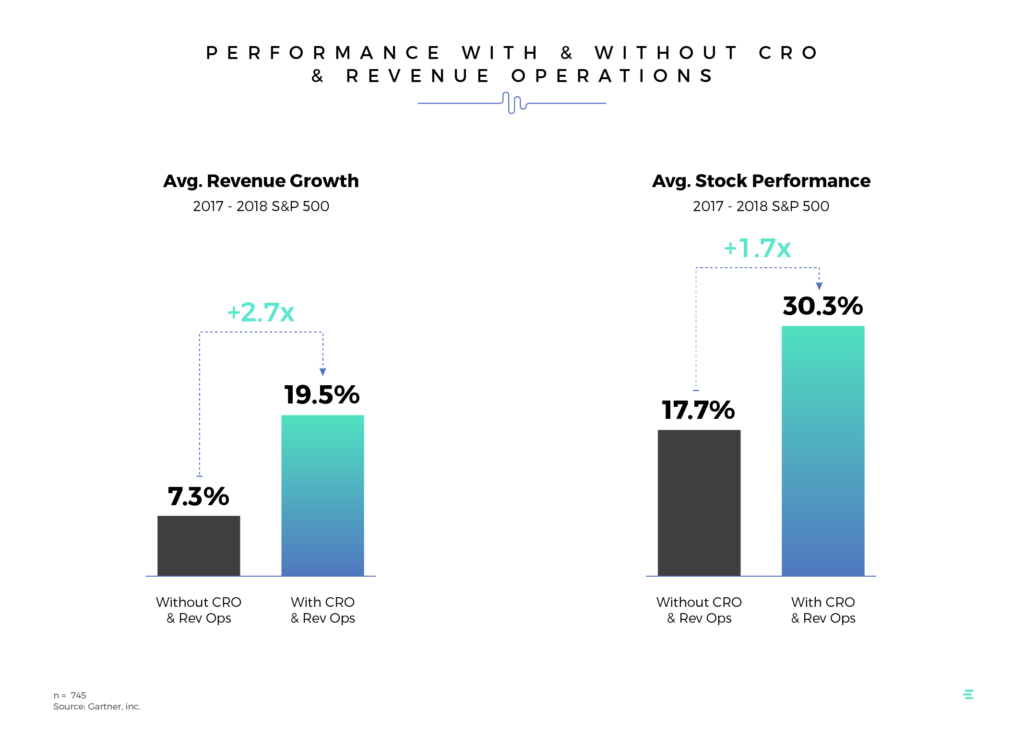
The internal org structure of brands makes a big difference in their average revenue growth and average stock performance. In both categories, companies with a CRO and established RevOps department saw significantly better results than those without. Findings like this are probably not going away any time soon. The gap between brands with RevOps and brands without will only grow larger with time. Whether executives like it or not, revenue operations is the new organizing principle of effective sales models.
If you aren’t pursuing a RevOps model yet, it’s a good time to start seriously thinking about it.
But, I get it. Building a revenue operations infrastructure can be extremely difficult. According to recent data, 45% of surveyed brands reported that they do not have a current RevOps team, while a little over 15% are in the process of building one. The biggest issues C-suite decision-makers face are not knowing how to start the RevOps development process and failing to build an effective revenue operations structure.
The Old World model of siloed sales, services and marketing departments is rapidly disappearing. An over-encompassing RevOps model that views each team’s efforts as part of a collective CX experience is key to how future brands will make their mark on the world. Instead, data sharing, transparent communication and customer-centric strategy are the new norm.
Say goodbye to Don Draper and his associates. RevOps is the new Mad Men of the twenty-first century. I have included a longer version of the above graphics for your perusal at the end of this post. I encourage you to study these growth stages and self-reflect on where your company may be on the path to revenue ops at this very moment. But, the first step towards running a marathon is knowing where your starting line is. Before you can do anything else, you must know what needs to be done to build a sustainable RevOps infrastructure for your brand.
Growth naturally occurs as brands creep closer to achieving true revenue ops alignment and become better in sync with customer needs and expectations. Sustained revenue streams — accelerated or otherwise — cannot happen without a laser-like focus on customer experience. Here’s why that is the case.
Emphasizing Customer Experience in a Revenue Operations to Revenue Acceleration Framework
The biggest issue with the many definitions of revenue acceleration I have seen over the past few years is that they trivialize and oversimplify a very complex business problem, especially considering that the underlying variable to revenue acceleration — human decision-making — is anything but simple.
If done wrong, accelerating revenue can easily become a brand’s overarching goal, rather than a nice byproduct to a customer-led purchase experience.
Automation spits out algorithms that can potentially make each buyer a data point, optimizing “experiences” without a human mind behind the scenes actually interpreting what that means. By our very nature, people create cognitive associations with brands based on experiences with and perceptions of the purchase process. This 360-degree associative loop feeds into employees’ cognitive relationship with the brand they represent, reinforcing the customer perspective. See a more in-depth visual of this process here:
Customers are not robots; they can sense when companies elevate their credit cards over their individual wants, emotional states and product attachments. Although they might buy something while hating the purchase process, there is a strong chance that they will never return.
Successful and sustainable revenue acceleration is the DIRECT effect of a brand’s overall ability to orchestrate an incredibly insightful loyalty-to-purchase loop and a phenomenal purchase-to-loyalty customer journey.
If you’ve gotten this far in this post, I’d humbly ask you to read that sentence again and try not to overcomplicate or oversimplify its intent.
RocketSource can humbly and proudly boast a client retention rate north of 90% — and it’s no fluke. Where others talk the talk, we are actively building competitive moats for our clients where it’ll take more than a great new product or quarter on Wall Street to dislodge that competitive brand experience advantage. Let’s face it — in our era of digital technology and insights-driven strategies, it is easy to lose sight of this fundamental truth: that the underlying human behaviors present in the bustling Greek agorae and Roman forums of the ancient world are still driving twenty-first century commerce. It’s just easier to miss them when you’re divided by a screen.
Failing to Achieve Revenue Acceleration via a Revenue Operations Framework
Knowing the importance of good CX in getting to sustained revenue acceleration, why do so many brands fail at achieving it? The answer is complicated but generally comes down to misalignments within a company’s 3Ps — people, platforms and processes. Ideally, the relationship between these three entities looks something like this:
Unfortunately, the reality is rarely this clear-cut. Typically, alignment along the 3 Ps is a much more chaotic affair that can have severe repercussions on a company’s bottom line. An error that organizations make — and the one I want to focus on here — is an over-reliance on new technology that promises to make these alignment issues magically “disappear.”
Silver Bullet Solutions Fail to Build Revenue Operations
Remember those vampire stories where the heroes (rather conveniently) kill evil bloodsuckers with a silver bullet or wooden stake through the heart?
Man, it would sure be nice if fixing organizational alignment problems looked as cool as Buffy with a stake.
Often, organizations problematically ascribe to what I call the silver bullet thinking when it comes to adopting new, fancy platforms. Now don’t get me wrong; there are a plethora of reasons to onboard new platforms (and as we go through this post, I’ll even explain why some of them are necessary to accelerate revenue). Digital adoption statistics have found that brands with intelligent data collection and analysis are 23 times more likely to acquire new customers than those without. With all the moving pieces of modern advertising, relying on a digital platform to accurately aggregate and track customer behavior is a must.
However, believing that a new system will solve all your CX and EX woes is a very big mistake. BCG found that increasing odds of success in digital transformation depends on the presence of six identifying characteristics at the time of adoption:
- Deploying High Caliber Talent
- Effective Monitoring of Progress Toward Defined Outcomes
- Business-Led Modular Technology and Data Platform
- An Integrated Strategy with Clear Transformation Goals
- An Agile Governance Mindset that Drives Broader Adoption
- Leadership Commitment from CEO through Middle Management
In short, all six factors fall under people, platform and process initiatives. Similarly, the more of these characteristics your brand has — even if it doesn’t have all of them at once — the better success rates you tend to see.
A particular problem to highlight is the lack of value some companies place on employees’ onboarding and use of new tech. Digital adoption mistakes that threaten employee performance can lead to disaster. Brands often pay a new vendor thousands and thousands of dollars to implement a new all-encompassing tech “solution.” However, if these platforms are not easy to learn and use, rushed during implementation, bad at providing technical support, and unclear on the benefits they can offer employees, the people side of the equation will implode. Again, this is just one example of ways a haphazard surge toward customer experience improvement can alienate employees without the necessary training and strategy to succeed.
No employee buy-in means no revenue acceleration. End of story.
Internal alignment is tantamount to success or failure. Particularly, making sure that your 3 Ps are aligned with each other and emit consistent messages to your customer base is key to any sustainable financial growth. One of the best ways to think about this process is to envision your business transformation journey as a set of increasingly complex layers, like so (and this is just the Business side of StoryVesting):
Strategic internal alignment produces successful external outcomes, and revenue acceleration rarely can be achieved without this foundation.
Timing is Everything in Accelerating Revenue via a Revenue Operations Framework
Timing is critical when it comes to revenue acceleration for several reasons.
First, hitting customers in the right part of the funnel at the right time and with the right content is key. This knowledge has become fairly intuitive in the marketing world. Customers don’t like getting outreach emails when they have already purchased a product, and shoppers expect tailored messages that make sense wherever they are in the purchase process.
The second and more difficult point is knowing whether or not your business should pursue revenue acceleration as a goal. Again, this knowledge is incredibly tough to obtain and subsequently unpack. Brands have so many competing internal objectives: keeping retention high, measuring CAC, increasing ROI, improving time-on-site, etc.
The biggest bummer is that, sometimes, accelerating revenue can hurt your brand’s progress toward achieving certain goals. This doesn’t mean that your company can never pursue revenue acceleration, but it does mean that you need to understand when and in what circumstances this strategy is appropriate.
And that’s hard to figure out. Really hard.
Although this post will help break down some of the ways you can start this discovery process, you may need some outside help to get fresh eyes on your data and processes. Here’s my shameless plug: RocketSource is all about figuring this kind of stuff out. Just like this post, our team approaches brands with an understanding that business is complex, employees’ emotions play a huge role in financial success, and customers have expectations and wants that are ever-shifting and hard to identify.
I hate to break it to you but there just isn’t a silver bullet solution.
Problem-Solving CX Pain Points in a Revenue Operations to Revenue Acceleration Framework
At this point, you might be having some of the following thoughts:
- “Geez, there seems to be a lot more to revenue acceleration than I imagined.”
- “How the hell do I even begin tackling some of these complex problems?”
- “How do I know if I should pursue a revenue operations framework for my brand?”
- “How does this guy have so much to say on two measly little words?!?“
This is where a problem-solving framework comes in handy. Allow me to unpack the problem-solving framework I developed over years of consulting and product development. There are hundreds of strategies that can successfully guide you and your organization in decision-making, but StoryVesting is one that I have found extremely successful in identifying and solving complex CX problems. Data, channels and platforms relevant to the revenue ops world are so complex that failing to rely on tried-and-true problem-solving frameworks puts you at a severe disadvantage.
Think of the customer experience as a minefield: one misstep, and all the progress you made attracting and cultivating this consumer to your brand is gone in an instant.
Read on for more insight into how problem-solving frameworks — specifically, StoryVesting — are critical to keeping the proverbial people, platforms and process bombs from destroying your customers’ purchase journey.
Using StoryVesting in a Revenue Operations to Revenue Acceleration Framework
StoryVesting is my proprietary problem-solving framework that can most certainly be used to streamline and sustain revenue ops initiatives. But before we get into all that, I want to paint a picture for you.
Imagine that you’re sitting on the shores of a lake. The morning sun is creeping over the horizon. Birds are chirping in the trees behind you. You breathe in the crisp morning air, feeling that everything is right with the world. Wind in the trees…sun on your skin…grass under your fingers…
A splash on the lake?
Suddenly, a rock interrupts the stillness of the water, landing with a splash that makes you jump. You watch as ripples move outward from where rock met water, marveling at how these concentric circles expand to encompass the surrounding area. Time slows down, and you can see — really see — the connection between the rock’s entry point and the ever-growing layers of movement encircling it.
Although you’re probably sitting in front of your phone or computer screen instead of a lake right now, I want you to try to hold the image of these ripples in your mind as much as possible.
I use this story not only as an a-ha moment for me to graphically depict the StoryVesting layers via concentric circles but to demonstrate the way companies need to think about the complexities of building a brand that aligns with their customers’ expectations and transforms their internal people, processes and platforms (for a more in-depth analysis, see my previous post on successful business people, process and platforms strategies).
Like the stillness of that imagined lake, your customers’ experience needs to be flawless, from the initial point of entry to post-purchase interactions. Seeing your brand as having a ripple effect that touches and connects with every aspect of your business is key to accelerating revenue and thriving in the modern marketplace.
Remember, StoryVesting moves from the first concentric circle of Why to the outermost circle of Experience. It’s a ripple of energy in motion traversing across emotional and logical triggers and connections that overlap one another just like the previous ripple of water.
Here’s one caveat that I will repeat multiple times in this post. Revenue acceleration may not be the best answer to solving your particular audience’s pain points. To build a robust, self-maintaining revenue stream, you must understand when and how to accelerate each piece of the bowtie funnel, from acquisitions to conversions and back to retention.
Word of warning: getting to revenue acceleration is not for the faint of heart.
It’s not as easy as snapping your fingers and manifesting a new automated marketing tool to do your work. I’ve seen companies take this approach, and it never works out. These brands lack an intimate understanding of creating sustained momentum for their particular market audience. They aren’t using the thousands of data points at their fingertips to make intelligent decisions that grow customer satisfaction.
Ultimately, they aren’t asking the right questions; they aren’t focused on the ultimate end in mind for their brand and business model. So what happens when you do lead with the end in mind? Well, let’s find out.
Starting with the End in Mind in a RevOps to Revenue Acceleration Framework
Revenue acceleration can be accomplished in a lot of different ways. At its core, though, is to start with the end in mind by mitigating friction and blocking points in the funnel. This can be done by thinking of user experiences, user interfaces, and other technological advances that can help spur momentum toward revenue creation. Effectively, the net result is transforming the conversion funnel into a virtuous feedback loop based on a full customer view across all functions and all departments.
Customer satisfaction is ultimately the end-all, be-all factor contributing to the success of any business. The customer has to have the best purchase experience possible. When the experience is outstanding, revenue acceleration will happen. If the experience is subpar, then…well, let’s just say no miraculous AI platform will sweep in and save the day.
Back to the ripple analogy, companies accelerate revenue best when they capitalize on the momentum created from all parts of the purchase process. This is why it’s so important to place and keep your ducks in a row (pond pun intended) when it comes to all sales funnel phases.
Positive customer experiences, vested employees, and relevant, valuable content, along with a plethora of other factors as can be seen in the graphic of our customer insights map below, can all have multiplier effects on your ability to accelerate revenue. Like ripples in water, every piece of your marketing, sales and customer success strategy can and should build on each other to create exponentially widening revenue streams.
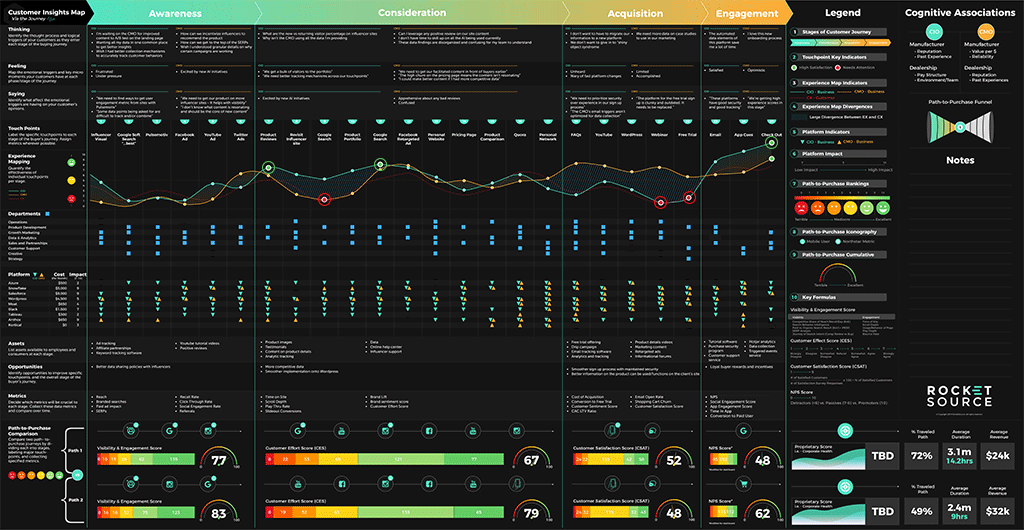
How, then, do you create this momentum? How do you rewind the ripples to their origin point and figure out what got them moving in the first place? I know I’m beating a dead horse here, but you have to start with the end in mind. The ultimate goal of any company trying to achieve revenue acceleration should be to identify why customers stay loyal to their product line and their brand. In past posts, I have often talked about this idea. It is difficult to overstate the importance of intelligent data collection and analysis to determine ongoing customer loyalty.
Identifying what I call the why — the reason brands retain customers, the reason shoppers continue buying products or extolling the brand’s virtues to their friends — is key to creating and sustaining an infrastructure that can support revenue acceleration.
Finding your company’s “why they stay” is how to start with the end in mind.
Once you know why your brand retains customers, you can start to build around that core motivation. Eventually, if done right, automation and systematic marketing can be introduced to accelerate customers’ movements within the bow-tie funnel, an iterative feedback loop that leads to faster revenue streams. Creating this feedback loop can ultimately be done with the strategic and intelligent application of revenue intelligence data.
Understanding Revenue Intelligence when Developing a RevOps to Revenue Acceleration Framework
Simply put, revenue intelligence is about understanding the motion and mechanics of your revenue operations. Revenue ops combine the entire bowtie funnel from net new purchases to upsells post-purchase.
New Breed+ has a good definition of this idea: “Revenue optimization is the management of acquisition, retention, and expansion strategies to improve revenue health and durability. It’s about building a plan to generate revenue from every corner of your business that is focused on bringing in truly good-fit customers, growing with them in the long-term and building a healthy customer base optimized for revenue growth.”
“Revenue intelligence is the practice of gathering customer data across all revenue-focused departments and turning them into actionable insights to accelerate revenue.” — Breadcrumbs.io
As with any smart business strategy that I preach, revenue intelligence aims to address pain points in the bow tie funnel and create amazing customer experiences. There’s a lot more to this concept, but suffice it to say, if you don’t know how to intelligently manage and align the acquisitions, conversions, and retention pieces of your sales process, you shouldn’t be thinking about revenue acceleration right now.
Luckily, the team at RocketSource specializes in data capture and analysis, which are key stepping stones to figuring out revenue intelligence for your company. We solve these tricky revenue intelligence equations via the StoryVesting framework, a topic I now want to touch on in more depth.
Leveraging StoryVesting, Part I: Creating Stories to Drive Revenue Acceleration within a Revenue Operations Framework
You need an agile, problem-solving framework to begin stacking the dominoes in your brand’s favor. If you’re new to the RocketSource blog, you can learn more about business transformation through StoryVesting in a previous article, but here’s a brief recap.
StoryVesting is a research-based methodology I developed to help me navigate the many paradigmatic shifts in the S Curve of Business. I have used it in both my own enterprises and as a problem-solving framework for the many clients I have worked with over the years. The framework has been highly successful in helping navigate everything from Product/Market Fit to complete digital transformation. I also commonly refer to StoryVesting as the why framework.
Using StoryVesting to Navigate Strategic Inflection Points in a Revenue Operations to Revenue Acceleration Framework
Early on in my career, I realized that businesses encounter strategic inflection points — key shifts that require companies to “adapt or die” — roughly every two years, a vast increase in frequency from the days before the digital revolution. How well companies navigate these periods of change directly reflects their eventual long-term success as a brand (there will be a more in-depth discussion of this process in a later section).
Simplistically, there are really only three ways a brand facing a strategic inflection point can go:
StoryVesting is the result of my years-long investigation into how businesses can best navigate these inflection points. I wanted the companies I worked with to not just survive, but financially thrive through the harnessing of an empathetic, insights-driven alignment of internal and external human-centered behaviors caused by an emotional and logical ripple effect.
And the explanation of this ripple effect — the momentum that gets customers excited and employees vested in your product offerings — relies on human psychology, a science that taps into the thoughts and feelings that lead people to behave in certain ways. Combined with behavioral economics, a method of economic analysis that applies psychological insights into human behavior to explain economic decision-making, StoryVesting can look something like this:
As a business owner, if you understand why customers purchase from and, more importantly, stay with your brand, you can approach problem-solving empathetically and customer-centric. Although I often advise clients to use more traditional consultation frameworks, I firmly believe that StoryVesting is the best way to create sustainable revenue streams no matter your organization’s specific pain points.
StoryVesting comprises two concepts that I think are key to guiding companies in the modern marketplace. I will touch on them briefly here, but to get the full explanation — and the reasons I designed this framework to begin with — check out my post on how to use StoryVesting to achieve business transformation.
The first piece to understanding this framework is identifying brand “stories.” Think of these stories not as knights killing dragons and rescuing damsels in distress but as the reason — or more importantly, the why — customers stay with a brand long-term.
Consumers are human beings, which means they run on connections between the brain’s neocortex system (the Logical Response Center) and the limbic system (the Emotional Response Center). To quickly summarize hundreds of psychological research studies in one sentence, the connection between these two systems is what impacts the worldview of human beings and, most importantly, their feelings towards that worldview.
Or, how a particularly clever Association for Psychological Science article put it, it’s the phenomenon of “when clothing style influences cognitive style.” And you better believe that this connection fires like crazy when it comes to purchase decisions and the emotions shoppers feel towards your brand.
The limbic system naturally makes cognitive associations between seemingly unrelated items in humans. These associations stick in the brain because of their connection to emotional states. One person’s fear when seeing a dog running loose in the neighborhood — an emotion perhaps generated from the negative experience of being bitten — sharply contrasts with another’s excitement at seeing a fluffy, floppy puppy running toward them. The same experience elicits two very different emotional reactions, directly resulting from the different ways cognitive associations are created.
So what does this mean for companies?
Just like puppies, brands also become cognitively associated with various emotions. It is in a company’s best interest to tap into the emotional states that align with its core mission. And one way to do this is by creating a solid revenue operations model in your company.
To come full circle here, a company’s why — or the story — needs to generate a corresponding emotion in consumers to create lasting significance in their lives. The better these missions align with customers’ emotional expectations, the stronger the cognitive association. Brand stories create customer certainty in purchasing decisions, leading to a healthier bottom line overall.
Leveraging StoryVesting, Part II: Getting Vested Employees + Consumers To Further Drive Revenue Acceleration
A pivotal piece of StoryVesting focuses on something many businesses don’t think enough about — employee experience. Like customers, employees always have a why rooted in an emotional association with their workplace. These reasons for staying can vary widely. A CFO may stay because of the brand’s international humanitarian efforts. A salesperson may stay just to get a steady paycheck.
Understanding that all employees have a why — and sometimes ones completely different from their coworkers’ —allows you to start identifying the underlying emotions that motivate your workforce.
Just as on the CX side, an intimate knowledge of what makes your employees tick regarding your brand can help you create vested individuals. Vested employees are those who not only align with your customer-facing brand story but ones that tap into its emotional resonance in every interaction with purchasers. They are the kind of loyal souls that would work for entry-level wages just to be associated with the brand (think Apple Store or Disneyland employees). Marketing your story becomes exponentially easier when you have 100% buy-in from employees on new customer-centric processes and platforms.
As the public faces of your business, vested employees are a must before you can even begin to think about revenue acceleration.
Utilizing StoryVesting as a CX-based framework helps align the emotional experiences of customers and employees. If these two stories can become one, that’s when the magic really starts happening.
I talk much more about this concept and the importance of hiring the right people (growth mindsets anyone?) in other posts, but this summary provides enough basis to get to the meat of my argument about revenue acceleration. In short, momentum is created when everything that encapsulates your brand — from messaging, employee buy-in, customer satisfaction, and the laundry list of other things that lead to cognitive associations based on experiences — comes together flawlessly.
StoryVesting is the most successful framework I have found to piece the jigsaw puzzle of revenue operations together. And once you know your story, you can really start with the end in mind and build a sustainable infrastructure to support revenue acceleration.
You’re probably saying, “OK, Buckley, this is a nice monologue. But does StoryVesting or some other problem-solving framework like it actually work when using it to develop a RevOps strategy?”
Why yes, dear reader. Yes, it does. And I’ll show you how.
Creating Vested Employees + Consumers with Innovative Problem-Solving in a Revenue Operations Framework
Regarding revenue acceleration, the StoryVesting framework works best as a methodology for business transformation, specifically one geared towards a CX-based, experiential business model. Using StoryVesting, brands can move beyond the transactional business model and create an infrastructure made up of “experience layers.” These layers then provide a foundation for initiatives like revenue acceleration.
Here’s the harsh truth: If you continue to compete on just the transactional level, you will fail at accelerating revenue.
I don’t care what products you advertise; even if sales seem consistent now, the neglect in building a customer-first foundation will catch up with you eventually. At the very least, your company will not be able to support revenue acceleration in any sort of long-term way. This is why a problem-solving framework like StoryVesting is so important. Approaching snags in the bow-tie funnel with a customer-centric mindset inherently sets your brand on the path toward long-term financial success.
And again, there are many, many problem-solving frameworks out there. StoryVesting happens to be the one I like best. However, there have been hundreds of brand stories that reflect the financial success of other methodologies. Here are two examples of brands that have accelerated revenue streams by creating fresh, innovative business models via creative problem-solving.
How Dell Drove Revenue Acceleration with Vested Employees
I remember clearly when Dell came out of the gates and transformed the supply chain, but had little insight (until much later) about how they managed their growth and scale and their revenue operations.
When Michael Dell grew his company rapidly, he reached an enviable point in the mid-90s when he started running out of cash to fund growth. Like so many other companies scaling quickly, he was essentially going broke. Yeah, I know…we wish we all had this problem.
But here’s the thing. He brought in an amazing CFO that focused on analyzing the Cash Conversion Cycle (CCC). Today, much of that analysis falls on the Chief Revenue Officer managing revenue operations to accelerate revenue. At any rate, after CFO-extraordinaire Tom Meredith analyzed the financials, he came up with a CCC of 63 days. Not horrible, but not great either. That meant it took 63 days from when Dell spent a dollar until it flowed back through the business as cash on the books (and ultimately cash in the bank account).
By the way, for those who want to know, the formula for the Cash Conversion Cycle is:
CCC = Days of Sales Outstanding PLUS Days of Inventory Outstanding MINUS Days of Payables Outstanding
or
CCC = DSO + DIO – DPO
The entire CCC is often referred to as the Net Operating Cycle. It is “net” because it subtracts the number of days of payables the company has outstanding from the Operating Cycle. The logic behind this is that payables are really viewed as a source of operating cash or working capital for the company. By contrast, receivables, or cash the company has not received yet, decreases working capital available to the company to finance operations. CCC analysis is often wielded to enhance cash acceleration at the CFO/finance level, but it can also be utilized at the CRO level to help build or improve revenue acceleration strategies at the marketing and sales level (i.e. Self-Service, SaaS, Extended Funnel Improvement, etc).
Meredith decided that upgrading the cash flow at Dell was the best way to support company initiatives. Focusing on one cash improvement strategy every 90 days, he drove the CCC to a whopping negative 21 days a decade after his arrival.
Think about that for a second and let that settle in. This meant the company received capital before spending it. And as Dell scaled, it turned from a cash-consuming business to a cash-generation business which fostered its growth. Talk about acceleration of revenue (er…cash).
Now, I realize that not every business can have a negative CCC (their business model or pricing model just doesn’t support it), but my hope is that you can see how a problem-solving framework like StoryVesting can lead to experimentation and innovative thinking in regards to resolving revenue acceleration and growth blockers. Dell’s transformation is a prime example of a company adapting to changing market forces and using data to think outside the box to solve issues.
How Logan Paul Created Vested Customers to Drive Revenue Acceleration
In the era of crowdsourcing, the momentum created directly out of consumer engagement can be an extremely powerful way to address problems in the digital experience economy. Specifically, to compete against the noise of YouTube creators, streamers, and Tik Tok videos, the word-of-mouth coefficient has been a great tool for those personalities skilled at wielding it. Social media influencers — Logan Paul foremost among them — are experts at this, even if they aren’t looking for the same things a product-led organization would be.
Logan Paul’s 2021 exhibition fight against Floyd Mayweather is an excellent example of leveraging word-of-mouth via social media.
Paul initially attained fame on the now defunct Vine platform. Mobilizing his digital support base, Paul leaned into the nPower coefficient principle, which led to huge public interest and an eventual multi-million dollar deal to fight the most successful boxer on the planet. In fact, digital word-of-mouth worked so well that Showtime, the platform server offering pay-per-view purchases of the fight, crashed, leaving thousands of paying customers in the literal dark.
Talk about a punch to the gut. Ouch.
Even with all his digital brouhaha, Paul tapped into an age-old truth about the human mind: people love stories. Paul’s fight against Mayweather was, if not anything else, a great story: amateur loud-mouth gets the attention of the world’s biggest and baddest fighter. A grassroots David and Goliath…if David was a snarky twenty-something millennial brat.
When it came to his brand, Paul understood that the exponential power of the way his story was told in a digital setting was critical. Social media and online reviews amplified any press he received. By generating hype and positioning himself as a grassroots contender of Mayweather, Paul literally elevated himself to the big leagues. And although I’d wager most of this post’s readers are not in the influencer space, his success here is illustrative of a very basic truth in the digital economy: you desperately need positive gossip about your brand.
Sometimes, one of the simplest problem-solving strategies is to do something incredibly basic — ensure that you are capturing the positive sentiment of your buyers and leveraging it to create new ones. One misstep in the online reputation space (compounded with one particularly disgruntled customer) can literally undo decades of television commercials, billboards, and radio ads touting a brand. This is why building a revenue operations infrastructure intended to provide the very best customer experience possible is so important in the digital marketplace.
Good CX leads to good word-of-mouth, and when you adhere to that mantra, the digital market square of review-land will take care of itself.
And most importantly, adapting to negative customer feedback and remaining rooted in exceptional customer experiences is key to aligning revenue ops and building a foundation for revenue acceleration.
Revenue Acceleration in a Revenue Operations Framework Works With Vested Employees + Customers
As the Dell and Paul case examples demonstrate, any brand can achieve incremental financial success by tinkering with pricing models, business models, and marketing ops. It really comes down to how and where you present your why to the world.
A huge mistake I see brands make all the time is not adapting well or quickly enough to this experience-first model. In my many years of consulting work, the moment of purchase (aka conversion) is the step where I see companies either succeed or fail spectacularly in customer retention. It is at this point when buyers experience an emotional reckoning of their purchase decision: excitement for deciding to buy and a split-second of fear that the product won’t be worth the investment.
The experience at this part in the bow-tie funnel determines whether the customer feels reassurance or doubt about their purchase decision. Past, present, and future feelings about the purchase process coalesce into one overarching experience, one that directly impacts how buyers feel about your brand long-term. Tell your story in a way twenty-first century customers expect; speak the language of innovation, creative problem-solving, and empathetic customer experience initiatives. Because once you do, revenue acceleration suddenly becomes a lot more feasible.
As reiterated many times in this post, having a well-thought-out RevOps structure and strategy is an absolute requirement for brands serious about accelerating revenue. We’ve talked at length about the changes in consumer behavior that led to RevOps development and the integral connection between it and revenue acceleration.
Now, let’s talk specifically about how you can move your brand closer towards a revenue optimization model.
Analyzing RevOps: Building an Infrastructure for Revenue Acceleration
Ok here we go. It’s time for a more in-depth look at ways your company can creep towards a comprehensive revenue ops strategy and, ideally, create a coordinated team of vested individuals.
Brief recap of what RevOps means: Forrester defines revenue operations as “made up of sales operations, marketing operations, and customer success operations teams that work together in accordance with a set of operating principles that align planning, processes, technology, data, and measurement that help organizations maximize revenue and performance.”
Put simply, a good revenue ops infrastructure allows you to see both the forest and the trees when it comes to data collection and analysis. And the proof is in the pudding. Forrester also found that brands leveraging their revenue operations and CMOs together grew three times faster than similar organizations and were the best positioned to financially prosper in the next three to five years.
What Forrester doesn’t say is that companies that fail to develop a revenue ops plan risk getting left behind by more savvy competitors. So let’s make sure you’re not in that category, shall we?
Internal Alignment within a Revenue Operations Model
If you’re unsure where to start revamping your organization for RevOps, internal alignment is a good place. The old method of trying to manage a sales funnel via siloed information is desperately outdated. No longer can the marketing team have access to databases that sales know nothing about, and vice versa. Developing a strong revenue ops strategy is to streamline inter-departmental processes and adopt technology (CDPs are great tools for this, but more on that later) that can combine customer touch points from all parts of the bow-tie funnel.
There is good justification for unifying data streams in this manner. Gartner reported that sales operations increased their teams’ portfolios by an average of 2.3% with more frequent and holistic data analysis. Over 54% of companies named siloed data as the primary reason for lacking an integrated view of the state of the customer journey in 2019.
Based on these findings, it is clear that data aggregation and analysis have a great impact on achieving North Star Metrics and revenue acceleration. The plethora of ways customers interact with your brand before even speaking with a human representative is overwhelming, and revenue operations is one team that can help make sense of this data.
Internal alignment also helps streamline processes and increase efficiency. Both improvements significantly help a company’s chances of successfully accelerating revenue in a sustainable way. Xant recently wrote about some interesting sales effectiveness metrics; its study found that the typical day in the life of a sales team member, when broken into percentages of time spent on categorized activities, consists of the following:
- 12% of their time on internal processes.
- Almost 16% of their time on meetings and customer interaction.
- 18% of their time in the CRM tool.
These findings mean that many sales reps’ days do not translate to any meaningful form of revenue. Think about that for a second. Your sales force — the people hired to specifically acquire and convert leads — spend most of their time on tasks that don’t help them accomplish either one of those goals. This inefficiency directly translates to lost income and compresses the bow-tie funnel to a trickle of its potential.
Although simplistic on the surface, there are several very clear benefits to internal alignment under a revenue ops model. The graphic below spotlights just a few examples.
Clari describes the rise of revenue operations as a “fast emerging…solution to the traditionally siloed team structure, where teams move away from wasted time, finger pointing, inaccurate forecasts, and a lone wolf mentality to insights-driven collaboration, full-funnel accountability, predictable business growth and faster sales cycles.” Bringing previous “lone wolf” departments into an aligned, cohesive revenue ops structure is, without a doubt, the first step towards getting to revenue acceleration.
Product-based companies, in particular, need to jump on the revenue operations bandwagon to stay relevant. The ability to segment customers into cohorts and develop go-to-market (GTM) strategies hinges on having aligned sales and marketing departments. Some case studies show that marketing ROI and sales productivity both receive substantial boosts from adopting revenue ops (200% increase in ROI and 20% increase in productivity), which really revs up go-to-market operations in B2B. Although I firmly believe that all industries can benefit from a better revenue operations strategy, product-first marketing seems to see the most obvious immediate results.
Ultimately, revenue ops alignment sets the stage for your brand to share and report more transparent and consistent metrics that lead to better problem-solving and overarching strategies as a whole.
Increased Accountability and Transparency in Revenue Ops Leads to Revenue Acceleration
A nice byproduct of improved internal alignment — and another solid strategy for getting to RevOps in general — is increased transparency across departments. By aligning internal departments, revenue operations fosters better accountability between the marketing, sales, and retention teams.
As threatening as this may initially feel to department heads, all parts of the revenue ops team need to claim accountability for failed or unprofitable endeavors. This is the only way that brands can continue to improve the customer purchase experience. Uncomfortable conversations will probably need to happen, but they can be approached in a way that positions mistakes as opportunities for revenue ops to address in future initiatives.
To make these discussions worthwhile, you need to ensure that all teams are on the same page with data aggregation and analysis.
One of the biggest revenue operations mistakes brands make is expecting ill-equipped sales, marketing, and customer success teams to intelligently predict how strategies may affect results down the line. Measurable and meaningful goals that all departments can work towards need to be established, enforceable, and reportable. This process is made exponentially simpler when organizations adopt CDP software and other digital tools to help automate portions of the bow-tie funnel. Revenue ops can help ensure that all teams are aligned regarding goals and heighten the likelihood that brands will successfully create and sustain revenue acceleration.
One important note to make here is that the CMO needs to have a prominent seat at the table in any revenue ops conversations. Lots of opinion pieces exist that claim the future of revenue operations and sales enablement doesn’t leave room for traditional marketing functions anymore. I strongly disagree with this perspective.
Revenue operations and CMOs need each other more than ever before. It simply doesn’t make sense to evaluate revenue operations goals without giving equal credence to sales, customer success, and marketing. In many ways, revenue ops may not be living up to their full potential due to this stifled thinking about marketing’s role. If anything, CROs must learn to fluently speak the language of sales ops, marketers, and customer success reps. If you’ve ever been on one side of the fence or the other, you know is easier said than done.
Having access to the same data streams at least sets the stage for an open dialogue in which everybody has an equal seat at the table — regardless of former inter-departmental alliances or corner-office rivalries.
Rather than back-biting competition, executive leadership must encourage cooperation and collaboration amongst its management teams. The goal of internal alignment within revenue ops is to increase revenue by catering to customer expectations and smoothing out pain points — not pitting various departments against each other. Through honest and forthright data sharing and initiatives tracking, revenue operations strategies can cut through the petty squabbles and meaningless debates on the corporate level and create a positive environment for increased accountability.
An Aligned Revenue Operations Model Solves Customer-Journey Pain Points
Once your teams are better aligned and more transparent, you can start leveraging your new revenue operations set up to identify and address pain points throughout the customer purchase journey. The surest way to get to outstanding CX is by leveraging data repositories and using them to address funnel hiccups in a coordinated internal effort. Revenue Ops provides the infrastructure for strategic data analysis and overarching initiatives emphasizing customer experience.
Yep, that’s right. This is the part where we finally talk about how to leverage RevOps for customer-centric, revenue acceleration strategies.
About time, Buck…yeesh.
To accomplish CX-driven initiatives, CROs must ensure consistency in goal tracking and achievement. It seems obvious, but many companies with siloed departments struggle with this concept. For example, the CEO might see retention and increased LTV as the biggest metric to improve while the sales department continues to preach conversion, conversion, conversion at the expense of customer experience. Those two value systems clash if they aren’t in alignment with each other and lead to stalemates when evaluating campaign results.
Why is it important to ensure goals are aligned cross-department? Because your customer isn’t the same as they were five years ago.
We’ve already covered many of the economic and technological changes that have led to a more empowered consumer base in some depth, but here is a handy-dandy chart listing all the ways shoppers are more in the driver’s seat than ever before.
This shift in consumer behavior means you have to start speaking to customers in a different way, which includes putting a much higher emphasis on the problems customers face throughout the purchase process. Intelligent data gathering and analysis provides evidence for potential customer pain points. If you notice online shoppers bouncing at a significant rate away from your checkout page, you have a place to start unpacking this behavior. Often, companies stop at this step. They note the bounce rate, and understand that it’s a problem but don’t necessarily know what needs to be done to fix the situation.
This is where your aligned revenue ops team comes in.
By merging data sources from various funnel points, brands can get a 360-degree view of the customer experience. Perhaps you find from analyzing conversion data that a specific support rep tends to frustrate customers when they have questions during checkout. Maybe you notice that your product listings screen takes five minutes just to load — an unforgiving amount of time in the digital space. Regardless, having more data (and interdepartmental minds) at your fingertips can better help streamline the purchase process and create excellent customer experiences.
Ultimately, having a solid revenue ops infrastructure provides sharp data insight and promotes innovative problem-solving. It all comes down to how well internal people, processes and platforms align under the revenue operations umbrella. Solid RevOps alignment also, not coincidentally, significantly improves retention rates. Let’s examine why this is the case.
A Revenue Operations Framework Accelerates Revenue and Increases Customer Retention
A retention strategy based on aligned, transparent, CX-centric RevOps data is another way to get the revenue acceleration ball rolling. The chances of retaining a customer grow exponentially with great customer service experiences. Typically, this ballooning LTV rate ensures more money down the road for you. Whether via referrals or repeat business, customers with a strong LTV can literally be the strongest single asset of any company.
Remember the word-of-mouth coefficient? Well, that phenomenon is definitely at play in online reviews and social media. Rather than simply instigating hype for a certain product or event, these customer ratings potentially have a much stronger, long-term, positive effect on your brand. In short, happy customers do advertising for you.
And marketing expenses don’t get much cheaper than that.
I have hammered on the irreplaceable importance of good CX many times in the past, but I want to particularly note how revenue operations in and of itself can directly lead to a better customer experience. Gartner did a great study on factors that influenced customer retention. The results are documented in this graphic:
It comes as no surprise that having a good product and/or service is the number one factor influencing retention. J.D. Power’s 2020 US automotive brand loyalty study found that Subaru leads in the mass-market category with a loyalty rate north of 60%. Buyers like Subarus because they are good cars; of course their retention rates are going to beat out competitors. The best product on the market typically wins. It’s a no-brainer.
The rest of the data in this chart is where things start to get interesting.
Aggressive selling decreases retention dramatically. I don’t think this finding comes as a surprise to many CEOs, but perhaps what is notable is the amount of negative change an “in-your-face” sales floor can have. Empowered consumers only want to speak with sales reps once they feel ready to buy. They want to control interactions with your conversion team, not be bombarded with stats and pitches they don’t find relevant anyway. And, even if these customers still buy after seller harassment, there is a slim to none chance that they will ever frequent your brand in the future.
You may have gained a sale in the short-term, but you have lost out on the advocacy value of a long-term, satisfied customer.
What really sticks out from Gartner’s study is how powerful customer improvement initiatives can be in the marketing world. Focusing on perfecting the customer journey increases retention almost as much as selling a great product does. And in some cases, improving processes that go into the customer journey is a much more realistic goal than completely revamping product offerings. Even for a mediocre offering, buyers will continue to shop at a business they feel treats them well and offers a seamless experience at every turn.
To create a solid financial foundation that will last for years into the future, you must have high retention rates. Using insights gleaned through a revenue ops model allows brands to troubleshoot customer pain points via problem-solving frameworks (i.e. StoryVesting). Happy customers open doors for businesses to get really aggressive in pursuing revenue acceleration.
And since you’ve stuck with me this long, I assume revenue acceleration is something you are really interested in pursuing.
A Revenue Operations Framework Allows for Revenue Acceleration
In short, revenue operations creates support for better alignment, accountability, and customer long-term value within brands.
Processes, people, and platforms in a good revenue operations model all come together to present consumers with a smooth facade on which to conduct business. The ultimate goal of revenue operations, then, is to get “predictable execution, predictable results, and predictable revenue.” Revenue ops strategies are the best way to attain this level of predictability and talk to customers in the right way and at the right time.
And, as I have stressed before, there is a chance that revenue acceleration may not be the best goal for you or your customer experience. To know for sure, though, getting your teams on the same page and having a unified, consistent approach to data collection and analysis is probably the best way to find out.
Getting to the “End in Mind”: Using a Revenue Operations Model to get to Revenue Acceleration
Here we are. Roughly halfway through the post.
In Middle Earth, we would be at the part where Frodo gets attacked by a giant spider. In a galaxy far, far away, Han Solo would be slowly descending into carbonite right about now. It’s the point in a story where the main characters encounter a turning point — the fiction world’s version of a strategic inflection point — and have to, for lack of a better term, adapt or die.
In our narrative on revenue acceleration, we also are at a turning point, one in which we will now stop setting the stage for revenue acceleration and actually start actively trying to get there. It’s time to take what we have learned so far and use it to develop a plan of action.
A plan of revenue acceleration.
Quick Recap: Revenue Acceleration Plans All Start With RevOps
You can’t drive revenue acceleration after the fact. It just won’t work. Having a realistic plan that aligns all relevant aspects of your business around the core principle of creating an extraordinary customer experience is pivotal to pursuing revenue acceleration in any sort of intelligent way.
Customer experience is not just a piece of revenue acceleration; it is the entire backbone.
Working with the end in mind — really focusing on why customers stay and how your purchase experience stands out from the competition — should be the number one goal of any organization. As stated in this post before, you cannot even begin to think about revenue acceleration if you don’t have this piece figured out. This knowledge will also help you decide whether revenue acceleration is even a good idea for your brand. If accelerating revenue conflicts with your North Star metric, don’t pursue it.
You cannot — I repeat, cannot — sacrifice good CX for a revenue acceleration strategy. In the long run, you will lose the salience of your why and be outcompeted by a brand that iterates and reacts to data feedback more quickly than you. The reason customers stay should always govern any future decisions that impact the bow-tie funnel.
Although B2C companies can certainly benefit from everything in this post, I want to specifically highlight how a move to a revenue operations model can help in revving up go-to-market operations in B2B. Top B2B tech companies that leaned on revenue ops to accelerate their growth experienced significant benefits, including 10% to 20% increases in sales productivity. The study also showed that tighter alignment between go-to-market teams resulted in:
- 100% to 200% increases in digital marketing ROI
- 10% increases in lead acceptance
- 15% to 20% increases in internal customer satisfaction
- 30% reductions in go-to-market expenses
If nothing else, internal alignment and a strong revenue ops model will help you cut costs and maximize profits. But how do you actually get to revenue acceleration under a RevOps-based infrastructure? How do you know when the dominoes are aligned in a way that best supports accelerating revenue for your individual brand?
Why, the same way we know everything, Pinky. Try to unpack our data!
Building Agile Customer Feedback Loops in a Revenue Operations Model
Before making any strategic decisions concerning revenue acceleration, you have to understand your data. This piece is so critical to brand success, and it’s often the part that companies think about the least. Like Julia Roberts says in Pretty Woman, that oversight is a big mistake.
Companies that skip over developing quick-response feedback loops based on solid and consistent data will fail to create customers with high LTV. However, brands that take the time to create and rely on a solid infrastructure are setting themselves up for future revenue acceleration. If it supports your North Star Metric, your organization can incorporate strategies that effectively accelerate the speed at which customers move through the bow-tie funnel.
Good data collection combined with an agile high-feedback loop process is key to ensuring a sustained, customer-first experience.
Building this infrastructure may require your business to drastically adapt its internal processes and platforms. Most likely, this development process would be a single step in your brand’s much larger move toward a revenue operations model. To understand why tech-enabled go-to-market innovation is critical for companies, you have to “invest in understanding your customer at a granular level” and “construct one source of truth for your selling data.” And getting to this single source of truth can be incredibly difficult.
Brutal, heart-wrenching decisions will probably have to be made. Maybe a dearly beloved platform or process currently in use by the sales team is just no longer relevant. Worse, maybe your Director of Marketing is just not the right person to help lead your company into the revenue optimization era. But these tough, tough, TOUGH decisions are worth the potential reward. Once you have successfully developed and maintained your “single data lake,” you suddenly have stepped into a world of new possibilities for improving brand experience and generating strong LTV scores.
You have entered the realm of cohort analytics.
Customer Cohort Analytics in a Revenue Operations to Revenue Acceleration Framework
It always amazes me when I speak with company execs that don’t use cohort analytics on a regular basis. In a world of ever increasing personalization as a result of data tracking and smart analytics, cohort analyses are one of the best ways to feasibly scale your mass marketing efforts towards individuation and tailored targeting. These goals are not only desirable in the modern marketplace, but increasingly critical for accelerating revenue successfully.
Cohort tracking offers a bird’s eye view of what is happening within your sales funnel. Unlike penniless graduate students who enter their programs in the same year, a cohort analysis allows you to lump customers together based on certain shopping characteristics. Although you can create cohorts based on gender, race, and income level, you can also divide shoppers based on which phase of the purchase process they are in. You can even go so granular as to identify “Monday afternoon” shoppers and examine how their online behavior is different from, say, “Tuesday morning” shoppers.
Like most good things in the business world, though, integrating cohort analytics into your business model doesn’t come free. In fact, getting quality data in large quantities typically means spending money and time that, quite honestly, many companies aren’t willing to do (more on this in the next section). But however you get there, being able to group your shoppers’ data into customer cohorts is an absolute must for any brand serious about pursuing revenue acceleration.
Let me explain why I believe this to be the case.
For those unfamiliar with what a cohort analysis visually looks like, I want to do a very surface-level overview of how to interpret cohort data once you have it. Cohort analysis deserves a post of its own, but for now, let’s briefly look at the following example:
First off, I want to note what the dates in the “App Launched” column represent. Essentially, the dates listed (from Jan. 25 to Feb. 3) showcase the days new users began utilizing the app in question. Each day has a slightly different number of new users, as we would expect from an app organically (or otherwise) gaining users.
On the horizontal axis, the cohort analysis maps the retention rates in the individual lifetime use of the people within each separate cohort. Moving from left to right, you can see how the initial app launch date (for example, Jan. 25) had 1,098 total users at the baseline 100% retained rate. As time passes and increasingly more users drop off the app, the retention rate dropped to 12.1% of the original 1,098 users by Day 10. This decrease obviously varies based on when the cohort in question first logged onto the app and the date range pulled for the chart.
Vertically, the visual graphs how retention rates as a whole performed cross-cohort and over time. This chart is particularly helpful in showing how retention rates are impacted due to specific marketing campaigns or business initiatives. Perhaps the relatively low number of new users on Feb. 1 reflects a pause in paid advertising directing customers to the app. Or, maybe the high Day 4 retention rate for the Jan. 26 cohort coincides with a sustained email drip strategy.
Regardless, you get the idea of how cohort analyses can be critical in mapping the direct effects business decisions have on your user base over time. The time piece is particularly key since brands can literally have numerical proof of external effects on usage rates as a result of intelligent, consistent cohort data aggregation.
The overall point of these cohort charts is to provide you with data to intelligently design specific and valuable marketing strategies based on tracked consumer behavior. Once you have the ability to drill down and analyze cohorts and how they differ from each other, you can start crafting more personalized marketing messages that hit customers at the right place and time in their purchase journey.
A great goal of cohort analytics (along with a plethora of other strategies and North Star metrics you can get out of this type of data analysis) is to ultimately create an iterative cycle of long-term consumer loyalty that moves shoppers seamlessly between the acquisition and retention phases. I like to use the following visual as an example of this feedback loop process:
Using the StoryVesting framework or others like it, brands can tap into the emotional to logical triggers of particular buyer cohorts and arrive at the underlying why for behavioral trends. Providing incremental positive experiences increases the chance that customers will move back into your acquisition funnel at a later date or self-navigate more quickly than with human intervention. Negative experiences, in contrast, push shoppers right back into the research and consideration phase of the Acquisition Cycle and many times this happens because of too much friction across the journey.
In this case, the old business-school adage is very true: new acquisitions have a substantially higher CAC than repeat purchasers. And, as we discussed previously, to get to high retention rates, brands need to understand how (by way of answering the Why) to keep customer cohorts within the loyalty lifecycle loop instead of spinning out into the depths of competitor-land.
Wait a minute… How can this type of information help your RevOps department get to revenue acceleration?
There are many answers — all of them good — to this question. But one reason that stands out to me is this:
Cohort analytics helps you determine Product-Market Fit. And Product-Market Fit leads to better CX, stronger LTV, and sustained revenue acceleration.
Product-Market Fit is something I have written about before, but understanding where and how your product/service/app fits into the existing marketplace is necessary, not just for revenue acceleration but for any metric of long-term success. You can’t effectively talk to customers if you don’t know where your offerings can smooth out friction points and provide a better experience than competitors. Without Product-Market Fit, you also don’t know who the specific audience for your brand is and why they might consider purchasing from you.
Our team developed this free Product-Market Fit survey tool a couple of years ago that I really encourage you to try out. It looks like this if you are organically searching for it (which, if you Google “free product market fit,” you should easily find on the first search results page):
The tool asks you to create a quick and easy survey for your customer database in just three steps. Once you have collected some responses, the program automatically generates results that will help you get a better idea of Product-Market Fit for your specific offering. I’ve used it myself on some of RocketSource’s Labs projects and have included a deeper analysis of it in my past post on Product-Market Fit.
If you do it right, this Product-Market Fit survey tool can help you segment user groups into identifiable cohorts. For example, based on the long-term pattern of users on your app, you may be able to tell who your power users are and thus leverage that information for marketing messages toward that specific cohort. Cohort segmentation also aids brands in getting closer to optimal CX and EX alignment, a state of being I call “brand euphoria” in my StoryVesting model.
Ultimately, a successful mixture of Product-Market Fit analysis and cohort data can help you solve customer experience problems of which you may not have initially been aware. Once you have this kind of information at your digital fingertips, you can use the framework of StoryVesting to get to the root cognitive and emotional drivers behind purchaser decisions.
And again, how does this tie into revenue acceleration? Because good CX decisions based on intelligent data feedback loops implemented by a revenue operations team get brands to accelerate revenue!! Yep, I totally italicized, bolded, and underlined that last part of the preceding sentence because it really is just that important. If you haven’t already, you’ll forgive me for it by the end of this post.
I want to now rewind a couple of paragraphs to a topic that I’m sure you are all wondering about — how in the HELL can you (1) gather all this data and store it somewhere secure and (2) actually glean meaningful insights from it in a way that does not require hand-drawing a cohort analysis for the rest of your working days.
Well, the answer is simple in theory, but complex in execution.
You invest in a Customer Data Platform.
Implementing and Using a CDP System within a RevOps Model
If you do a quick Google search for “customer data platforms,” there are hundreds, if not thousands, of platform options that will populate within your browser window.
As you browse through what’s out there, you might be wondering:
- What’s a Customer Data Platform (CDP) anyway?
- What’s the difference between that and a Data Management Platform (DMP)?
- Is a Customer Relationship Management (CRM) Platform the same thing as a CDP?
- Is it required by the Better Business Bureau that all these platforms have three-letter acronyms!?
Luckily, I can help answer the first three questions on that list.
A CDP is a software system that compiles customer data from various sources to provide a holistic, unified view of individual shopper behavior. In contrast to a CRM, Customer Data Platforms move a step beyond the typical salesmen/client dynamic to create a “frictionless experience” for the customer. Here’s a visual breakdown of how CDPs differ from CRMs and DMPs.
A true CDP typically includes the following features:
- Long-term storage of data to track customer behavior over time.
- Relatively simple integration into data collection platforms and automated marketing systems.
- “Ready-to-use” software that lends itself to easy onboarding.
- Ability to aggregate and display holistic customer data.
- Personalization options based on individual and cohort shopper behavior.
- Real-time updates that allow for campaign pivoting and strategy decisions.
- Ensuring the anonymity of customer data (this last point is particularly important with the passage of data privacy laws both overseas and on the state level in the U.S.).
CDPs are a direct reaction to the increased control consumers want while shopping for products in a digital space. Buyers are now empowered enough to expect marketing communication that speaks to where they are in the bow-tie funnel. This expectation directly connects to the importance of cohort data and the ability to hit customers with personalized, intelligent marketing campaigns. CDPs make it possible to aggregate data into one platform and more effectively connect the acquisition, conversion, and retention strategies of a business into one overarching, stellar customer experience.
Even big players in the tech industry are getting in on the CDP action. Salesforce acquired Evergage in 2020, and giant names (think Adobe and Microsoft) released their versions of a customer data platform late last year. In 2020 alone, the CDP industry was projected to reach $1.3 billion dollars. In its CDP Report 2020, Segment found that event tracking through its system went up by 60% last year. The COVID-19 pandemic also accelerated the move towards CDPs, with claims that e-commerce (and the increasing need to quantify and analyze online shopping behavior) jumped 10 years forward in just 90 days.
Those aren’t small numbers, folks. All signs point to CDPs as the next big revolution in customer data analytics. When it comes to revenue ops and revenue acceleration, their implementation can be a literal game changer for all types of organizations. CDPs are an ever-evolving platform, as is the case for many new data tech solutions. Do a quick Google search, and you’ll see the many different interpretations of what a CDP actually does and how it adds value to brands. Before I get into my interpretation, it’ll behoove us to look at how others view CDPs first.
The CDP Institute sees Customer Data Platforms as the bridge between data input, analytical strategies, and campaign implementation. The chart below maps how incoming data from traditional aggregation tools (CRM, web analytics, mobile engagement, and various external sources) gets transformed into actionable insights within a CDP system.
Based on this information, marketers can better personalize messaging, orchestrate advertising on specific channels, and develop relevant content.
Similarly, Email Vendor Selection claims that CDP will be the next evolution of marketing automation and breaks down a CDP system as the relationship between data input, predictive segmentation, and targeted channel output. This model goes a step further than the CDP Institute’s graphic and identifies the continuous feedback loop successful growth can create with satisfied customers.
Dun & Bradstreet added to the CDP conversation with their graphical representation of several brands that fit into the data aggregation and analysis process. Examples of CRMs and omni-channel campaign platforms provide real-world examples for the specific functions each part of the CDP system performs.
Although these three models each have strengths and weaknesses, I want to highlight RocketSource’s approach to a CDP tool. To be frank, our perspective takes a step beyond the mere implementation of a Customer Data Platform. Instead, we believe it is absolutely imperative that organizations develop a single data lake that all teams and departments can rely on for consistent, organized behavioral insights.
I present to you….the Single Source of Truth.
Getting to revenue acceleration requires a complex and intimate understanding of your data through a single source of truth. Adopting and implementing a CDP tool is no exception to this requirement, which is why understanding the importance of creating a Single “Source” of Truth is so critical.
CDPs by themselves will not inherently lead to revenue acceleration. Instead, they set the stage for appropriate domino stacking that can successfully support a revenue operations model. CDPs excel at quantitative information gathering. They provide a strong repository for quant data that can ideally be organized and parsed into a dynamic information database. These 1st, 2nd, and 3rd party data streams form the basis of an insights-driven strategic framework, one that still needs a human being’s touch to generate real and lasting impact.
Qualitative data can be united with quantitative data inside of a revenue operations to revenue acceleration framework. However, this process requires strategists to have an intimate knowledge of a brand’s customer personas to successfully supplement quantitative data with relevant qualitative findings. Although CDP sales teams often tout their products as being able to collect and parse qualitative data points and provide actionable insights, this is not typically the case. As machine-learning algorithms improve over time, we will probably get to a point where CDPs can recommend realistic, relevant strategies as well as they can showcase complex data sets, but as of 2021, we are not there yet.
I know. This may be discouraging for brands that want CDPs to handle all this analysis mumbo jumbo for them. But there’s no such thing as a silver bullet, remember? And my philosophy — and by extension, the thinking at RocketSource — is to not sugarcoat the truth.
So let’s face the reality, then, shall we? At this point in time, no revenue operations, marketing, growth, or information architectural model can truly act on real-time data with a high degree of statistical significance.
Instead, the next best thing is to leverage insightful journey-based data visualizations in order to build better predictive analytics for revenue operations.
If we have learned anything from The Terminator, we know that the relationship between artificial intelligence and human beings is fluid and interactive. And our Single “Source” of Truth graphic visualizes this relationship through the lens of empathetic, insights-driven customer experience. Unifying customer data profiles across all relevant channels and platforms provide the foundation for an intense examination of the ultimate question driving revenue ops: why do customers stay with your brand, and how do you keep them there? This level of insights-driven data analysis begins with creating and maintaining a strong LTV, a goal that, unfortunately, no CDP or AI system on the market can adequately reach right now.
Still, CDPs are particularly good at the data aggregation part, which means that the first step of creating a Single “Source” of Truth can be accomplished with the help of one. This by no means indicates that a team of RevOps experts is off the hook for identifying and delivering on some of the insights available in this data pool. This also doesn’t mean that systems other than CDPs can’t perform this same function.
RocketSource is inherently agnostic when it comes to tech platforms, and we have seen many, many cases of clients that have gotten to a Single “Source” of Truth for their organization without the aid of a CDP. However, we also happily provide recommendations to businesses wanting to travel the lightly trod path of getting to a single, reliable data repository, and CDPs are typically one solution we bring up.
Once this process of data integration and consolidation is complete, your time and energy will do little good if your RevOps team isn’t able to apply output data toward the actual customer journey. This is why a key piece of RocketSource’s CDP graphic includes the Customer Journey Mapping process as part of the revenue operations to revenue acceleration framework.
Knowing the underlying story behind the data generated from a CDP is pivotal to developing any actionable strategies that will actually help improve customer experience and accelerate revenue. The bits and pieces of your customers’ narrative can be found by reading them into the buyer journey. The cold, hard data that CDPs gather and present must be supplemented with an empathetic, problem-solving framework for identifying customer pain points and smoothing out the purchase experience.
And here’s the good news for you – RocketSource is really good at this. Not only do we orchestrate and implement the technical piece of whatever platform you decide to sign a contract with, but we also ensure that your revenue operations team gets the best insights possible through our adherence to proven, CX-based methodologies. Everything we do goes back to the overarching theme of this post: why do your customers stay? The simplicity of this question belies the power it holds for achieving digital transformation and accelerating gobs of revenue.
Seeing a holistic picture of consumer behavior via a Single “Source” of Truth allows brands to give meaning to the otherwise abstract numbers. And meaning that is based on emotion is how the minds of customers come to life in a very real and empathetic way. Suddenly, trends and convergence/divergence lines become something more than representations of invisible shoppers.
Rather, the living, breathing body of a person — a person with preconceived notions, beliefs, feelings, and history — emerges from behind the scattering of pixels across your screen.
Once this happens, you are getting to a place where real transformation can occur, and you can begin designing custom messaging that speaks to your customer where they are at in their purchase journey. And intentional, relevant communication is what sets good brands apart from the best.
To sum up, all signs point to CDPs becoming even more important in the digital marketing space over the next five years than they are now. Once you have your Single “Source” of Truth and an empathy-based, intimate understanding of your customer’s journey, you can begin to develop initiatives and strategies that really increase LTV. You can make decisions based both on logic and emotion. You can build your success around a strong core of unbelievable customer experience.
Your customers will reward you for it in the best way possible — they will stay. Now that is a goal that, ultimately, will allow you to succeed within the framework of a revenue operations to revenue acceleration model.
Creating and Sustaining High Retention Rates in a Revenue Operations Framework
Gone are the days of not caring what happens to the person who just dropped $15,000 on a new Nissan in your store. That single person who already handed you their credit card is worth more to you than the next ten people who come in to browse the showroom floor.
Companies that successfully create a single source of data truth and use it for quick, CX-centric business decisions start benefiting from a multiplier effect that directly reinforces and strengthens the already existing agile customer feedback loop model. This multiplication of invested employees and stellar customer experiences lead to a vast increase in BX, which should be the ultimate aim of any company pursuing revenue acceleration.
People, processes, and platforms that support quick reactions to behavioral trends and are directed by the overarching vision of a RevOps team can help generate and sustain strong BX for long-term growth. And BX is measured by customer LTV and the more nebulous feelings of loyalty inspired within individuals who purchase from you.
Retention is cheaper. Period. But it all comes down to revenue ops and the existence of a Single “Source” of truth for data collection.
Using behavioral psychology to unpack why shoppers do what they do and feel what they feel while making purchase decisions equips you to ensure that LTV is high and retention a win for your brand.
This is a good time to stretch, take a break and grab a snack because next I’m going to walk you through how this unfolds.
Using the Dunning Kruger Effect to Build a Revenue Operations Model for Revenue Acceleration
Whew…I know this is a lot to digest. Thank you for sticking with me on this journey to revenue optimization. And it is a journey — both within this post and in life. Because life is messy and complicated and unclear most of the time. It is not straightforward. Psychologists have a term for this emotional, chaotic journey on the individual level. It’s called the Dunning-Kruger effect.
Revenue acceleration within a revenue operations model is, at its core, a financial representation of a psychological phenomenon called the Dunning Kruger effect. The Dunning Kruger effect is a psychological framework that distills the highly complex and volatile relationship between an individual’s confidence level and their actual knowledge or skillsets into a line graph. Yeah, I know. Deep right? While it might seem superficial on the surface, there’s actually a lot to unpack in this one psychological principle.
I’m a big believer in behavioral psychology. After all, it’s what I used as a basis for StoryVesting compounded with the evidentiary support from hundreds of the best thought leaders and strategists. There is tremendous insight in how individual behavior and cognitive biases parallel the economic and marketplace trends known as the S-Curve of Growth and the Gartner Hype Cycle.
There’s depth to this comparison between human behavior and business evolution. Humans tend to behave like humans in any situation you get us in. Business is a buying and selling framework created and practiced by humans, so it makes sense that the two lines will follow similar paths.
Understanding behavior on an individual level helps brands unpack thousands of data points in a meaningful way. It allows companies to focus on processes that encourage retention and generate strong LTV. It also, not coincidentally, mimics the same foibles and pitfalls that many failed go-to-market and marketing strategies fall into as they navigate the peaks and valleys of the Hype Cycle.
The fact of the matter is that most of us in the business world lack a real in-depth understanding of this effect’s implications on the front or back end of sales, customer success, and marketing. I would confidently argue, though, that viewing customer purchase behavior and brand growth through the lens of Dunning-Kruger gives companies a pretty damn good path into the mindset of employees and shoppers. Yet again, we see how business is inherently personal. And we’re about to get REAL personal, real fast.
Surmounting Individual Dunning Krugers to a Build a Revenue Operations to Revenue Acceleration Framework
You may be wondering how this looong blog post on revenue optimization has suddenly turned into a Psychology 101 paper. I encourage you to hear me out on this one. Just as StoryVesting relies on the logical and emotional triggers that govern people’s purchasing decisions, getting your brand to a successful RevOps model is more easily accomplished when you can tap into the psychological processes underpinning success and failure. There’s few better places to start unpacking these processes than the Dunning-Kruger curve mentioned above.
Human beings go through a highly emotional process as they gain and lose confidence in certain beliefs and skills. An illustrative example I like to use is the experience of some performers on the hit reality show, American Idol.
Come on, you know you watched it. What was better than Simon Cowell and Paula Abdul arguing on a weekday night?
The show’s audition process started with thousands of potential contestants, all of which were absolutely convinced that they were the next Whitney Houston. The show’s producers masterfully selected people who were either extremely talented or extremely…not. Regardless, the guy who sang Elton John’s “Your Song” gratingly off-key was SO SECURE in his belief that he was the next Billboard 100 chart-topper. Where did this hugely mistaken belief come from?
It came from these contestants being smack dab in the middle of the Dunning-Kruger effect’s first phase: the Peak of Ignorance.
In the late Nineties, researchers David Dunning and Justin Kruger performed a study on humor. Participants were asked to rate different jokes. Those that inaccurately identified the type of humor others found funny also described themselves as the absolute, without a doubt, no question about it best judges of humor preferences. As you can imagine, our researcher friends found this skewed belief system intriguing. With several other experiments backing their findings, Dunning and Kruger identified a cognitive bias that most human beings carry at some point in their lives: the overestimation of their own knowledge, abilities, or just plain awesomeness in the face of obvious contradictory evidence.
Jonathan Greene, my partner and President of RocketSource, sent this great podcast episode on “Peak of Ignorance” hubris to me. Tim Harford has a great series called Cautionary Tales that I highly recommend to any podcast fans. His episode on the Dunning-Kruger effect is one of the best explanations of the phenomenon that I have ever come across.
To provide a quick summary, the Cautionary Tales episode talks about a plane hijacking gone devastatingly wrong when the terrorists believed wholeheartedly that they knew better than the plane’s own pilot. Failing to heed the pilot’s warnings that the plane lacked enough fuel to arrive at its destination safely, the hijackers doomed the entire crew and passenger manifest to tragedy.
However, as is true with planes running on empty as well as self-esteem, what goes up must also come down. And that’s exactly what happens once somebody is slapped in the face with their own misaligned expectations. Believing that you are destined for the Big Leagues when you can’t even pitch 80 mph can be a huge wake-up call, one that is typically accompanied by uncomfortable and sometimes depressed feelings. And these “nasty” emotions lead individuals into the next phase of their path along the Dunning-Kruger line: the Valley of Despair.
The Valley of Despair is a mental and emotional place that nobody wants to stay in long. Perhaps ironically, though, the very nature of this Valley makes it extremely difficult for many people to traverse it quickly. Too often, highly talented people don’t know how to get out of their own way and end up wandering aimlessly in the darkness for years. There’s a couple of Bible stories specifically about lost groups of people wandering for years in the wilderness, but I’m an economics guru, not a Sunday School teacher.
To get a bit macabre for a minute, imagine that you’re holding a knife, and you continue stabbing your leg over and over and over again. You know you can stop. Hell, you may even know how to stop. But you don’t. Why?
Because you believe that stabbing your leg is getting you somewhere.
This is the Peak of Ignorance at its finest, and unfortunately, more people than not are stuck in this nightmare of metaphorical self-mutilation. The deeply held beliefs that stabbing their leg is a productive use of time outlast the very real, very visceral pain of their choices.
- They inflict a small wound on their thigh. Stab again.
- They cripple the tendons in their knee. Stab again.
- They lose feeling in their whole leg. Stab again.
Again and again and again the knife digs into the psyche, furthering the misplaced and downright dangerous belief that if they just keep stabbing, then by God, they will eventually cut something that proves they were right all along.
This bloody metaphor represents the toll vacillation between the Peak of Ignorance and the Valley of Despair takes on people unwilling or unable to move onto the Slope of Enlightenment. The hard work of completely changing everything you believed about yourself and your place in the world feels too overwhelming. It’s too threatening. Ultimately, you don’t want to see how much damage that knife of thinking errors has already done. It’s easier to pretend your erratic thrusts achieve what you want them to do.
This is the sad reality of the Dunning-Kruger line that is life. But it doesn’t have to be your sad reality. After all, you know what you need to do. You just need to put the knife down.
And that requires experiencing enlightenment — a highly personal feeling that, when navigated correctly on an individual level, can greatly contribute to developing a revenue operations to revenue acceleration model.
Experiencing Dunning Kruger Enlightenment and Contributing to a Revenue Operations to Revenue Acceleration Team
All revenue operations teams are made up of individuals who experience their own journeys to enlightenment along the Dunning Kruger path. This doesn’t mean everybody is equally successful at surmounting their own Peaks of Ignorance and surviving their Valleys of Despair. Rather, many wander the crags and swamps of these metaphorical wastelands for their entire lives. And that can be downright discouraging.
But what if I told you hitting the lowest of the lows on an individual level is actually the best thing that can happen, particularly if you are somebody who wants to beat the odds, achieve enlightenment and contribute to a RevOps model? That low is a good thing. Here’s why.
During my early career as a consultant, I did everything I could to pick the brains of some of the greatest CEOs and thought leaders in the world. Much of what I learned from them became incorporated into StoryVesting, but I also realized something else equally if not more profound. These highly accomplished and well-rounded individuals all experienced major setbacks at some point along the lines of their careers. Some even experienced complete and utter disasters that forced a reevaluation of the life choices that got them to that point.
And you know what? It was only after these darkest of the dark moments — aka the Valley of Despair — that they started achieving the things for which they became publicly known and lauded.
Individuals that can humble themselves, acknowledge their shortcomings, and try and try again tend to have better personal and professional success than those who don’t.
And the ease with which individuals can navigate the peaks and valleys of self-efficacy and move onto the Slope of Enlightenment has a huge impact on overall well-being, a self-belief more in tune with reality, and personal and professional success.
In 2019, researchers performed a study on the impact setbacks and failures that occur early in one’s career have on future success. In an experiment, investigators compared the “success rates” of young scientists that received grants early in their career and others that barely missed out on earning one. On the surface, it seems obvious that the young bucks with funding would have careers with more accomplishments and higher accolades than their less fortunate peers. However, the opposite proved true.
The researchers found that the scientists with no funding actually produced more successful publications than those that had received financial backing. Although both groups published papers at roughly the same rate throughout their careers, those without early funding had more “hit” papers within the academic community.
This is a perfect real-world example of the Dunning-Kruger effect in action.
Although certainly not true for everyone, people that experience disappointments and failures earlier in life tend to more easily find surer footing later on. They traverse the ups and downs of Dunning Kruger and come out stronger on the other side.
It is by no means easy to pass through the Valley of Despair. In fact, it’s probably one of the harder things people face during their lifetimes. But like most things hard, the rewards are worth it. And psychologists know this. In fact, pushing through this phase of Dunning-Kruger is perhaps the only tried and true way people can get to an emotional epiphany that provokes real and lasting change. Put simply, it’s how people move successfully from the Slope of Enlightenment and onto the Plateau of Sustainability.
To paint a picture of what this looks like in the real world, here’s a quick history lesson on somebody who achieved a lasting state of enlightenment by surmounting his own Dunning Kruger effect.
A thought leader during the Age of Enlightenment, Benjamin Franklin epitomizes somebody who successfully traversed the ups and downs of the Dunning-Kruger effect to achieve lasting change. We know Franklin as the guy who almost electrocuted himself during a thunderstorm, but he also experienced a complete reevaluation of his personal belief systems fairly late in life. The topic of Franklin’s transformation? The enslavement of African-American people in the United States.
Like most of the relatively wealthy men involved in the U.S. Constitutional Convention, Franklin owned two human beings — George and King — for much of his professional life. Franklin’s Pennsylvania-based newspaper frequently ran advertisements involving the sale of slaves. A prevailing belief within the White population of the eighteenth century centered on the innate superiority of light-skinned people over dark-skinned people. And Franklin — our fur hat-wearing “Poor Richard” of the Revolutionary era — completely and utterly bought into this disturbing line of thinking.
In the decade before American colonists declared independence from Britain, Franklin started experiencing a shift in his personal belief system. Franklin reached his Peak of Ignorance after visiting a school for young enslaved children. Realizing that the Black students performed just as well as more privileged White children, Franklin had an epiphany that the intellectual and emotional capabilities of this supposed “inferior” race of people were just as robust as those of their White compatriots.
During the 1770s and 1780s, Franklin, like other colonists, witnessed and directly contributed to the increasing hostilities between England and America. The frustrations of war and the threat of British retaliation convinced Franklin that Parliament and the King sought to enslave its unruly colonial population. And although people living in the twenty-first century can never know for sure, many historians speculate that this fear got old Ben thinking.
Being enslaved sounded pretty terrible. As a highly educated and intelligent man himself, Franklin could barely conceive of being forced to serve the whims of somebody else. He found the whole notion of ownership and monetary values being placed on human beings deeply troubling. And he remembered visiting that school fifteen years before — a school that showed him how foolish the beliefs in innate White supremacy truly were.
So, well into his advanced years, Franklin finally began his journey along the Slope of Enlightenment and onto the Plateau of Sustainability. With the war won and the Constitution ratified, Franklin became an outspoken opponent of slavery. He freed the people that he had technically “owned” for years. He became president of an abolitionist group. He wrote petitions and addressed Congress to urge for the abolition of slavery. In actuality, much of the rest of his long life centered on atoning for the wrongs he had helped perpetuate.
This was Franklin’s version of hitting the Plateau of Sustainability.
Epiphanies are hard to get to, but sustaining a long-term change of heart and mind is even harder. And this is why the people who actually go through the entire Dunning-Kruger curve are so few and far between. Recognizing your own ignorance feels painful. Dealing with the repercussions of your flawed thinking feels excruciating. Coming to a place of acceptance and moving forward with the knowledge of your past failings feels exhausting. And living the rest of your life in a way that completely contradicts your past behaviors feels nearly impossible.
But it’s not impossible. Others before you have done it. So why not you?
In fact, to wax philosophical for a moment, I believe that our world is in desperate need of more people tough enough to conquer their personal Dunning-Kruger lines and emerge onto the Plateau of Sustainability. In an era of social division, fake news, and cyber attacks, we need courageous people to step up, recognize their own foibles, and guide others to do the same.
We need survivors. We need thinkers. And, most importantly, we need heroes. Because what’s a better story than Superman being invincible? A tale of overcoming kryptonite, rising to the challenge, and still saving Metropolis at the end of the day.
I believe the business world — yes, those money-grubbing, exploitative robber barons of yore — can be thought leaders in this area. In fact, many grad school programs already teach the Dunning-Kruger line, albeit unknowingly and under a different name. Successful brands often go through their own version of this transformative process. In many cases, the problem for the majority of companies — and the employees who work there — comes down to this: business often doesn’t get personal enough.
And getting personal is the only way brands can sustainably accelerate revenue via empathetic customer experiences in the modern economy.
Overcoming Individual Dunning Krugers in a Revenue Operations Model
Ok, I know that the previous section on Dunning Kruger and revenue operations was heavy. And I know that, ultimately, you’re probably not reading this post because you’re interested in U.S. history or self-help advice. However, it was necessary to tee up where we’re going next, which is how in the world this psychological phenomenon relates to the dollars and cents of the business world. So let’s get to it.
To truly get below the surface layer of this, we need to break down a couple of concepts that MBAs know well. Let’s start with something pretty well known throughout the business world — the S Curve of Growth — and how it fits into a revenue operations to revenue acceleration model.
Navigating the S Curve of Growth within a Revenue Operations Model
Any company that wants to experience and navigate growth needs to understand the S Curve and how it fits into a revenue operations model. I previously wrote a post that went into the S Curve of Business (also known as the S Curve of Growth and the S Curve of Innovation) in more depth, but I want to touch on a couple of points here to get us set up for our larger discussion on Dunning-Kruger.
In math nerd terms, the S Curve of Business charts the rise of one variable in relation to a second variable over time. However, in the business world, this growth rarely reflects on paper as a straight upward line. Instead, it looks more like this:
Post the first few quarters of growth, successful brands typically experience dips in their steady upward march as they become bigger players in the marketplace. Slow initial increases in adoption eventually morph into a much steeper plane that represents periods of rapid growth. As marketplace growth slows, the S curve begins tapering off, a period during which many companies panic.
The really savvy businesses know that panicking is both premature and potentially harmful to strategic marketplace decisions. Instead, understanding that tapering actually represents a strategic inflection point (remember those?) is what really separates the good companies from the absolute, revenue-generating best.
Because those companies know that strategic inflection points represent opportunities; disruptive changes in your market, no matter from where they stem, can and should be met with customer-centric strategy and a reevaluation of process, platforms, and people.
In my experience, brands tend to deal with strategic inflection points in one of three ways.
- They become obsolete.
- They stagnate.
- They create sustained momentum and growth explodes.
Obviously, Option #3 — creating sustained momentum and leveraging it for growth — is the most desirable outcome.
So how do you ensure your brand follows the path towards increased growth? You adhere to what I call the Three Is: Invent, Innovate, and Improve. The Three Is provide strategies for navigating inflection points as gracefully as possible. Briefly, here’s what these solutions might look like:
- Inventing a new product or add-on service for your brand may be required by the shifting needs of your consumers. This option can get pricey and should be pursued after a careful analysis of your customers’ expectations and pain points (ideally using a problem-solving framework like StoryVesting).
- Improvement refers to the enhancement of existing products to achieve a better customer experience. It may also be applicable for adjusting processes and platforms that no longer fit the needs of your consumer base.
- Innovation describes the complex and iterative process of developing and implementing new methods, ideas, or products. Again, there’s a whole lot more I could say about the best innovation methods companies can adhere to, but I want to stay focused on the topic at hand.
Ultimately, the most financially sustainable brands in the world have achieved success by creating momentum at a particular strategic inflection point. And as the first of the Three Is indicates, that momentum can be harnessed with the invention of a new product. Once you iterate on, introduce, and start earning money for your new product, your brand enters a very specific phase of growth. This phase is commonly known as the Gartner Hype Cycle.
In relation to the S Curve of Growth, the Hype Cycle is best thought of as a zoomed-in snapshot of particular strategic inflection points. In information technology, the Gartner Hype Cycle came into being as a framework for charting the explosive rise and staggering fall of many a tech product. Here’s a quick rundown of how it works:
First, the marketplace sees a Technology Trigger that greatly excites consumers and sellers alike. Excitement and confidence in the product — often before it’s even in the hands of purchasers — is at an all-time high and continues to rise until it reaches the apex Peak of Inflated Expectations.
Sound familiar? Just as a misplaced belief in one’s own awesomeness can be problematic, exaggerated expectations often doom a product to the criticism of impossible-to-please early adopters. Remember Pippin, Apple’s attempt at a gaming console? Or what about the Microsoft Zune? Yeah…pretty epic stories of overhyped product failures.
As more consumers buy a product with overinflated expectations, hype around the new technology quickly fades to disappointment. This process — known in Gardner’s model as the Trough of Disillusionment — dovetails with the Valley of Despair on the individual level. Here, buyers view the new product as a dud, a technology that failed to deliver on its over-hyped promises. But all is not lost, product marketers.
For just as epiphanies happen on the individual level, the marketplace often experiences epiphanies about these so-called “failed” products. Traveling up the Slope of Enlightenment (yes, Dunning-Kruger and the Gartner Hype Cycle use the same term for this phase), many products gain new identities as tools or services for things that may have only tangentially related to their original, intended use.
At this point, these new, revamped products begin to level out on the Plateau of Productivity. As more consumers adopt and use the technology, it increasingly becomes a ubiquitous part of the marketplace and the personal lives of its buyers.
The End. Happy story.
You might be thinking: gee, thanks for the Business 101 lecture, Buckley. Well, don’t give up on me just yet. This is where the picture starts to get complicated.
On the S Curve of Growth, go-to-market (GTM) product teams experience inflection points that significantly test their viability. These tests can come in a variety of ways; it could be a decrease in growth, an economic recession, or a sparkly new competitor among other things. Drilling into the S Curve allows us to see the Gartner Hype Cycle in action, which, interestingly enough, looks awfully similar to a strategic inflection point on the S Curve.
If we pay attention to how these trend lines intersect and merge with each other, we can begin to glimpse the much larger story they tell. Taken together, we see the psychological underpinnings behind brand growth from a holistic, time-specific, and individual human level.
Understanding where an individual or a brand is currently at along these growth curves has benefits for both professional and personal lives. Typically, people are ignorant of their own ignorance, and it’s very difficult to steer a team towards incredible results if somebody doesn’t recognize their own failings.
Attaining Wisdom while Navigating the Dunner Kruger Curve in a Revenue Operations Model
Wisdom is a subjective term that means different things to different people navigating their Dunning Kruger curves, especially within a revenue operations model. Maybe it sounds cliche, but a team made up of your best self and the best selves of others can accomplish anything, including but certainly not limited to revenue acceleration.
The best way to make sure you contribute to this team of potential all-stars is to overcome your own Dunning-Kruger effect. Once you’ve recognized your misguided belief systems and experienced a series of failures — both major and minor — only then can you finally start to make sense of what you can be in comparison to your peers.
Ultimately, what matters most is that you understand your value against the backdrop of the people that you work with.
But how do you know what your value is? How do you know when you have reached a level of competence that not only lets you shine, but can contribute to the development of an ass-kicking revenue operations team? This is where it is extremely helpful to examine both the personal growth experienced during a trip up and down the Dunning Kruger curve and the evolution towards attaining wisdom, a state of being that allows you to become completely in sync with the needs and expectations of your customers.
I’ve used this graphic before in posts, but I want to spin it in a slightly different way that has more relevance to the topic of revenue operations and revenue acceleration. So let’s break it down.
The top half of this visual on meeting the unarticulated needs of your customers holds a series of shapes that represent specific types of data sets. Psychologists and philosophers alike describe all human rhetorical techniques falling into one of three categories: logos (logic), pathos (emotion), and ethos (sense of morality or guiding belief system). As marketing is simply a more specific form of persuasive rhetoric, this model works well for the purposes of our discussion on revenue operations.
Let me hit you with another analogy to really unpack where I’m going with this graphic.
You know in The Lion King when Simba and Mufasa are hanging out staring at the stars together? I want you to visualize a scene like that, where you are laying back on a grassy knoll allowing the light from millions of galaxies and solar systems to wash over you.
Those tiny pinpricks of light represent entire worlds just as a small piece of data encompassed within a pixel point of information represents an entire person. These are both complex, organic entities that shift and change with the movement of the universe around them — bending, breaking, building, and, ultimately, being born — all while millions of other tiny specks circle in infinite loops and are propelled by the invisible forces of connection and division that make up existence.
And as you gaze as these pinheads of creation, you are experiencing the first step along the road to wisdom: the absorption of raw, unpolished information. Once you see this input data, though, you want more. You want to understand what those twinkly lights are and what they mean in relation to your place in the universe. It is at this point that you start gathering and obtaining knowledge.
Returning to our unarticulated needs of customers visual, our “Knowledge” box begins to take on some definition. The fluid, borderless conglomeration of circles in the “Information” stage now have corners, details, the beginnings of a structure.
But your journey doesn’t stop there. Oh no. Rather, the more you stare at these burning balls of gas, the more you begin to see patterns. Experience and the ability to evaluate and incorporate knowledge into something meaningful places data points into digestible lines that begin to make sense. You can clearly see the differences between the circles, squares, and triangles. And now, you can begin to take action on what these orderly lines of information represent.
Strategy is all about designing a sequence of steps based on your existing knowledge and lived experience that ideally will arrive at a desired outcome. Connecting the dots — or stacking the dominoes, to return to a previous theme in this post — can be done once accumulated knowledge and experience allows you to know precisely how to apply them at the right time, at the right place, and to the right person.
Beyond the “Strategy” box is “Intuition,” the place where true visionaries — those rare souls that can see the “end in mind” and mentally trace the sequential path towards the overall goal they are pursuing — really separate themselves from the pack of everybody else. These are the out-of-the-box thinkers. These are the people who live outside of the metaphorical triangle on the unarticulated meaning visual. These are the people who know what customers expect and want before they themselves do. Visionaries can go beyond the data and “feel” their way through information that stumps analysts and financial whizzes alike. In short, they literally can intuit meaning out of information in a way that goes beyond mere mental gymnastics.
Let’s pause for a moment before we get to our discussion on “Wisdom” and what that loaded term means.
This journey towards the unarticulated need of a customer mirrors attributes that a revenue operations team needs to have in order to be successful at accelerating revenue. One, RevOps needs a system (hint, hint, a CDP or something like it) that accumulates information. Two, RevOps ideally needs an AI system or dedicated employee that can accurately and consistently turn this information into knowledge. Three, RevOps needs an insights driven team that can turn this knowledge into actionable strategy. Four, for a RevOps team to really succeed in accelerating revenue, it needs somebody who can intuit the needs and wants of customers outside and beyond the data points.
Once these four elements are in place, a revenue operations team can potentially achieve true, lasting wisdom.
I like to think of the “Wisdom” box as the place where everything comes together. It’s the actual stacking of the dominoes, the place where information becomes knowledge, knowledge becomes strategy, and strategy becomes action in a seamless, continuous flow. Under the guiding hands of an intuitive visionary, this revenue operations model can finally — FINALLY — achieve what it was meant to promote all along: revenue acceleration.
Revenue operations to revenue acceleration models can build on streamlined data aggregation and analysis systems to predict customers’ needs before they even emerge in reality. These unarticulated needs — the perfect way an iPhone sits in your palm or the outstanding customer service team at Disneyland — directly promote revenue acceleration by increasing the rate at which customers choose to spend money with your brand.
The gap between the desired end outcome and ground zero where the hard work needs to begin can be filled in with the sequential pieces that make up a good RevOps team. And once you achieve that and execute on CX and EX initiatives flawlessly, you can make yourself economically untouchable.
Individuals who have conquered their Dunning Kruger curves and achieved enlightenment, whatever that looks like for them, are critical to creating a revenue operations to revenue acceleration infrastructure that actually works. Many people in the business world think they know more than they do. They fake their way through blog posts, presentations, and investor meetings. They take out their lack of knowledge and confidence on people below them in the company hierarchy. They kill employee motivation. They refuse to take blame for missed deadlines or uncompleted projects. They believe their time is more valuable than every other person in their organization. They continuously try to build a sustainable, high-earning product that never gets past the development phase because they don’t understand how to accurately sequence what needs to be accomplished.
These people will not help you accelerate revenue.
In my experience, I have found a direct correlation between the number of failed businesses and the top 1% of marketplace earners. As you move up the individual income scale on both the individual and organizational level, you will see more or less the same percentages of people and companies in the top tier of financial earnings.
The same propensity towards success in an individual matches that of companies. A collective of humans — at its core, what a place of business really is — follow the same trends as that of a single mind working in a silo of personal experience. Guess groups of humans aren’t much better than ant colonies when it comes down to it, huh?
This is why putting all of these concepts — Dunning Kruger, S Curve of Growth, and the Gartner Hype Cycle — side-by-side is so powerful. So without further ado, let’s take a look.
To really unpack the implications of this relationship between Dunning Kruger, the S Curve, and the Hype Cycle, we need to go back to our Single “Source” of Truth for a minute.
As our Single “Source” of Truth graphic showcased, the goal of a revenue operations team should be to get as close as possible to a singular data repository, one that all stakeholders understand is the golden record of information related to consumer behavior. And this record needs to stay gold — the data streams should move into the platform seamlessly and automatically.
Revenue acceleration happens when these frictionless customer experiences smooth the way towards faster conversion rates along all parts of the bow-tie funnel. Generally, revenue is considered “accelerated” when enough groundwork has been laid through a revenue operations framework that it propels customers more quickly towards a particular goal — whether it be a sale, higher LTV, or a lead submission — as soon as they hit key points along their path to purchase. Events and tag tracking in analytics can be extremely helpful in determining the relevancy of each customer touchpoint. RocketSource has built many Data Studio dashboards for our partners that allow us to track the results of particular user actions (see an example of one in this post’s video section below). In fact, RocketSource was recently named a Preferred Partner with Google because of our strong work in data and analytics.
With the help of a tool like a CDP, brands can use the results of event triggering and GA goal setting to lump customers into particular cohorts that allow marketing and sales teams to personalize messaging and content in a way most optimal for getting a sale. If somebody has viewed a Honda Civic three times on a dealer’s website, the salesperson needs to know this information when he sends a follow up email. If a customer has recently purchased a new couch, that person probably doesn’t want to continue receiving calls from the reps at the local furniture store.
This incredibly specific element of personalization elevates companies to the realm of the elusive big name brands that seem to do no wrong (at least, when it comes to marketing). Amazon is a great example of a corporation that has absolutely nailed the concept of personalization in its business model. Within every touchpoint that Amazon designs for its customers, its highly intelligent tracking methods and predictive algorithms spit out content that appeals directly to that user on that website at that particular time of day. Yes, digital personalization can really be that good. And how do brands like Amazon achieve this? By creating a Single “Source” of Truth that serves as the foundation for all decisions relating to customer-brand interactions.
Let’s now circle back to our image combining the S Curve, the Gartner Hype Cycle, and the Dunning Kruger effect. When members of a team get stuck on their own personal Dunning Kruger journeys, this quagmire impacts the entire bottom line, not to mention employee and customer satisfaction.
Often, both individuals and collective teams forget how important strategy, intuition, and creativity can be in maintaining momentum and creating a vested base of shoppers and workers. And when revenue operations departments lose sight of these important attributes, they fail at creating true, long-lasting wisdom.
And do not underestimate the power of emotion in completing this process. One of the problems that disable people from getting through the Dunning Kruger curve effectively, in my opinion, is that they are unable to hold onto the elusive emotions they feel at a moment of epiphany. If it was possible to capture a feeling of enlightenment into a bottle, we would all probably be walking around as the highest manifestation of our Dunning Kruger selves. However, that’s just not how life works. You have a moment of deep spirituality, awakening, emotion, whatever you want to call it.
And then…you lose it.
Life gets in the way — bills need paying, children need raising, bosses need appeasing — and you forget. You remember the cognitive aspect of your epiphany, but you don’t remember the emotion. And, more often than not, you fall right back into your old, unenlightened habits.
It’s important to hang onto those powerful feelings that signal great change within your body and mind. In fact, I wager that some of the best minds in anything really — be it finance, healthcare, teaching, or professional athletics — belong to great feelers. The ability to feel alongside others translates to empathy, and empathy translates to in-tune, personalized customer service.
Although many people have to experience the depths of despair in order to promote real, lasting change, this isn’t true for everybody. Some people — those rare, mature minds that watch and observe others’ mistakes to avoid making their own — can follow subtler paths towards enlightenment. Instead of experiencing the entire world crashing down around them, these individuals can mitigate the damage to their personal lives through quick adaptation and pivots in behavior. Disappointment and failure still happen, but not at the expense of an entire life reset.
On the organizational level, brands also can avoid the worst pitfalls of the Valley of Despair if they create and adhere to a quick-response feedback loop. Knowing how to accurately pinpoint process, people, and platform problems and react in an intelligent, CX and EX-based way allows companies to set themselves apart from their peers — just like those individuals that don’t have to risk everything to gain enlightenment. You don’t have to lose millions of dollars to find your niche. There are ways to circumvent the lowest parts of the Valley of Despair, and many of those ways, in my humble opinion, are addressed in this post.
The ideal RevOps team would be filled with people that have conquered their Dunning Kruger lines as quickly as possible. If you have a team full of individuals aware of their own shortcomings and willing to embrace new ways of thinking, you are on the right track for sustained revenue acceleration.
At the very least, the ideal RevOps team would have leaders that had gone through this process. The very best kind of leadership relies on the leader’s ability to tap into emotion. It is this very emotion that gets transferred to employees that then can carry that mission — indeed, that why — to the world.
It’s more than just selling a product. It’s living and emoting a stewardship.
To recap, Dunning Kruger is an important psychological concept that pertains to the ability of individuals to face their own shortcomings and come to a place of greater enlightenment and understanding of self. People who lack this self-awareness fall into the Hype Cycle trap and fail to successfully navigate strategic inflection points on the S Curve of Business. Being unable to overcome your own Dunning Kruger foibles is a good indicator that you will never be able to intuit your customers’ needs before they do, much less develop a wise, self-motivated revenue operations team. All pieces must be stacked and aligned appropriately, from the individual to the organizational level.
This, my friends, is how you really build a revenue operations to revenue acceleration framework.
I know this metaphor on stars and space and ponds is pretty and all, but let’s bring this into a real-world example for a minute. Recently, I had my team at RocketSource participate in an exercise that was meant to both ideate on a specific design need in our products division. However, unbeknownst to my Labs team, I had another agenda for them, one meant to encourage team members down the paths of their own individual Dunning Kruger curves.
I invited the entire Labs division to an all-day meeting to solve a particular onboarding flow problem with one of our products. Initially, they all were excited and optimistic about having something incredible come out of this exercise. I asked them to really experience the product through the eyes of a consumer. Once they felt confident in their observations and recommendations, I then asked them to become 100% aligned with each other on the best design both in the design phase and after it had been hooked up in Figma mirror. The goal, ultimately, was to ensure users were onboarded in less than 30 seconds embedding emotional to logical LTV as the focus of their design decisions.
As the morning went on, the team ideated on a flow, made some quick sketches for the designer, and turned it over to UX/UI before noon that day. About half of the team left the room believing the exercise had resulted in a job well done.
Oh….how wrong they were.
Turns out, several members of the team did not agree with the flow they had “unanimously” decided on. About an hour after they broke, I called everyone back and explained that the goal of the exercise had, in fact, not been achieved. This, understandably, led to conflict between team members who were frustrated with a whole slew of things: communication issues, differences in opinion issues, time management issues.
Suffice it to say that team morale was not great.
I encouraged the team to continue going through the exercise until they came to an exceptional solution. However, with each additional meeting held on subsequent days, levels of frustration continued to rise while the quality of results continued to fall. It got to the point where I opted to finish the exercise with a smaller group of leads and designers rather than the entire team. The majority of the Labs team scuttled back to their offices with their tails between their legs.
About a week later, I held a team retrospective on the exercise. I revealed the results of the smaller ideation exercise, a design the analysts believed would result in 50% uplift once implemented. Many of the team gave me a little piece of our minds on the perceived futility of this exercise. Here is some of what was said:
- “Why did we have to sit through this ideation meeting multiple times only for a smaller group to come up with something ten times better?”
- “Why couldn’t we have just done this meeting on our own and come together later with design recommendations?”
- “Most importantly, why did Buckley waste our time when he probably knew the best design flow the entire time?”
After many discussions and venting sessions, I finally made my his ulterior motive clear. This exercise was, in fact, a simulacrum of the Dunning Kruger journey, one critical to creating a team of individuals aware of their own blind spots and willing to turn knowledge and experience into a high-level strategy. Finally, a design that spoke to our original goal of creating a design flow meant to strengthen LTV at onboarding was achieved.
Most importantly, the team realized that they all had a lot of work to do to get through our personal Dunning Kruger curves.
From the perspective of somebody who very much fell into this “having a lot of work to do” category, they also realized just how important it is that team members in a revenue ops structure go through this highly frustrating, extremely draining process. To succeed as a member of a RevOps team, individuals have to get past emotional blockades as quickly as possible. Swift movement through the Valley of Despair and up the Slope of Enlightenment on a personal level allows teams to collectively come to logical sequences that move customers quickly through a revenue funnel.
As I often say, winning is f*&!?ng hard. And for the first time, this RocketSource team realized the truth of that statement.
Revenue acceleration is so tough to achieve on a sustainable level, and building a vested team of RevOps employees is critical to have even a modicum of success. And, like many growth-minded CEOs, I needed to move my team more quickly towards a place of revenue operations cohesion, a shift that required me putting them through the wringer for a couple of weeks. In order to get the Three Ps aligned and move through the difficult S Curve moments to achieve real, lasting momentum, I needed to lean into a bolt-on StoryVesting exercise that accelerated EX and the performance of my team members.
And, ultimately, it worked. Yes, we solved the UX/UI issue we originally were faced with, and more critically, my team came out of that exercise with a better understanding of what it means to really win. Revenue acceleration is just one way to “win” in today’s marketplace. And winning, as is true for most cases for which the term is used, is not easy.
I now want to take a break from the touchy-feely stuff and start talking about some cold, hard metrics. Having a team of vested, Dunning Kruger-conquering individuals is your revenue operations keystone. But new keystones need new foundations, and so does revenue acceleration.
RevOps and the acceleration that comes from it need ratios. Specifically, LTV to CAC ratios.
Using LTV to CAC Ratios in a Revenue Operations to Revenue Acceleration Framework
Revenue Ops is the newest addition to the traditional business model. It makes sense, then, that marketing, customer success, and sales metrics be taken into account for any sort of sustainable momentum (i.e. revenue acceleration).
Enter the combination of CX and LTV: a pairing that looks at customers’ long-term value as buyers (LTV) as well as the overall amount of money spent on getting them through the door (CAC). We will get into a discussion on the best ways of determining these metrics in a minute, but I first want to reiterate here that all business decisions should go back to creating an amazing customer experience. The “story” of your brand coupled with a strategic approach to solving customer pain points is critical to financial success in the digital economy.
If revenue acceleration is somehow decreasing CX, you are moving in the wrong direction.
Relying on a problem-solving framework like StoryVesting is crucial in identifying the data and strategic areas that can best help determine LTV. It’s also, unsurprisingly, a unique experience for each brand to go through since different companies — even those from within the same industry — value different North Star metrics and practice CX in different ways.
But it is pivotal that your organization works through this process of identifying metrics to calculate LTV, particularly if you are serious about seeing any significant results from RevOps initiatives. The use of radar graphs, customer insight maps, and other visualizations for data democratization can help companies get a deeper understanding of their CX. If you’ve followed my blog over the past several years, you’ve seen RocketSource’s version of these in many a post (see my article on organizational growth via digital transformation as an example).
To complicate things further, every executive wants to know how particular departments and initiatives contribute to the top and bottom line. A soft, indirect relationship, such as improved CSAT scores (which theoretically should improve financial results) simply isn’t good enough anymore. Revenue ops — consisting of marketers, the salesforce, customer service representatives, and a host of other traditionally siloed departments — must “connect the dots” and show how all their combined efforts impact revenues and cost savings.
The best way to do this is through ratios. Let me show you how RocketSource thinks about this:
The LTV:CAC ratio is king for SaaS companies, but even other industries have adopted this metric as it has proven solid for measuring the key areas of a business. The left side of this graphic focuses on the legacy thinking still so prevalent in many industries. CPL, CAC, and ROAS/ROI rule the day in the old way of doing things. Partly due to technological limitations, brands focused on metrics that could be measured relatively easily, like the conversion rate of sales when compared to total number of leads.
In contrast, intelligent ops moves the needle from more simplistic measures of the sales team’s success to the less easily defined realm of customer experience and retention. LTV in and of itself is a hard metric to get an accurate read on, and LTV:CAC ratios are even worse. But, using customer journey mapping, a single “source” of truth, and an empathetic problem-solving framework, getting to LTV:CAC is possible. And, truth be told, it’s necessary.
Much like the LTV:CAC ratio, RocketSource builds comparative metrics specific to our clients’ core North Star metrics, and those metrics can be, without exaggeration, organizationally life-altering. Here are some quick examples of unique metrics we have identified for specific clients in the past:
- Customer Churn Rate vs. Customer Effort Scores
- LTV vs. Customer Satisfaction vs. Customer Effort
- Inbound Revenue Costs vs. Outbound Revenue Costs vs. Industry Comparative Costs
- NPS vs. LTV Growth
- Convergent vs Divergent EX/CX Scores
The golden nuggets of insight are usually buried in the comparative data, not in the month-over-month revenue acceleration numbers (although those are very handy too).
One additional point that cannot be overlooked is the role EX plays in this very complex analysis process. Employee vestment is so critical to ensuring that insights taken from data are appropriately acted on. Everybody in the organization likes the idea of revenue acceleration on paper, but typically, “every department has a different definition of what that means as well as a different idea of how to try and achieve it.” Bringing these disparate entities together around a unifying principle of data analysis (and creating a revenue acceleration manifesto, if you will) is arguably the most important — and, unfortunately, the most difficult — part of creating an iterative, high-feedback loop.
Every comparative metric needs to be transparently known across the entire organization, and that transparency and ubiquity bind the teams together in establishing a common vernacular. It is only with employee buy-in that all departments can own their respective pieces in the customer journey and be honest in identifying problem areas and accurate KPIs to the rest of the organization.
Accelerating revenue is ultimately a reactive approach to marketing. It is almost impossible to create sustained revenue acceleration without the essential elements that make revenue acceleration work, which is consistent, quality data. RocketSource functions entirely around analyzing data to quickly and intelligently drive marketing decisions.
This foundation is why we have been able to rely on tech-enabled marketing tools and experimentation with innovative content on a wide variety of digital mediums.
Having a solid understanding of your customer cohorts and their requisite behavior allows your brand to be on the cutting edge of marketing technology and strategy. If it doesn’t conflict with your North Star metric, a highly iterative feedback loop based on a consistent customer data stream and LTV:CAC ratios can give you the opportunity to really lean into revenue acceleration.
Now…enough math. This is the part where data gets fun.
Adopting New Tech within a Revenue Operations Framework to Get to Revenue Acceleration
For the rest of this post, I want to dive into several new technologies (or tech), system types, and content creation strategies that I think really get the revenue acceleration engines going within a revenue operations framework. I strongly advise any brand interested in pursuing some of these recommendations to take a long and hard look at whether their CX-model and North Star metrics allow for them.
Assuming your RevOps team has taken that critical step, here are my thoughts on how companies can achieve revenue acceleration in the twenty-first century.
Using Tech-Enabled Services in a Revenue Operations to Revenue Acceleration Framework
Tech-enabled services are a relatively new offering that can greatly benefit a revenue operations to revenue acceleration framework. Specifically, tech-enabled services “refer to on-demand hardware or software services that empower your business to streamline, sync, or complete various processes.” In other words, these models combine cutting-edge software bundled with a distinctly human element on the other side of the proverbial curtain.
Generally operating on a subscription model, tech-enabled services can be affordable options for smaller and mid-size companies and often provide much-needed technical support to businesses that can’t invest money and time into learning a new system. This model is GREAT for product-first companies. Not coincidentally, it also provides a useful way to drive revenue acceleration with new acquisitions.
Tech-enabled marketing solutions are one of the few strategies that can — if implemented right — show fairly immediate results. Lots of new companies in the tech-enabled services sector frame themselves as “extensions” of their clients’ businesses. This rhetoric fits in nicely with the StoryVesting framework and reinforces the importance of building company processes around customer experience. Earlier in this post, I mentioned how critical it is to stack the dominoes in your favor before attempting a revenue acceleration strategy. This “stacking” means that all steps of the purchase process have to transition customers seamlessly between the different levels of the sales funnel.
Tech-enabled services can build momentum for your brand at the acquisition level in particular.
Outstanding customer service experiences at the initial point of contact start companies off on the right foot with buyers. These models also can push customers through that portion of the sales funnel more quickly than other marketing strategies, which can have an impact on your bottom line not long after adoption and implementation. It’s important to note here that adopting a tech-enabled marketing system should not interfere with the current sales process if that process is already leading to strong CX and EX results.
Just like all of the suggestions I make in this post, the customer experience is everything, and it does you no good to bring in a fancy new product if it doesn’t help you improve that experience. More so than a quick money driver, tech-enabled go-to-market innovation is critical for companies that want to achieve “new customer experiences, refined pricing, and enhanced selling processes.” Automated emails, lead-scoring, and targeted discounting can help amplify and accelerate existing processes within a company.
Again, though, I would be remiss mentioning that tech-enabled platforms should be adopted in addition to CX-based internal alignments. Although these third-party solutions can help streamline your buyers’ experiences, they can’t fix broken systems. There are hundreds of platform options, but when you get down to it, good tech-enabled services help create and sustain those agile feedback loops within the bow-tie funnel.
By automating and using AI to fuel specific marketing campaigns, these software services free up your time for addressing pain points within the customer and employee journey. And, as we have established in this post, we all know that is the best way to sustain momentum with tech in a revenue operations to revenue acceleration framework.
Implementing AI Solutions in a Revenue Operations Framework for Revenue Acceleration
Implementing artificial intelligence, otherwise known as AI, into a revenue operations to revenue acceleration framework is a great strategy for brands serious about achieving this goal. Of course, getting these systems to perform how they’re meant to requires in-depth data analysis and a strong revenue ops infrastructure. However, if you have processes, people, and platforms in place, AI software can potentially be a game-changer for your industry.
Although marketing automation has existed in some form or another for the past decade, it’s only recently that platforms have taken an integrated approach to advertising. Customer events trigger predefined workflows that cater to buyers in different cohorts with an end goal of hot leads being sent to the right salespeople.
Better personalization leads to a more optimized customer experience amplified by other features many AI systems provide: online form integration, prospect identification, pre-set campaigns, and lead scoring. Taken together and done right, these strategies can result in improved CX scores across the board.
Like many expensive marketing opportunities, AI platforms should not be adopted for their own sake. Automated technology is only as good as you make it, and one too many companies end up investing and using only a handful of the cool and innovative features many of these products offer. That is a waste, and, in some cases, can actually hurt employee morale and customer buy-in.
I-Scoop did a great article on marketing automation and summed up this issue very well:
“It’s not because someone claims ‘this or that’ doesn’t work that it really doesn’t work. The truth is that many businesses don’t know yet in what context specific tactics work.”
Even if you feel like your organization isn’t ready to support AI technology, it’s important to realize that these systems will probably become increasingly integral to customer interactions as time goes on. Consider marketing automation statistics that show 51% of companies already use marketing automation in some form with 68% of CMOs expecting their budget for Martech to increase in 2021. Gartner predicted that 85% of large companies would adopt robotic process automation software by the end of 2022.
As automation becomes an ever-growing part of the customer purchase journey, the public will increasingly expect quicker and more personalized response times. These expectations can be hard to deliver on without some form of AI in a revenue operations to revenue acceleration framework.
Leveraging the Freemium or Free-Trial Model within a Revenue Operations to Revenue Acceleration Framework
Another potential way to accelerate revenue within a revenue operations framework — particularly as it relates to apps or product-first business models — is leveraging your app’s features with innovative ways to prompt customers toward paid conversion. Freemium and free-trial models are the two most common methods product-first companies use today. Mostly geared towards subscription-based services, freemium is the idea of offering pieces of your product/service for free indefinitely. The obvious idea here is to hook users on the free version of the software or app and then push for conversion to the paid model.
By essentially granting access to anybody interested, creators hope to ultimately lower CAC for paying users. Limiting access to storage space, support teams, and features theoretically baits customers into ponying up cash for full access to the product.
Unfortunately, like everything else in this post, freemium models have caveats and certainly should not be seen as a fool-proof method for getting to revenue acceleration. The debate between freemium or free trial as a conversion strategy is ongoing, but the “penny gap” concept (the idea that getting something for free significantly decreases the likelihood of customers paying even a small price for it later on) has a detrimental effect on freemium-based services. An older study on making freemium work only showed a 2 to 5% conversion rate on average, which is definitely not great evidence that freemium models in and of themselves are successful in accelerating revenue.
A better option for some brands is offering a free trial with specific time constraints. B2B companies, in particular, seem to have better results using this method. Particularly, a product requiring users to enter a credit card number upon sign-up results in 30 to 50% conversion rates, which is much more attractive to marketers when evaluating freemium and free trial conversion benchmarks.
Innovative price-based acquisition strategies — when done right — can encourage higher and faster revenue streams for your brand. For both freemium and free trial strategies, there needs to be some sort of impetus and compelling reason to get customers to shell out some dough. If your product or service doesn’t have one, consider other strategies for accelerating revenue.
At RocketSource Labs, we are constantly experimenting with new ways to get our products in the hands of paying customers. Platstack (currently in Beta testing) is one for which we are considering a limited free-trial set-up. Our strategy is to hook users on the search, share, and categorization features of Platstack, a plan that we think will result in successful product monetization. But, hey, we’ll see what happens. After all, RocketSource practices what we preach regarding leveraging innovative pricing structures within a revenue operations to revenue acceleration framework.
Adding Chrome Extensions to Achieve Revenue Acceleration within a Revenue Operations Framework
Chrome extensions are increasingly a great way to accelerate revenue within a revenue operations framework as an added-value product. A good tool extension that helps integrate the app’s features more easily into users’ browsers can increase use rate, speed of adoption, and revenue acceleration for the product in question.
Chrome extensions can move the needle on shoppers in the acquisitions stage that may not be willing to pay for enhanced features without the added value of a browser app. Similarly, they also help retention rates as current subscribers rely on the easy-to-use tool. Companies like Pocket, Gyazo, and Zoom have all benefited from handy extensions that complement their mobile and downloaded program offerings.
Chrome’s history began as a platform for various tools and applications. Based on an open-source system, Google wanted to attract developers that could contribute innovative ideas for enhancing the browser experience. One year after extensions launched, over 8,500 extensions and 1,500 themes were available and downloadable for any user on Chrome. In 2019, Google dominated almost 70% of the market share in the browser space with user downloads of more than 70 million Chrome Extensions. Major brands began investing heavily in the extension game around 2015, leveraging the popularity of Chrome’s extension gallery. Dropbox, Salesforce, Microsoft, and Apple released new or updated versions of Chrome Extensions, which only increased public interest and investment in browser tools. Quite literally, browser extensions changed the way we work.
We’ve come a long way since 2015, and Chrome Extensions are no exception. During the COVID-19 pandemic, a variety of health and wellness tools earned popularity:
- Washiewash was a case study in how to build a Chrome Extension that reminded people to wash their hands.
- Rise Vision also offered a free coronavirus extension that helped users remember simple steps for preventing virus spread.
- Calm’s Chrome Extension aimed to create healthier desk jobs through its guided meditations and breathing exercises.
The newly remote white-collar workforce of 2020 also heightened demand for extensions that could aid in communication, efficiency, and organization:
- The biggest beneficiary of white-collar quarantining was Zoom, a video conferencing tool. Zoom’s statistics for 2020 showed a revenue increase from $623 million in 2019 to $2.6 billion in 2020. An accompanying Chrome Extension allowed employees to easily schedule meetings via Zoom, even within Google’s own Calendar software.
- The developers of Mate Translate introduced its app browser extension business as “targeting a smaller niche of language enthusiasts who translate really a lot.” For business and personal reasons, users could easily translate words within any app or website with minimal interruption to workflow.
- Productivity apps like Toggl integrated time tracking tools with Chrome, allowing for better reporting and transparency. It also increased user productivity via “toggling” their activities.
These new and revamped products tapped into the benefit of investing in a Chrome Extension in the first place: catering a digital tool to specific customer cohorts, needs, and wants. Viewed as supplemental tools to a more holistic software program or app, Chrome Extensions are training customers to expect added value when investing in a digital tool.
Again, with Platstack, our Labs division is working on officially releasing a Chrome Extension to accompany the mobile app. The user-curated search tool needed an easy way for customers to save links and “stack” them within the tool. Here’s a snapshot into the Beta environment of the browser-based program and the Chrome Extension pop-up that complements it:
Ultimately, allowing users to integrate a product into their browser, mobile tablet, and hard drive via a Chrome Extension all increase the amount of time your brand sits in front of their faces. It also expedites conversion if your offerings are structured right. Increasing the rate at which shoppers move through your conversion funnel is what the goal of revenue acceleration is all about. Chrome Extensions are one potential way to really get those engines revving.
Building an Innovative, Customer-First Revenue Operations to Revenue Acceleration Framework
In short, tech-enabled services, automated marketing software, freemium pricing, and Chrome Extensions all can help accelerate revenue within a revenue operations framework. These solutions should be seen as value-add features on top of your killer product or service and not as a one-size-fits-all addition to your offerings. Certain strategies lend themselves to particular brands more than others.
It all comes down to the additions that would best improve the experience of your customers.
With CX always in the forefront of business strategy, it is important to create an office culture that allows for innovation, particularly in the realm of content generation. This topic is where I want to wrap up this post on revenue acceleration – mostly because I think innovative content is one of the single best methods for achieving it.
Plus, it’s a more fun note to end on than CAC to LTV ratios.
Ways to Create Brand Momentum with Content in a Revenue Operations to Revenue Acceleration Model
Content is the language of the internet, particularly when trying to gain momentum in a revenue operations to revenue acceleration model.
For better or worse, the vast majority of Americans get their news from social media algorithms. Sites like Wikipedia have gained notoriety as written content repositories on almost any subject imaginable. And, more pertinent to the topic at hand, advertisers from every industry have embraced content marketing to throw information in front of as many eyeballs as possible.
Quite often, brands pursue content marketing with really no overarching strategy; this leads to an over-saturation of pop-up ads, Google display, social media stories, and long-winded digital articles peppered with keywords that don’t actually say anything meaningful. If done right, content marketing can be an extremely powerful way to build momentum and accelerate acquisition revenue.
Learning to effectively speak content marketing requires an in-depth, nuanced understanding of your customer base and the intelligent use of data to make CX-focused strategic decisions.
Technology is advancing so quickly that maintaining brand relevance is pivotal to even making your presence known in the marketplace. It is so easy for a brand’s messaging to become lost in the constant bombardment of content consumers experience daily.
So how do you elevate your brand’s content above the cacophony of other digital voices? How do you push the envelope of new ways to market content online instead of playing “catch-up” to companies that have already been there, done that?
You need to get the right content at the right time in front of the right individual.
This level of specificity requires reliance on data and a clear vision of your brand’s story. Using data to understand your audience is pivotal to creating an outstanding customer experience that sustains itself through an iterative feedback loop. This method of viewing your data as a lens into customer shopping behavior is amplified when thinking about a content marketing strategy.
Content can be an extremely effective tool to accelerate revenue at the acquisitions phase of the bow-tie funnel. This holds true only if you group customers into cohorts, identify pain points, and tap into behavioral psychology (ahem, ahem….StoryVesting) to understand the emotions people experience while shopping. Only this level of insight will allow you to deliver pertinent content to users that instill a motivation to act (i.e. make a purchase) and pivot quickly when behavioral patterns change.
Like most things valuable, content has to be innovative to rise above the din of competing voices. Being “innovative” is such a nebulous idea that many brands — particularly those with smaller budgets and little to no margin of error — throw up their hands in defeat and decide to run that same Facebook ad they’ve promoted since 2018. But creating innovative content can be done and, best of all, often doesn’t require a huge financial investment (or, sometimes, any at all) to become meaningful to customers.
Innovative content marketing happens when you lean into new digital mediums and allow your employees room to experiment in a safe and supportive work setting.
So, let’s talk more about innovative content generation in the year 2021. Shall we?
Using Visual and Video Content in a Revenue Operations to Revenue Acceleration Model
Video content is arguably the single most powerful player in the current game to achieve revenue acceleration in a revenue operations model. The human brain consumes visual content more quickly than any other form of stimuli. As proof, think about how quickly the world adopted motion pictures, in-home televisions, personal computers with dial-up internet, video games, smartphones, browser-based search engines, etc.
According to predictions that visual search would be one of the biggest digital marketing trends of 2019, 62% of Millennials asked for more of it incorporated into everyday online tools. Back in 2017, Target added Pinterest’s visual search tool to its app and website. In recent years, product videos have exploded in popularity. Now, consumers are increasingly expecting an item they are interested in purchasing to have a video walk-around showcasing its features.
New ways of leveraging videos are constantly emerging in the digital arena. Brands are leaning into product video marketing to convey stories, a great strategy for connecting directly with their customer bases. Pinterest’s image-based social media platform regularly gets 600 million visual searches a month with an ad conversion rate of 8.5%. Blogging statistics show a direct correlation between higher financial success and increased visuals.
And, boy, does innovative video content have the potential for making big money.
Here’s an ad that Uber released during the COVID-19 pandemic in 2020. The enforced quarantine measures required many people to stop using their service because being cooped up in a car with a stranger just wasn’t considered safe. Uber tapped into the emotions of distant connection and safe interaction while staying true to their brand “story” of having a service that connects people from one doorstep to another.
This ad is particularly powerful because of its lack of spoken words. The swells and flow of the instrumental music sweep watchers into the story of countless people who want to connect but can’t in a time of a pandemic. Talk about playing on emotions…geez.
YouTube — which is already the second most popular website in the world and generated $5 billion in revenue in Q3 of 2020 alone — has positioned itself this year as the primary competitor to Spotify’s domination of the music streaming industry. Projections show YouTube overtaking Spotify’s revenue by the end of 2023 if not sooner, and YouTube’s global head of music recently revealed that the juggernaut video platform has paid out over $4 billion to the music industry in the previous 12 months. Although Spotify has started implementing video into their platform, the brand has an uphill battle when it comes to challenging YouTube’s monopoly on digital video.
As a side note, video content geared towards children has become particularly successful over the past few years. The COVID-19 pandemic has almost certainly accelerated this already ongoing trend. In 2019, more than half of U.S. children had their own phones by age 11, and a whopping 84% of teenagers have their own mobile phone.
Whether parents like it or not, getting your first smartphone is becoming viewed as less of a privilege and more of a right. And whether advertisers like it or not, incorporating video content into a product-led marketing strategy is now no longer optional: it is an absolute must for staying relevant in customers’ minds.
The great thing about video, particularly content on YouTube, is that Google has provided solid tools for tracking and showcasing performance in easily digestible dashboards. RocketSource’s data and analytics specialists have put together several Google Data Studio visualizations, like the example below to use as a basis for presentations and strategy recommendations with our clients.
You can measure conversions directly off video watch times depending on how fancy you get with tagging and event tracking. In many cases, you can even get so granular as to see the exact points in the video where users bounce. Dashboards like this allow brands to make strategic decisions based on how customers consume their video content in real-time.
Video is a great accelerator of revenue because, ideally, it simultaneously showcases your product and creates emotional relevance via visual imagery to consumers. If done right, video can immensely impact your bottom line and the cognitive associations buyers create for your brand. Also, customers desire — and increasingly expect — video. It would be foolish not to give the people what they want, particularly when aiming for revenue acceleration in a revenue operations model.
Experimenting with Audio Content in a Revenue Operations to Revenue Acceleration Model
Experimentation with audio content is one avenue that I get really excited about when it comes to pushing for revenue acceleration in a revenue operations model. Of course, advertising for the ear is nothing new. But new technology and streaming platforms have changed the trajectory of what is possible with audio content and made the Mad Men-era’s old, tired radio ads take on refreshing and innovative overtones.
Audio can both complement visual content and take messages in entirely new directions altogether based solely on the words and sounds listeners hear.
Podcasts, in particular, have become a great way to generate niche audio content to audience cohorts. I remember back in the ‘90s listening to “books-on-tape” on long car rides. I’d rent cassette tape recordings from the public library and let the hours drift while listening to the exploits of characters in a world far different than mine. Lord of the Flies was a particularly good audio read, albeit somewhat disturbing. But that’s another story.
Now, those finite, clunky tapes have been replaced by streamed, specific audio content that seemingly has no end in variety or subject matter. The advent of 4G suddenly made audio streaming a feasible business, an avenue that the podcast Serial popularized with its investigative journalism in 2014. Joe Rogan took the relatively simple format of his podcast — just him sitting in a studio, typically with a couple of guests — to a multi-million dollar success story. These earnings made The Joe Rogan Experience the highest earning podcast of all time in 2019. Just like FDR and his “radio chats” during the Great Depression and World War II, podcasts rely on the intimate, in-your-ear whisperings of a human voice.
Understanding this underlying human element of audio is how you build podcasts to higher numbers of listeners per month. And podcasts don’t have to be all about serial killers or guided meditations. Businesses can leverage their products and services via audio quite successfully. In fact, like video, good audio content can provide added value to your customers and really give you a marketplace advantage over less savvy competitors. Beyond the retail space, podcasting allows you to connect with your audience on a deeper, more fundamentally emotional level. And, we all know that emotional resonance is what separates good brands from the best.
One podcast case study shows how effective podcasting as a form of revenue acceleration can be. Advertisers found that more than 95% of subscribers listened to three-fourths of the podcast series, a data set that demonstrates the perceived value product-first audio content has for shoppers.
Years ago, I started a podcast series called Marketing in the Know. I’ve spoken about this little experiment of mine at length before, but I created this series with the intention of ranking it high. Needless to say, I accomplished that goal. Audio shared my experiences and those of other professionals I interviewed with people who likely would have never discovered me outside of a podcast. I deeply, truly believe in the intimate relationship audio content allows listeners to have with a brand. Adding audio, when done right, clearly adds to the experience of your loyal customers overall.
My friends know that I am always trying to stay ahead of the curve, particularly when it comes to content, and audio is certainly no exception. This drive is shared by the entire RocketSource team, which has allowed us to roll out Pulsemotiv, a product that I feel could really change the game when it comes to audio. Pulsemotiv allows users to record a small audio snippet and embed it onto their site (for an example of how this works, check out the recording of my voice at the beginning of this post). Packaged with this tool is a slew of other offerings, including the ability to visually highlight a slide-out that further reinforces the message in your “pulse.”
If you’re interested in the strategy behind Pulsemotiv and how to best use it, check out this video here.
Here at RocketSource, we are skilled at building professional, high-quality audio content. We view audio as we do any other advertising channel — all avenues and messaging must link back to your why and be implemented with the end in mind. If you know your brand’s story and have vested employees that can share it, why not use their (quite literal) voices?
Audio content can be powerful and consumed more thoroughly than any other medium. When done right, audio advertising can help revenue acceleration in the acquisitions phase of the bow-tie funnel. Having access to conversational and informative audio content provides shoppers with the data they need to make a purchase decision. And if your brand rules in the digital audio marketing space, there won’t be much competition for where your consumers will finally buy.
As mentioned in the above video, your customers really do want to hear your voice. So give it to them.
Creating Long-Form Blog Content in a Revenue Operations Model to Get to Revenue Acceleration
Blogs and vlogs (long-form content with a video component) are extremely powerful tools for achieving revenue acceleration with a revenue operations model. I mean, come on, you think I write this novel you’re reading right now for fun?
The art of blogging is changing in response to new technology and shifting markets. Although some haters say that blogging is “dead,” I argue that it is very much alive and well. But a blog article published in 2023 will look very different than one from 2013.
Blogging has been around in some shape or form since the advent of the internet. In 1994, Links.net introduced a “homepage” reviewing HTML code snippets, and by 1999, the term “blog” was officially coined. In 2003, WordPress positioned itself as a blogging platform and introduced plug-ins and hierarchical categories to the digital world.
The proliferation of web platforms for easily publishable long-form content allowed everybody — whether they knew programming code or not — to share stories via blog posts. So-called “mommy bloggers” created grassroots communities for parenting tips and how-to guides. Social media amplified the voices of prominent bloggers and extended their reach to millions of readers. Google built its ranking system partially around blogs, opting to penalize pages with “thin” content (meaning posts with duplicated content or low-word count). It was only a matter of time before businesses got into the blogging game. And the corporate world quickly found that blogs could bring in lucrative opportunities.
Fast forward to today: rather than lament the melodramatic “death of blogging,” I’d rather suggest that blogging is in a unique transition state. Blogging as we knew it is may be on its last legs, but the smartest bloggers and content producers are already evolving and adapting to the new wants and needs of an empowered consumer base.
I’ve been blogging for well…a LONG time, and I am not a prolific blogger by any stretch of the imagination. I do, though, consistently rank my content on the first page of Google. More importantly, I generate a ton of business (revenue) from every single blog post on our rocketsource.co site that otherwise gets very limited traffic. And here’s the thing.
I still believe that long-form blog content can generate millions of dollars in revenue and can truly accelerate revenue when applied to a self-guided RevOps model and strategy.
Why do I believe that? Because excellent blog writers know how to wield the ability to tell a story and self-guide users on their purchase journey. It just takes some problem-solving and good strategy.
As in the past, blogging still needs to be useful, engaging, fun to read, not clickbaitey, and easy on the eyes (unless your cohort wants it that way for some reason). The future of blogging lies no longer in just the written word with a couple of stock photos thrown in for good measure. Now, it’s about creating a narrative for multiple buyer personas that drives interest and palpable excitement. It’s about resolving buyer’s fears with their hope for the future. It’s about giving readers value that supports your brand’s ultimate why.
Video has increasingly taken center stage in the digital marketing world, and blogs are no exception. Specific, targeted video built into long-form blog content elevates the article’s performance as a whole, which not coincidentally ensures more eyeballs are on your content. Combined with well-written, connected prose that actually has something of meaning to say, video can really elevate your blog and make it relevant to shoppers in 2021.
I know this is a bit of a humble brag, but I do like to think that RocketSource has helped raise the bar for better UX/UI in the industry regarding our content and the mobile apps and sites we develop for our clients. We’ve seen our blog images unknowingly used as a visual explanation of what prospective clients want to accomplish with their X, Y, or Z initiatives. When they inevitably find out that I and our amazing designer and team produced these graphics, you can imagine what happens next.
“Where do we sign?”
If you don’t believe me, you can Google the following keywords. RocketSource will appear on the first page of image search results for any of the following:
- Modern Marketing Funnel
- Customer Journey Funnel
- Data as a Service
- Bow-tie Funnel
- People, Process, Platforms
- StoryVesting (my branded term)
- S Curve of Growth
- S Curve of Business
- And many more…including Free Product Market Fit Survey, Free Word Cloud Generator, ChannelHunt, and many more which we are slowly but surely moving up the ranks.
Here’s a visual representation of the product offerings we’ve developed in Labs in concert with our clients, partners, and internal team — all of which will ultimately rank on the first page of Google to capture organic Search Intent traffic.
When it comes to revenue acceleration, innovative long-form content and in particular, free utilities (like those you see above) are a great way to increase the pace and experience at which customers buy your product or service. It smooths initial friction points and provides guidance to buyers overwhelmed by a marketplace of choices. It educates shoppers, stacks the purchase dominoes in your favor, and offers insight into your unique market differentiators and business philosophy.
In short, there are few better ways to convey a brand story — remember, the ultimate why of your organization — than blogging. I have about 50 posts to prove it, all of which have gotten my revenue operations team to our ultimate goal of sustainable revenue acceleration.
A Revenue Operations Framework Can Get Brands to Revenue Acceleration
So here we are again. You made it. Thank you, thank you for sticking with me on this journey from revenue operations to revenue acceleration. I want to leave you with just a few last points.
In a twenty-first century world of empowered consumers that expect excellent customer experience and a seamless purchase process, brands can no longer view their selling process as just business. Rather, revenue acceleration and long-term growth can only be accomplished through specific, valuable strategies that aim to make customers stay.
Selling is easy. Retaining is much harder — and so much more financially worthwhile in the long-run.
To sum up this entire post in one paragraph, the Three Ps (People, Platforms, and Processes) need to be aligned via a revenue ops framework, geared towards generating positive CX, and adaptable based on real-time, consistent behavioral data.
Revenue acceleration becomes possible when these three stars align in the metaphorical marketplace night sky. No matter how motivated your CEO, Director of Marketing, or sales force is, they ultimately can’t move mountains on their own.
Processes are critical in getting handoffs right, using maps, radar graphs, and CIM to start bringing EX and CX into better alignment, and building an iterative feedback loop based on customer data. By tying the customer journey into one cohesive experience via internal departments and external channels, processes streamline revenue acceleration and keep your team adaptable and up-to-date with changing buyer expectations.
Platforms help you ask the right questions at the right time to the right audience. They also ensure that you have clean and actionable data that allow you to gather insights at the cohort level. You can get to good data in a variety of ways, but adopting a DaaS system can certainly help. Remember, 360 degree views of a customer’s behavior are still hard to come by. Buyer personas are great as a starting point, but you will eventually need cohort data to better unpack the what, when, and where of your segmented data.
People are key employees that are vested and on board with your vision of a revenue ops team. No matter how good your processes and platforms may be, missing the right people to implement them will never lead to revenue acceleration. Your team needs to be able to put themselves in customer’s shoes and understand the importance of offering good CX with each and every purchase. Even when the executive team is not in the room, employees need to be able to espouse the company’s story and why completely.
In other words, do these things:
- Invest time and money into a RevOps infrastructure.
- Live and breathe StoryVesting (or a similar problem-solving framework)
- Get innovative and experimental with solving customer pain points.
- Traverse your individual and brand Dunning Kruger as quickly as possible.
- Create great content that adds to the customer experience.
There is no such thing as a silver bullet for revenue acceleration. But aligning all external and internal facets of the customer journey leads to sustainable and long-term buyer retention and growth.
After all, why settle for silver when you can achieve gold with a solid revenue operations to revenue acceleration framework?
RocketSource Knows How to Build Revenue Operations to Revenue Acceleration Frameworks
Adopting a revenue operations to revenue acceleration framework is daunting. Having the right problem-solving framework to address bow-tie funnel pain points and iterate innovative solutions is key in your progression towards revenue acceleration.
You see where I’m going with this don’t you?
RocketSource uses the single best problem-solving framework in the world. That may seem to be an extreme claim, but I challenge you to find any situation or issue that StoryVesting — approaching business problems with an empathetic customer-first mindset — cannot successfully solve. Your people, platforms, and processes must all speak the same language and understand the same goal. StoryVesting will get you there.
We know how to leverage different media types to broadcast the same message in multiple channels. We make sure you are firing on ALL cylinders when it comes to customer touchpoints.
We know how to build applications that rank on the first page of Google with minimal content. We do this to add value to the customer journey and provide a strategic infrastructure supporting sustained revenue acceleration.
We know how to hook up complex data-aggregating systems. We understand CDPs and their importance in the new digital landscape.
We know how to build amazing data visuals that communicate difficult-to-articulate points of misalignment across the customer journey. We have existing graphics to support complex discussions on CIM, convergence/divergence, and business impact analyses.
We know how to identify the drivers of cause and effect that impact your business via internal and external data loops. We align creative across all channels and ensure that these loops are optimized and effective.
We know how to audit complicated, messy data dumps. We evaluate where brands are and help them choose the proper tech and data stack to give their efforts the best chance of success.
We know how to build and measure metrics that truly matter. We keep strategies pointed toward achieving North Star metrics.
We know that starting with the end in mind is heads and tails better than starting at the top of the sales funnel.
We know that business is personal.
We know that human behavior cannot be separated from its underlying emotional drivers.
We know that the feelings of your C-suite executives, customer-facing employees, and audience cohorts must be addressed with empathetic, personal solutions that further your ultimate why for getting customers to stay.
We know revenue acceleration.
And your brand’s success isn’t just business to us.
It’s personal.
RocketSource has a team of outstanding A-players who all understand the ins and outs of StoryVesting, RevOps, and iterative data feedback loops. We would love to discuss your brand’s needs and how we can help. We don’t enter client relationships with the intention of seeing a blip in revenue that disappears as soon as you are nearing key personal and professional milestones.
We want the same thing you do: sustainable growth that can succeed and thrive across the entire S-Curve of Growth.
We certainly can talk the talk, but what really makes us different is that we walk the walk too.
To get the conversation going, reach out to Jonathan Greene on his calendar below.
Let’s accelerate some revenue.

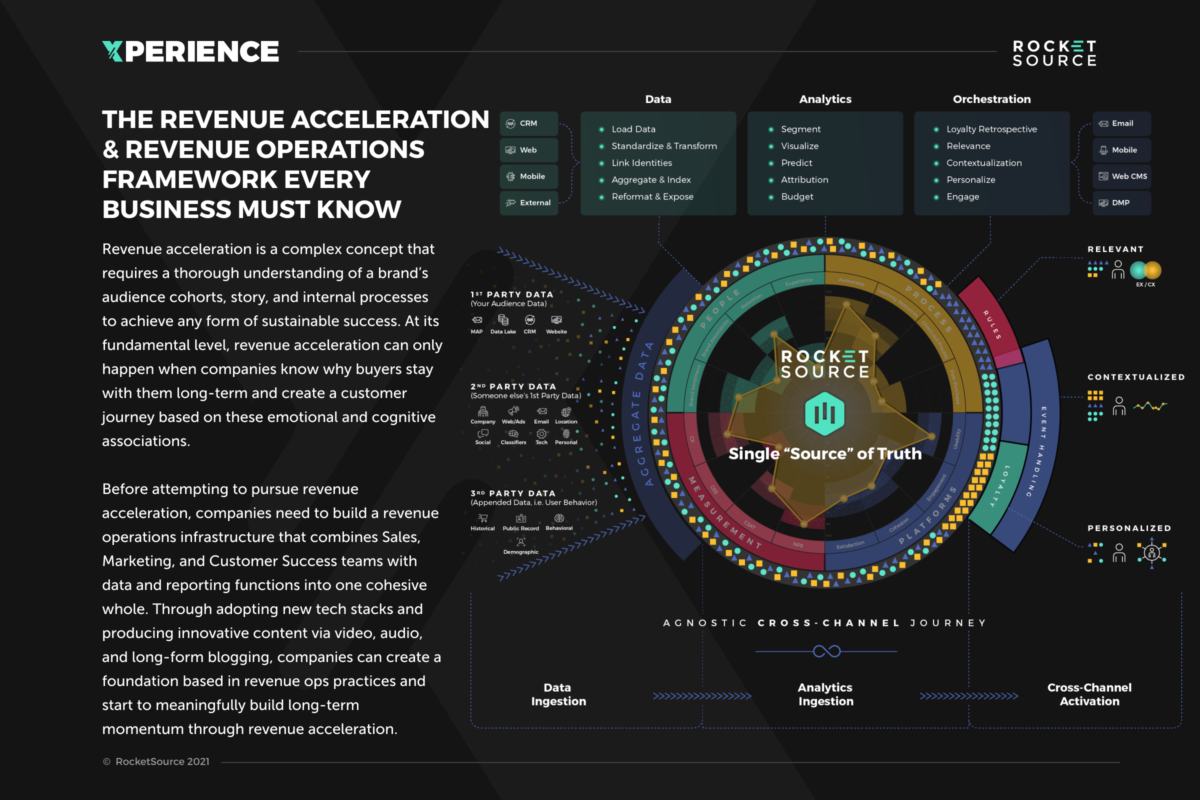

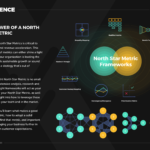



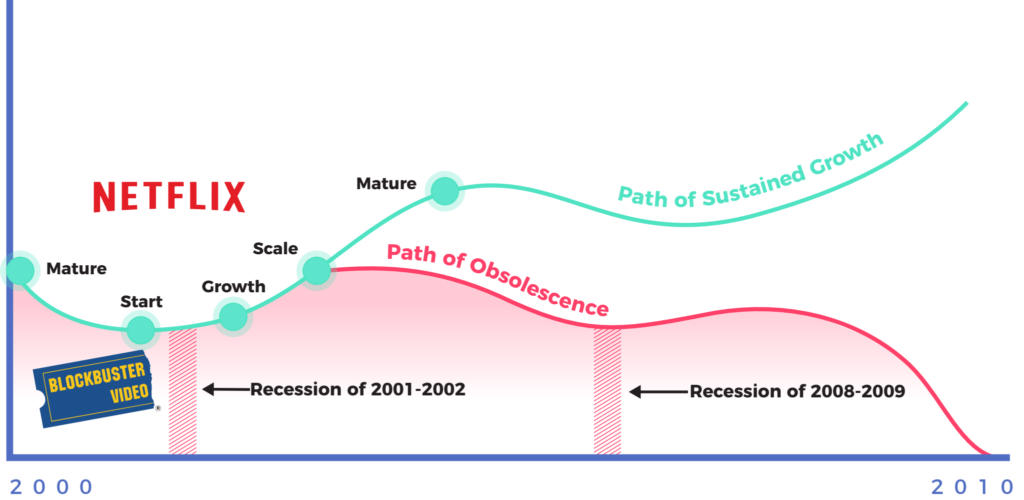
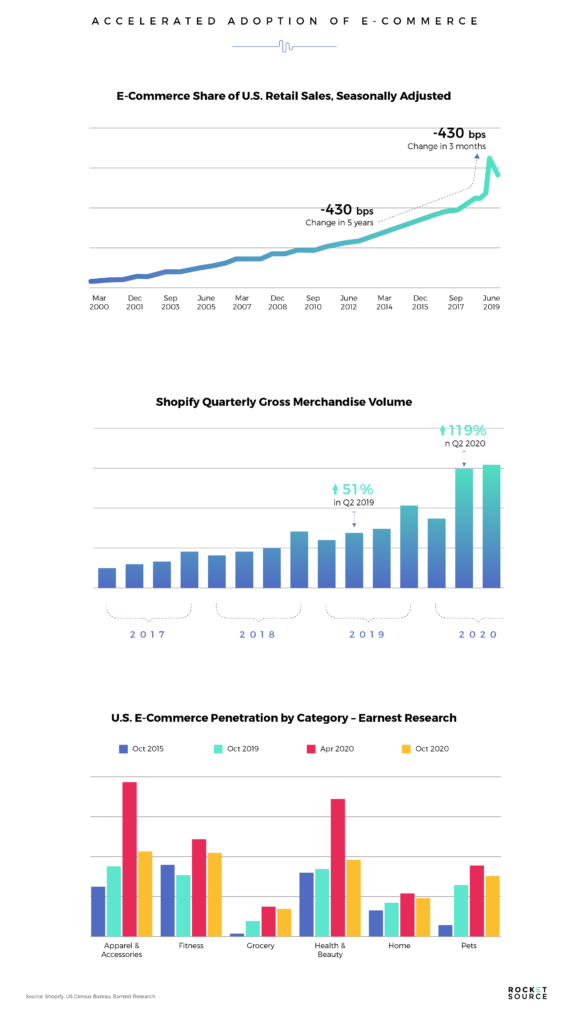
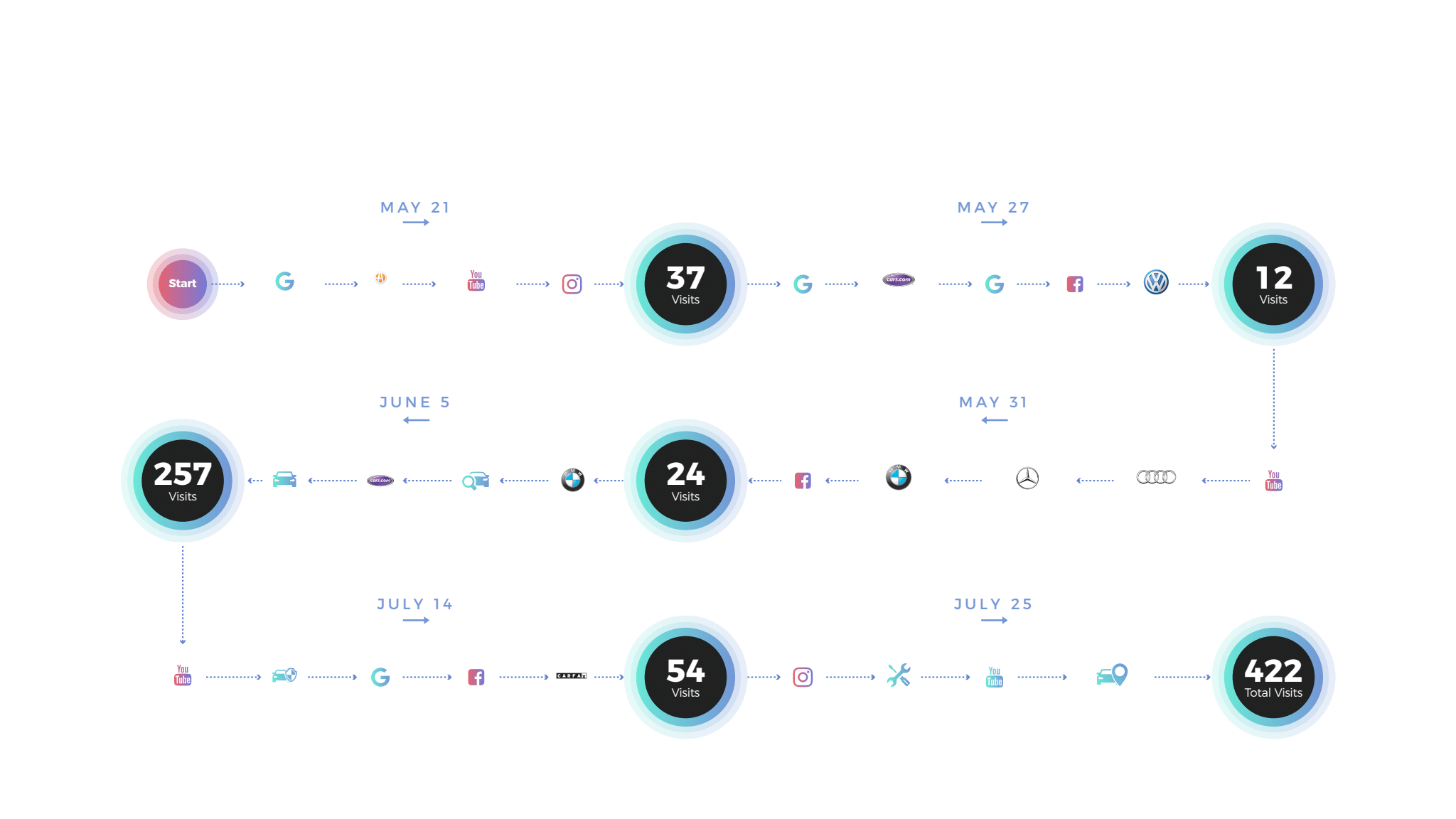

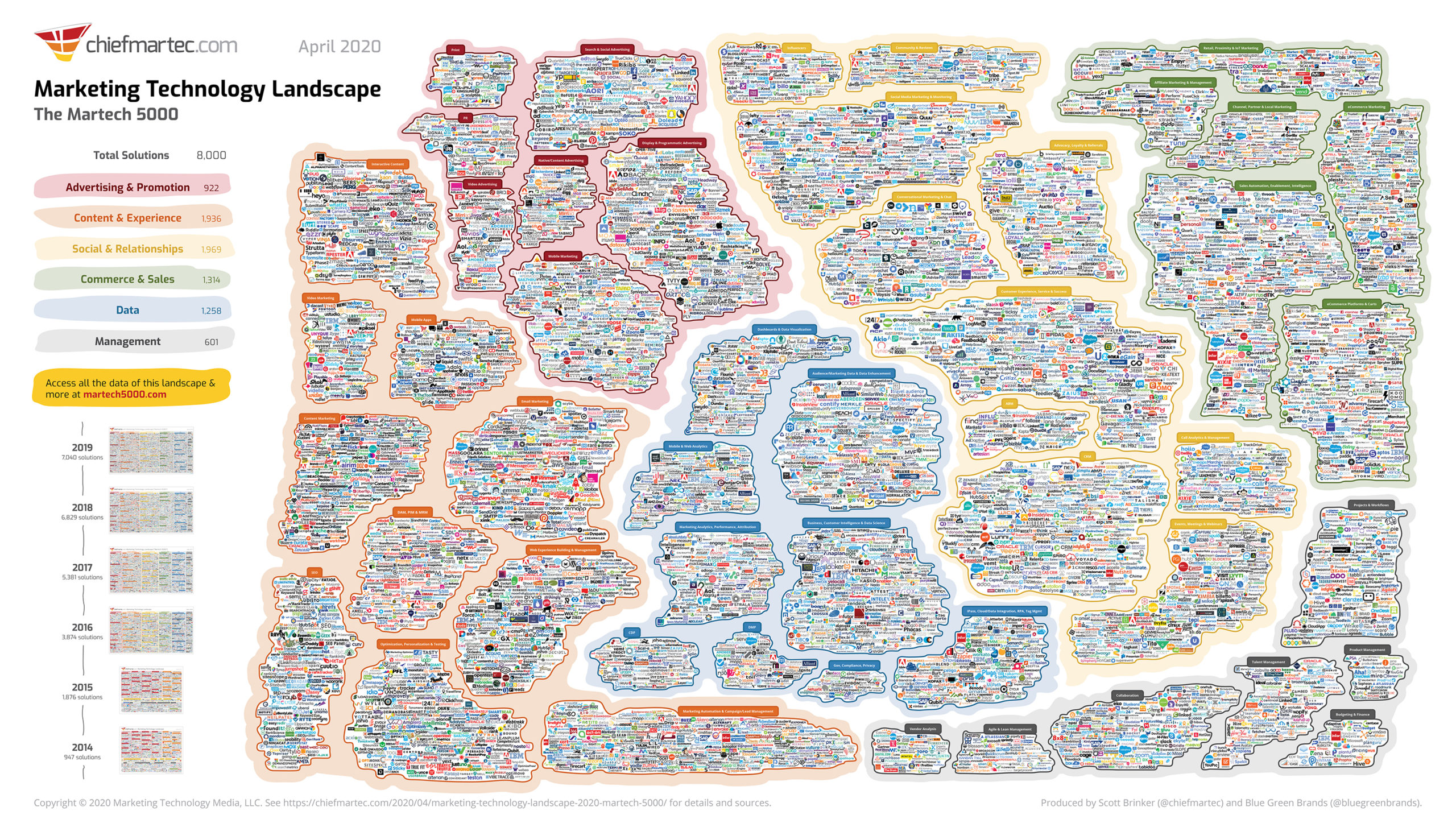
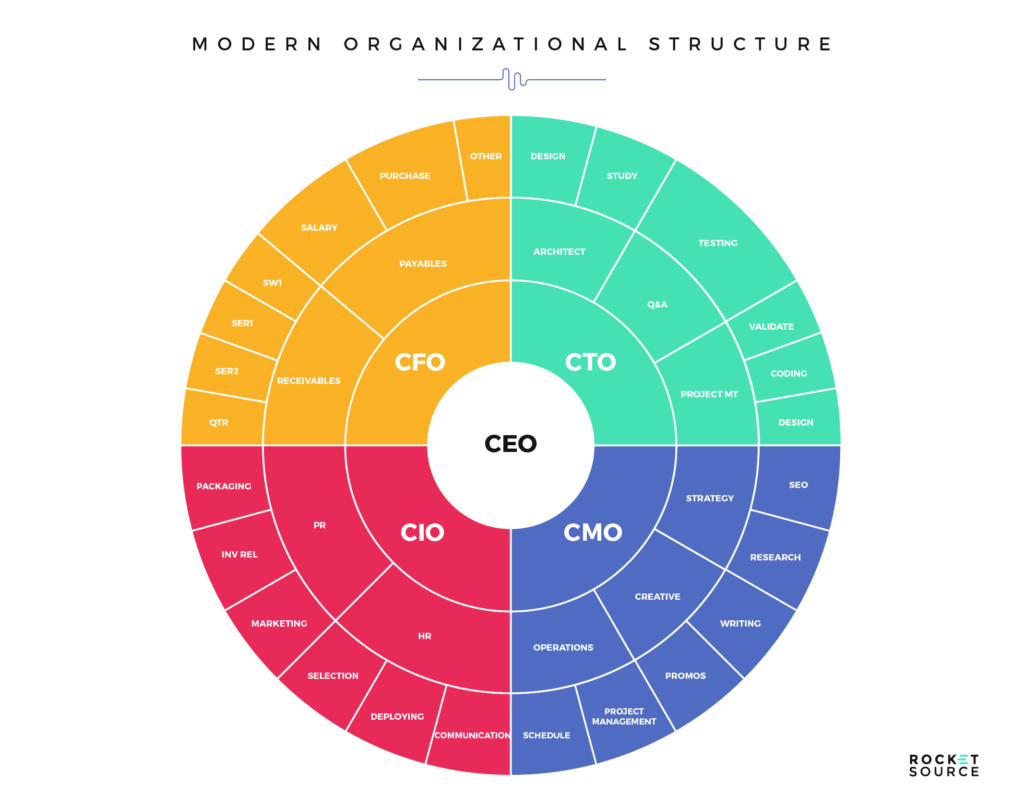
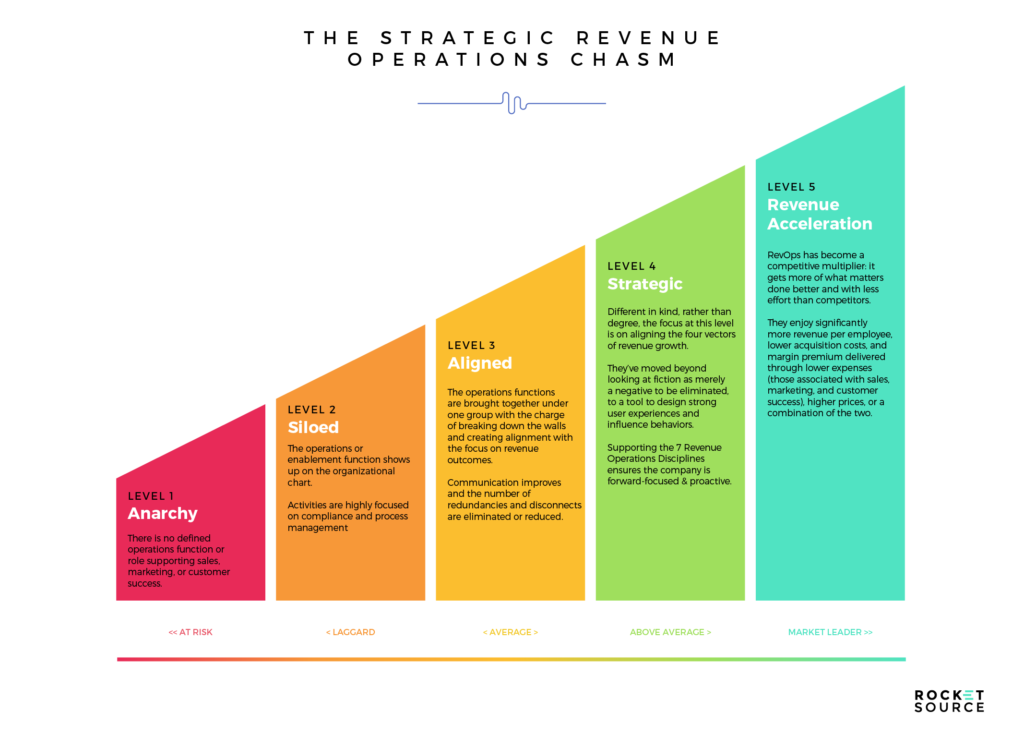
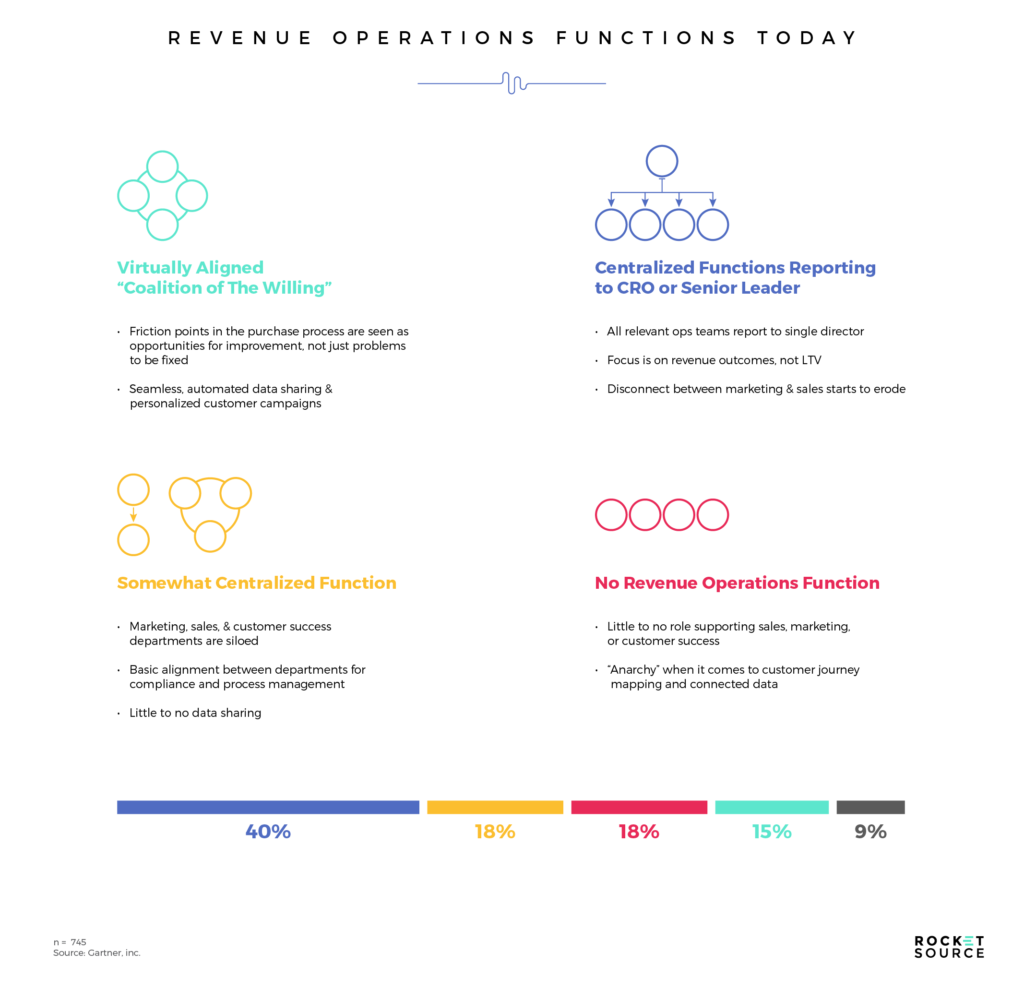
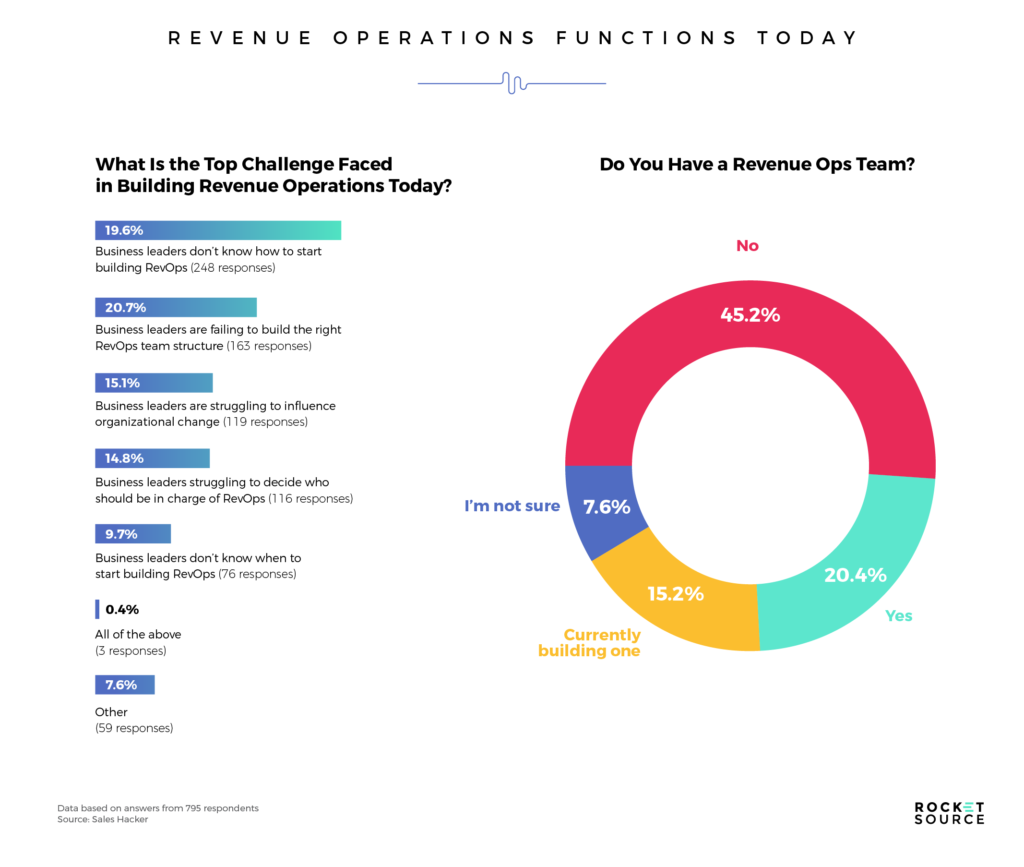
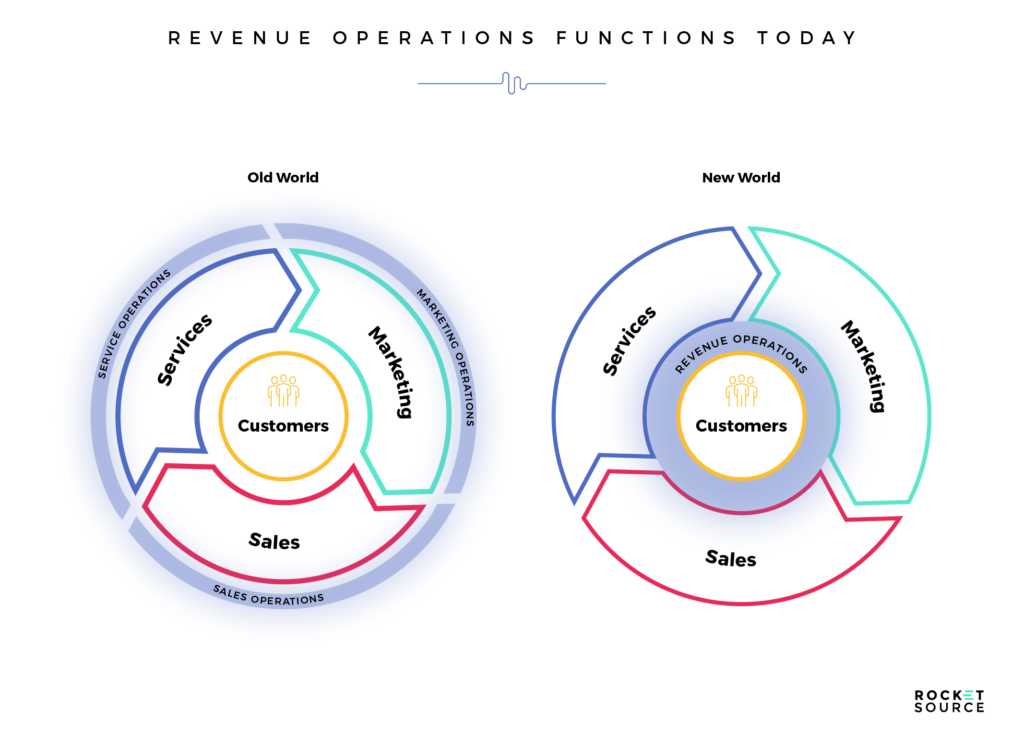
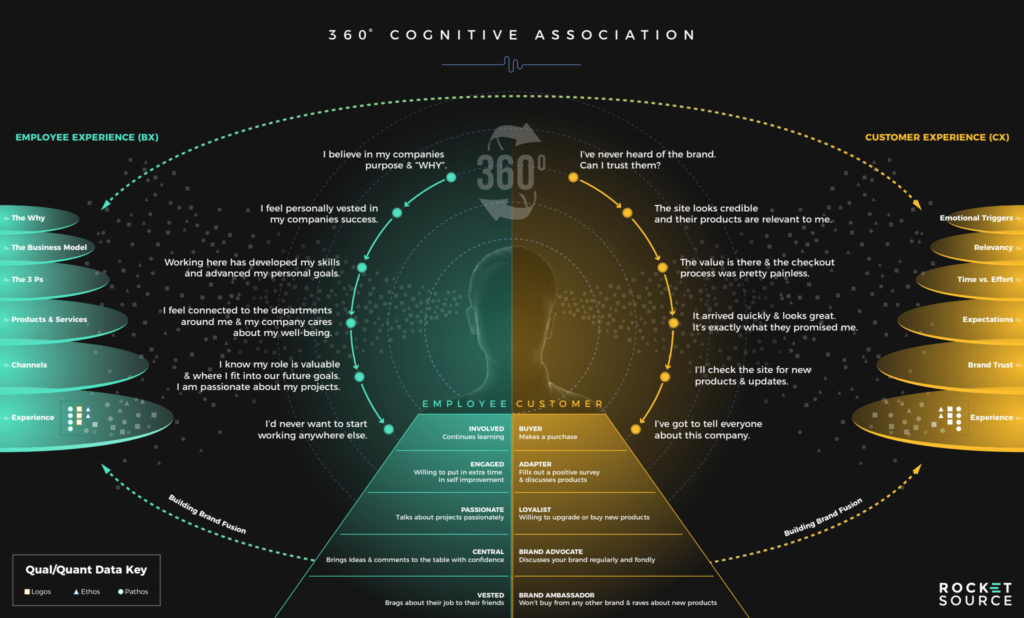
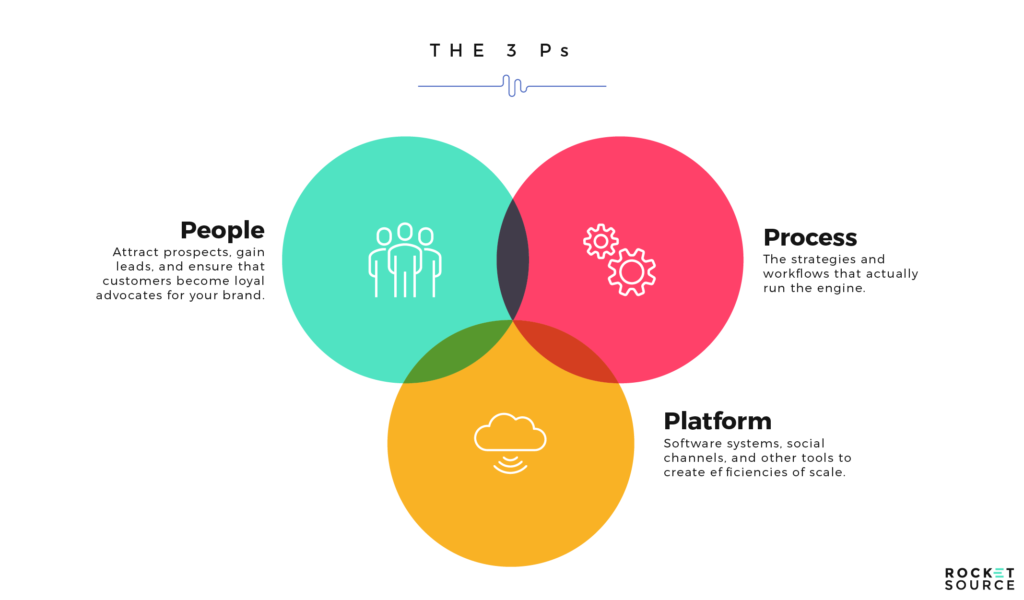

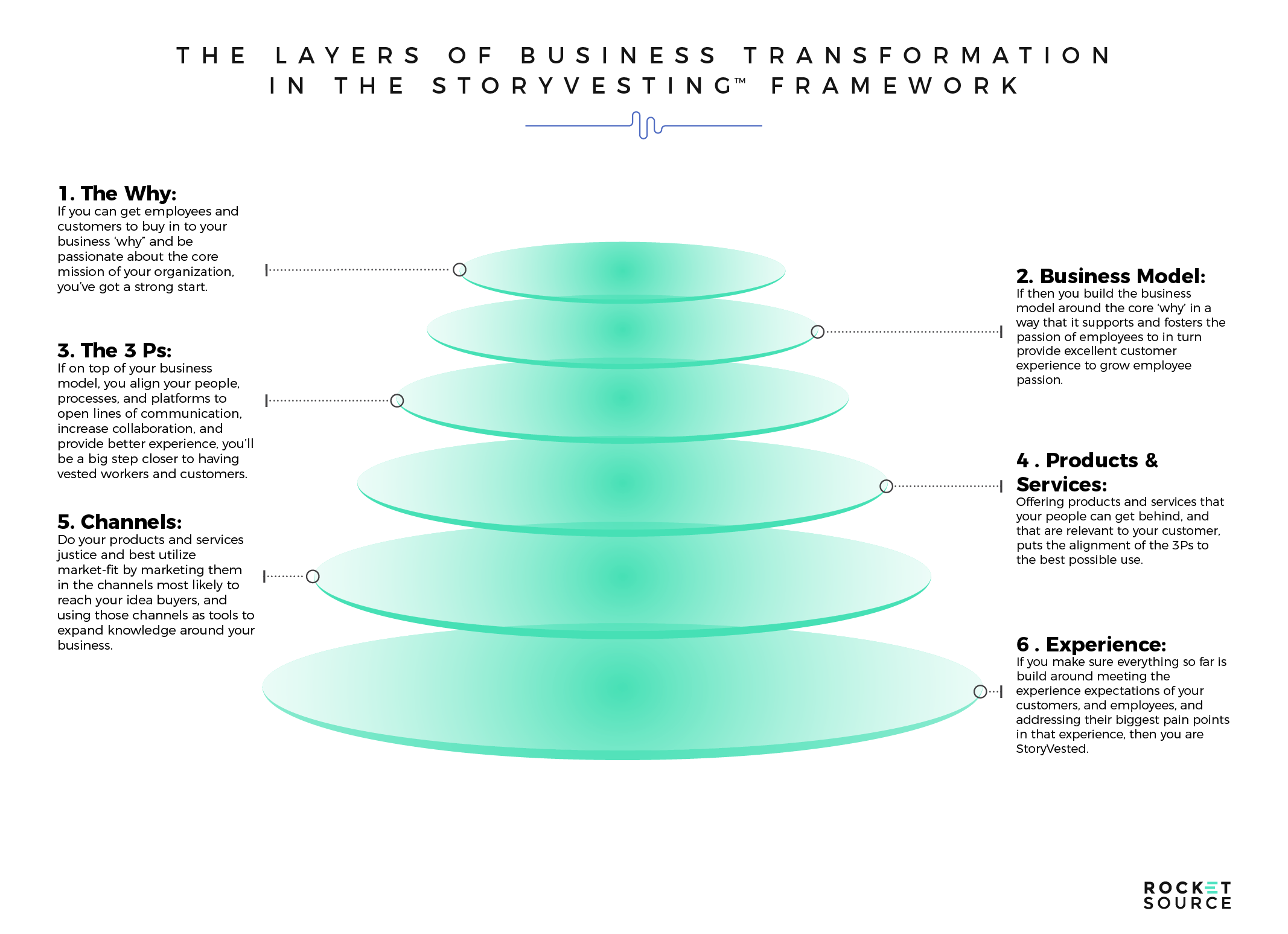
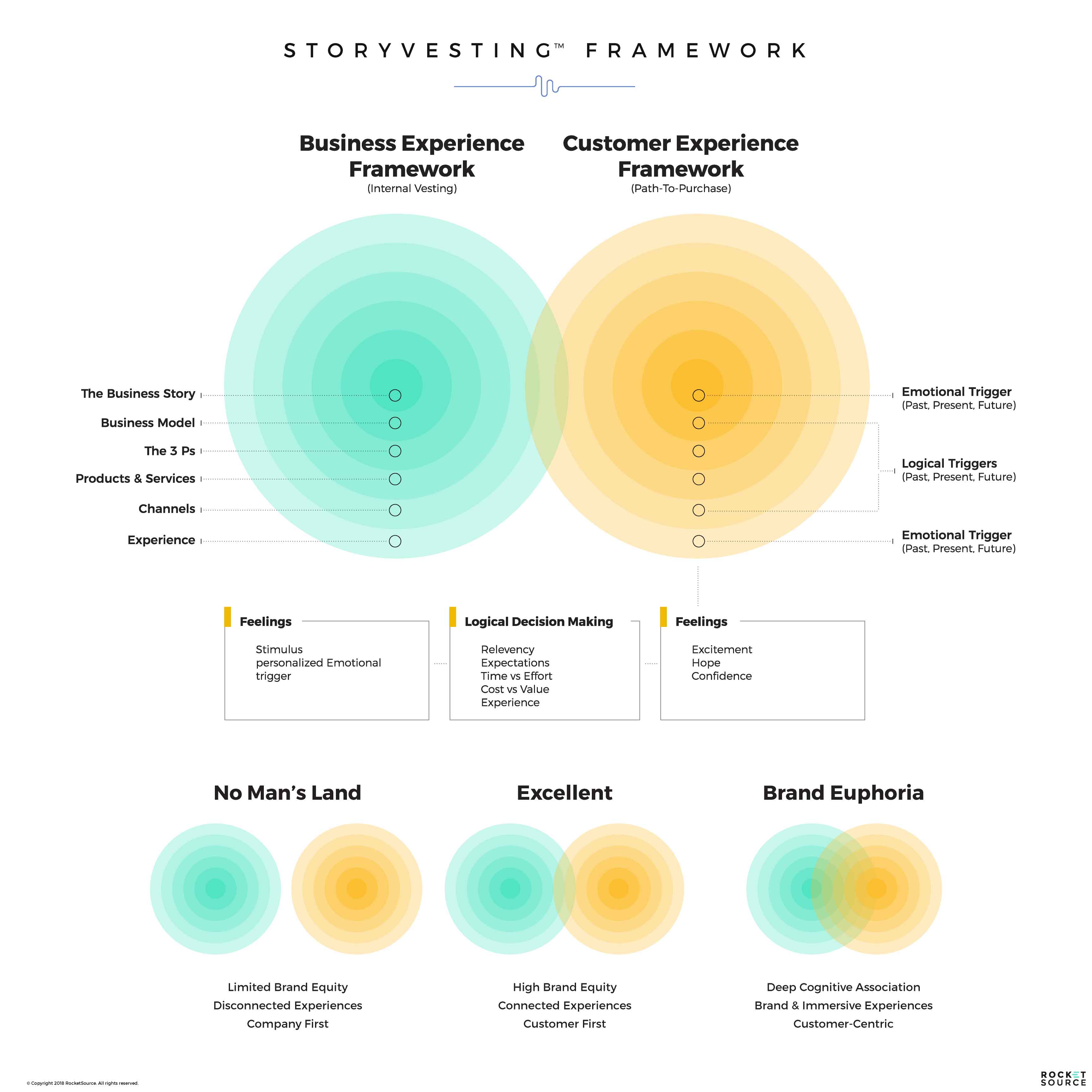
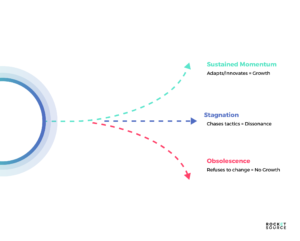
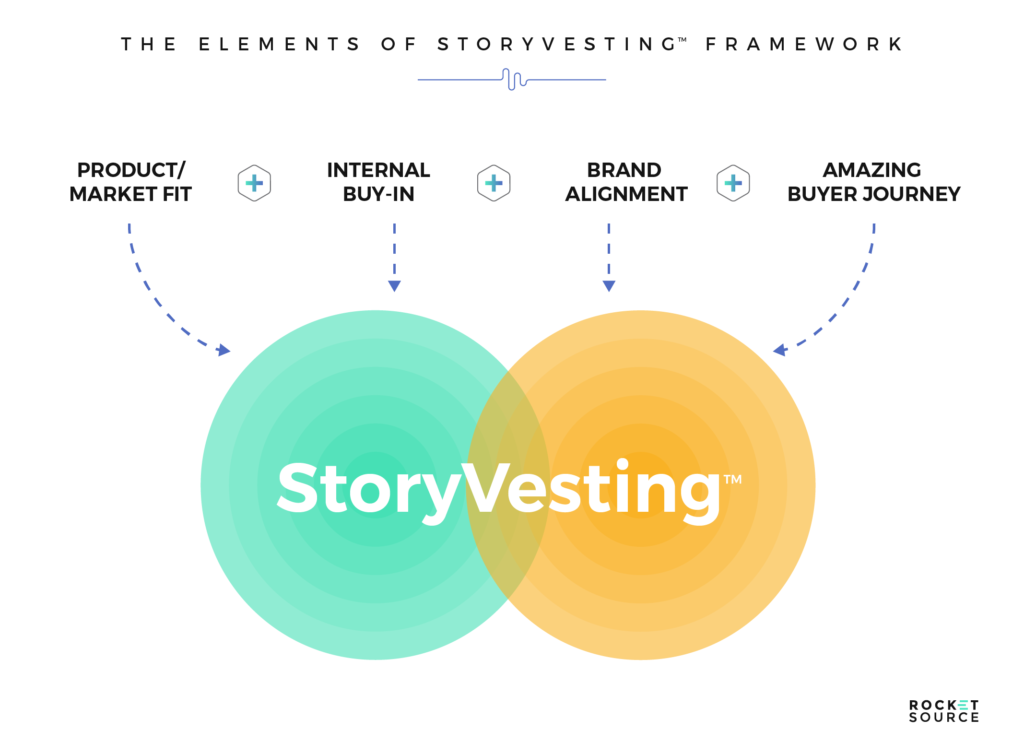
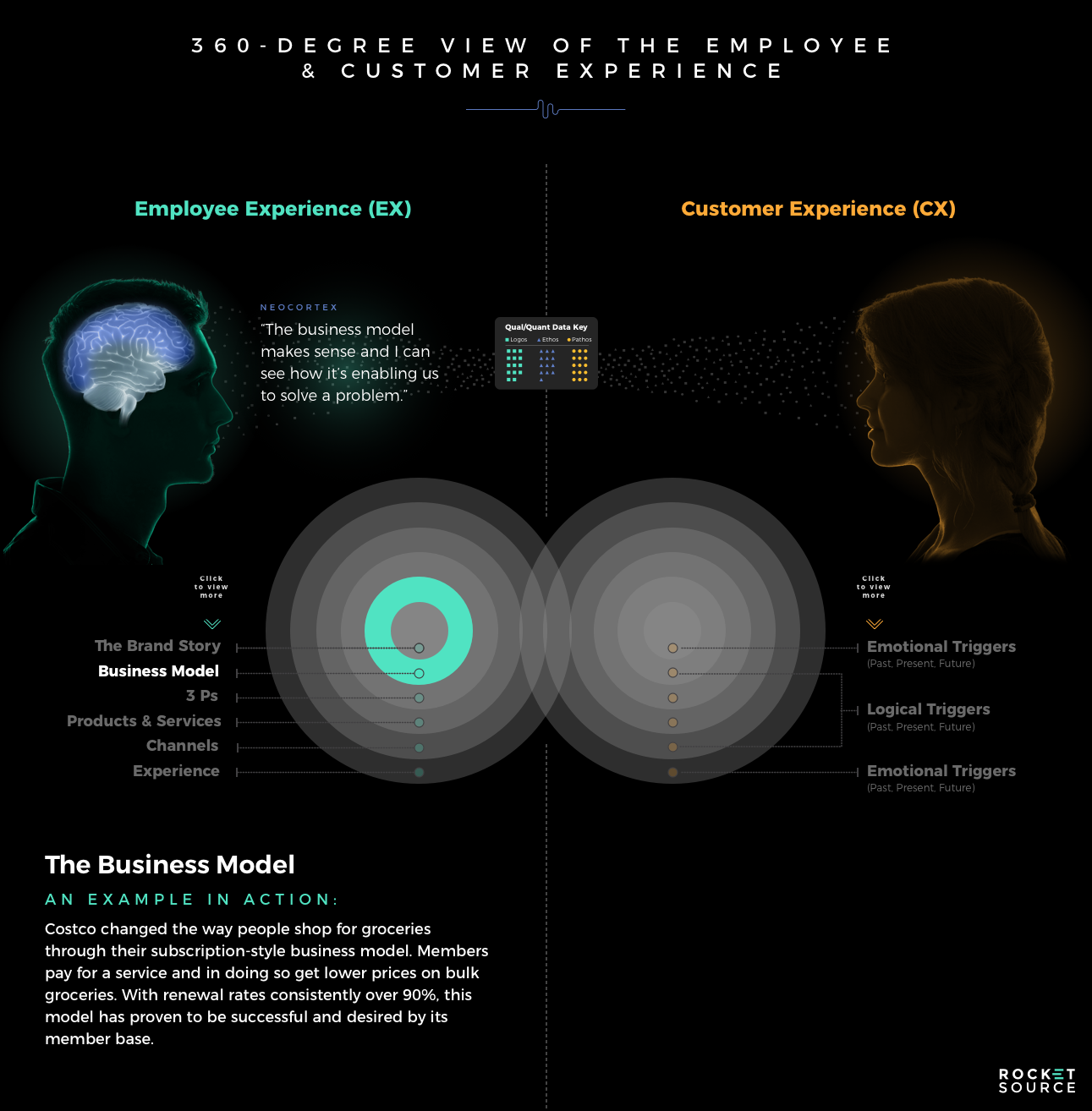

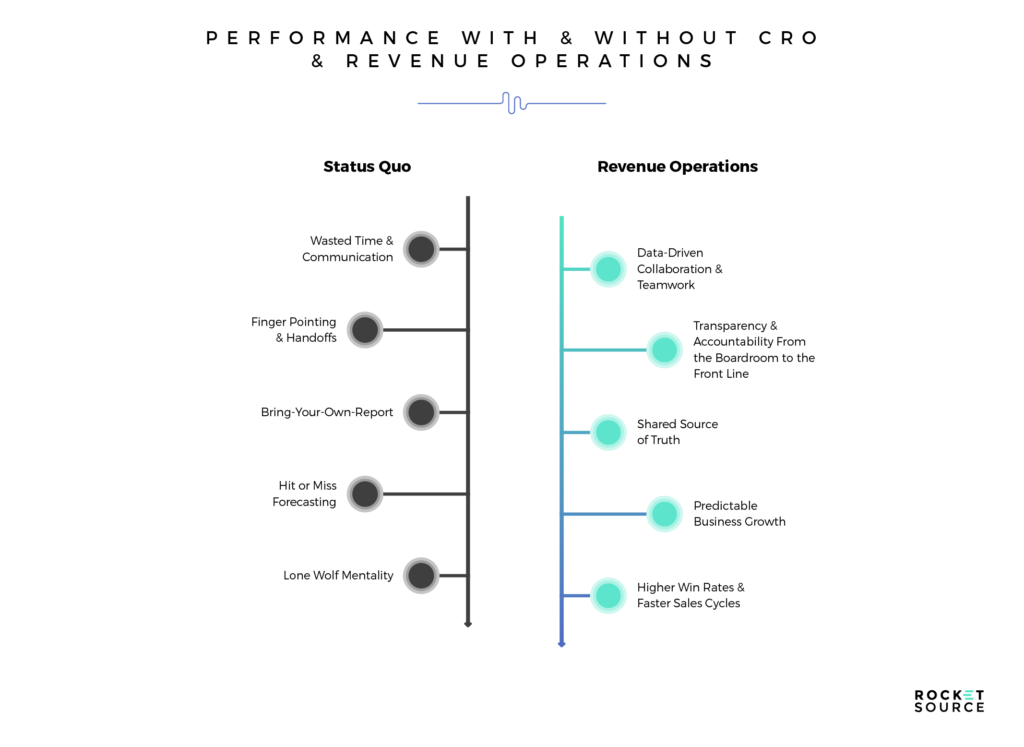
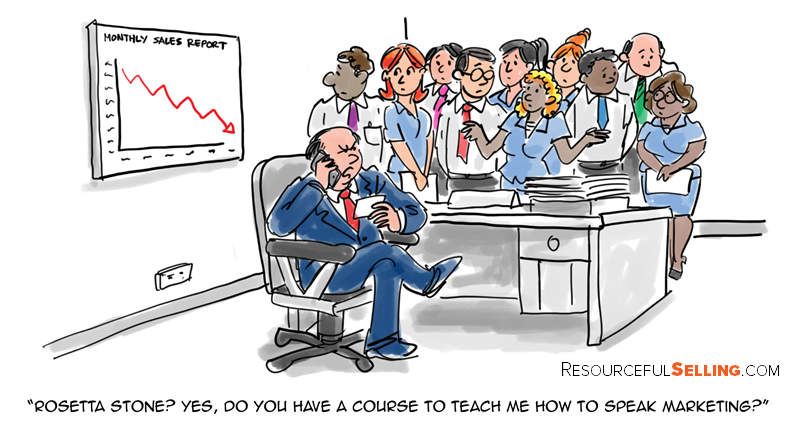
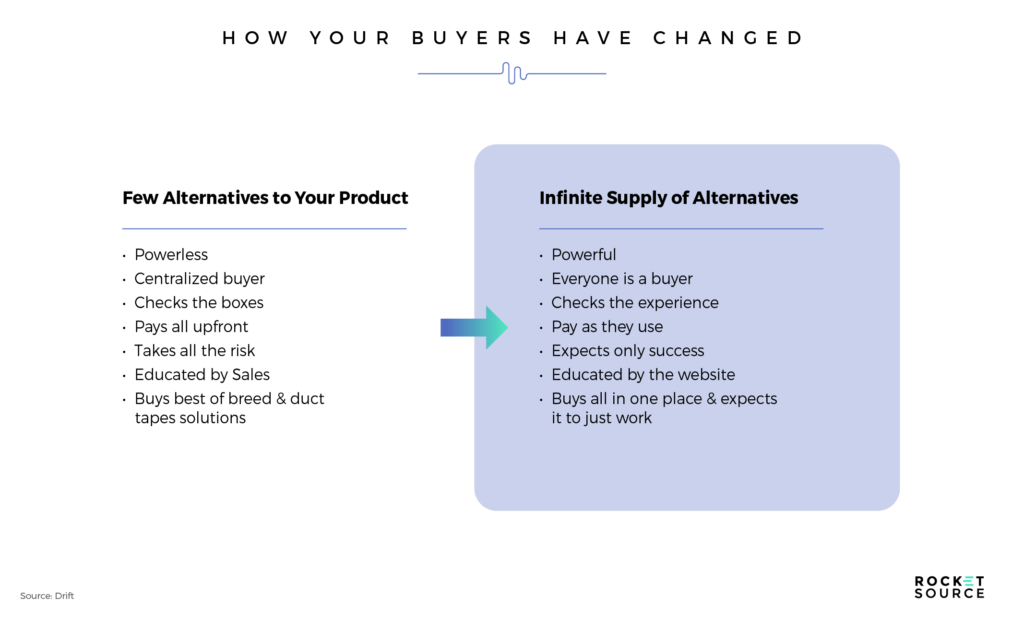
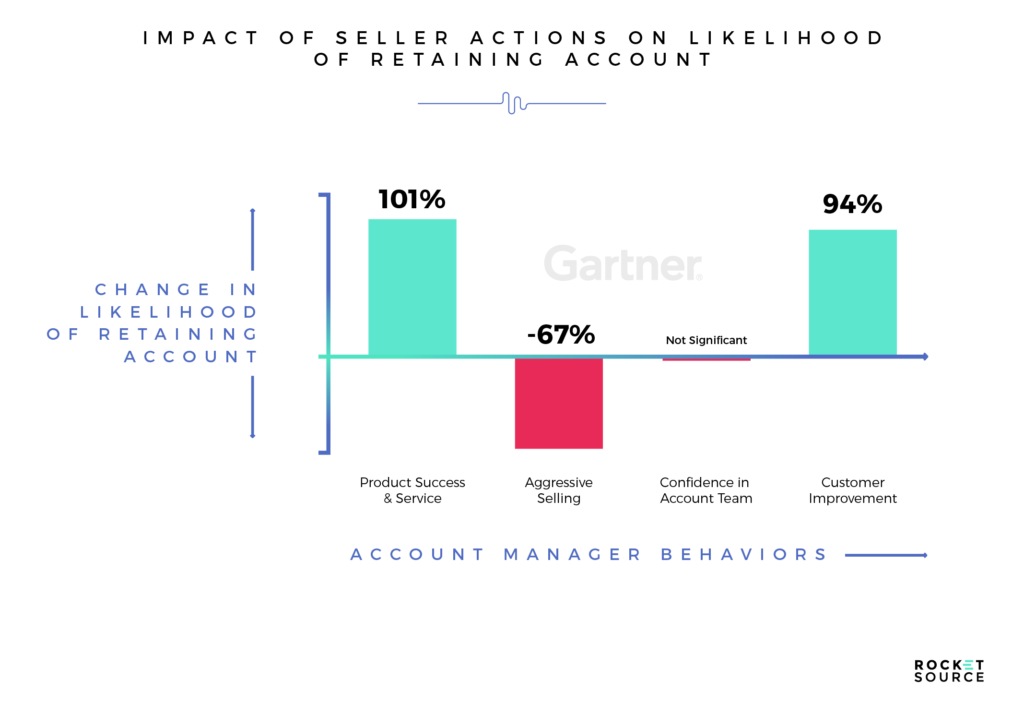


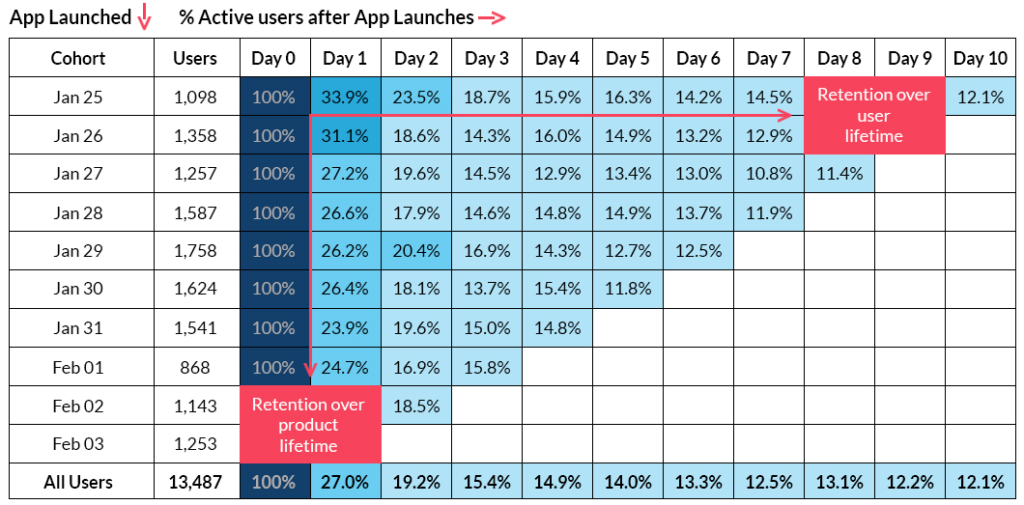

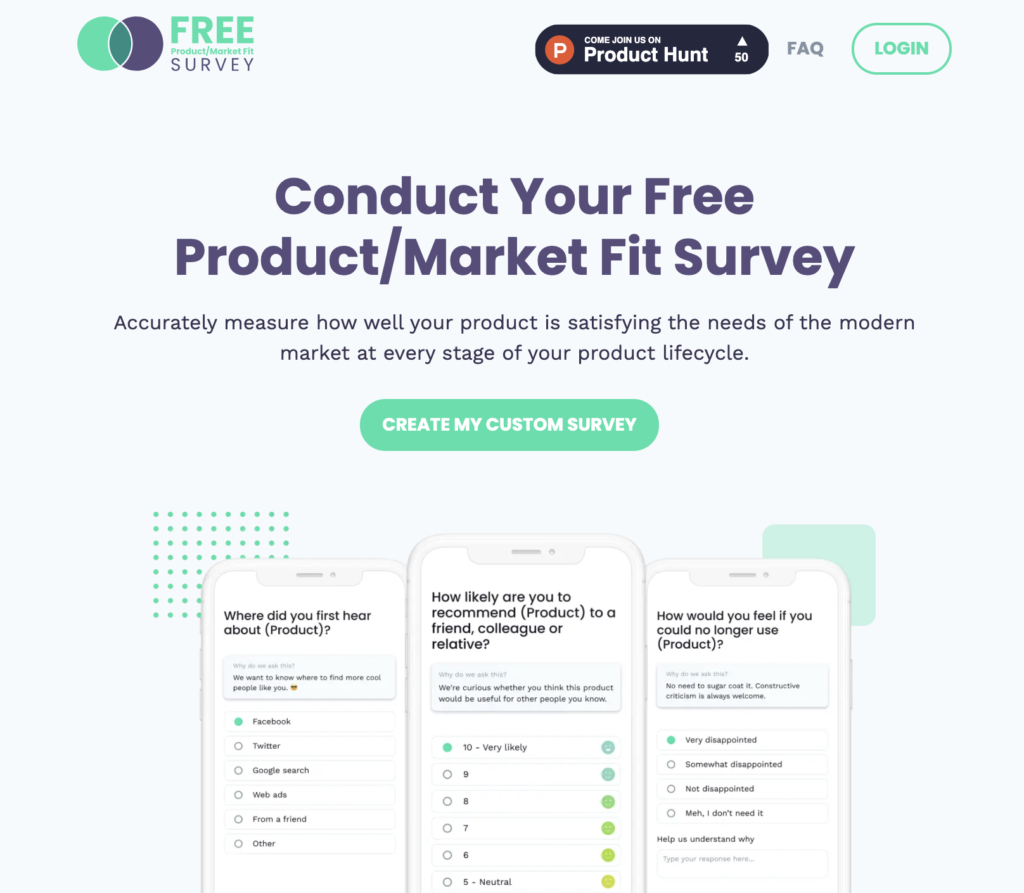
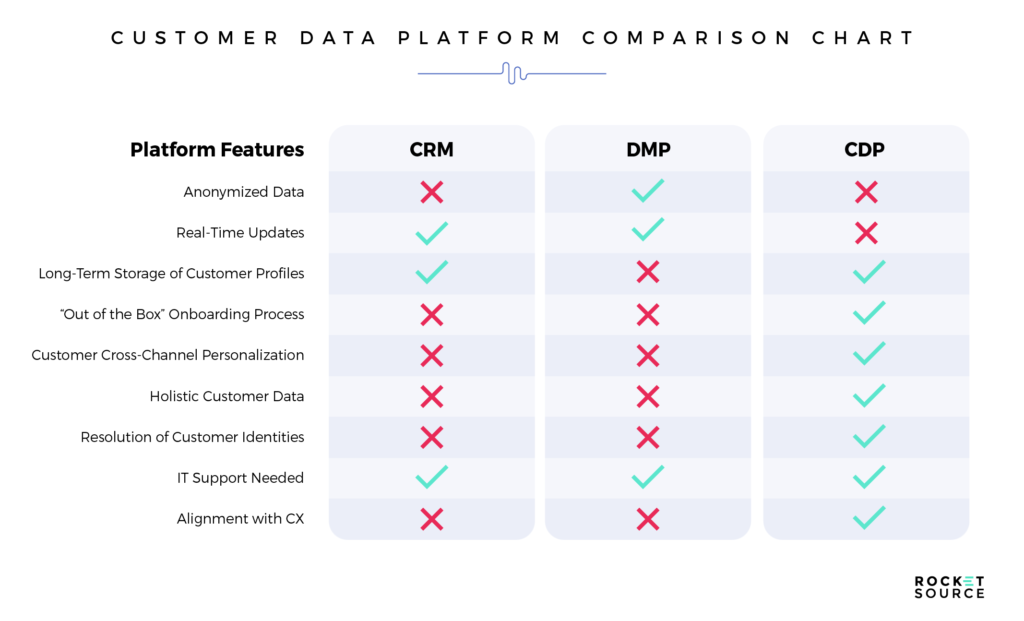
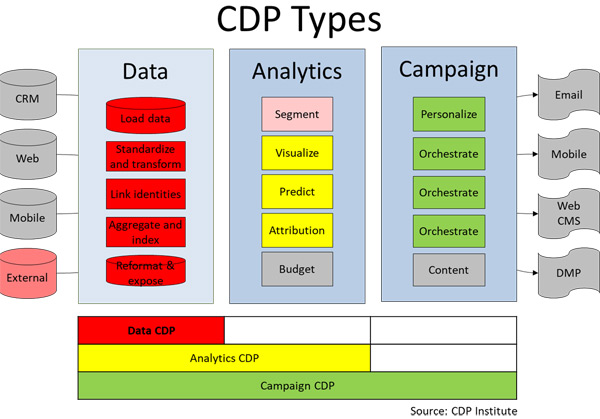
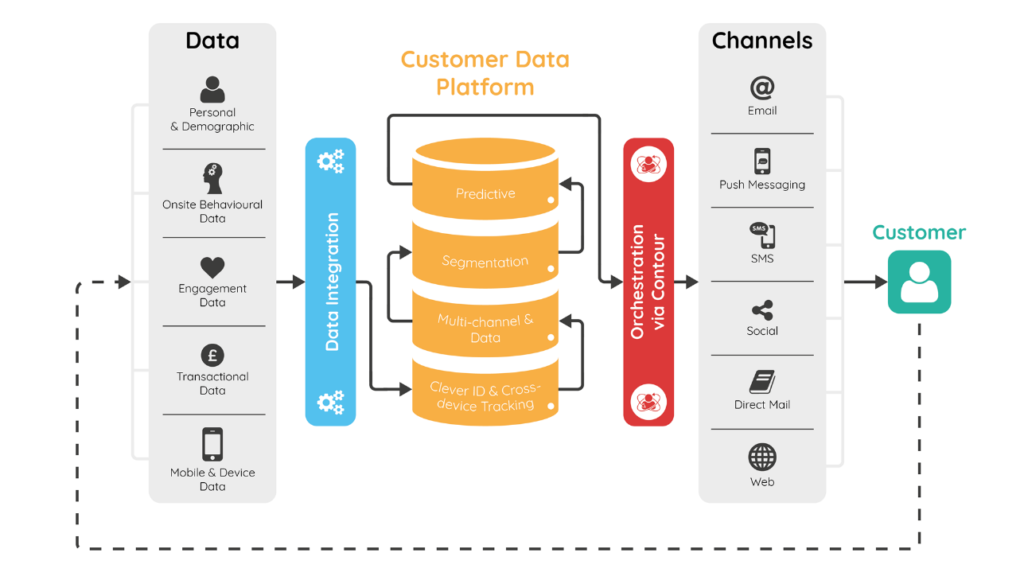
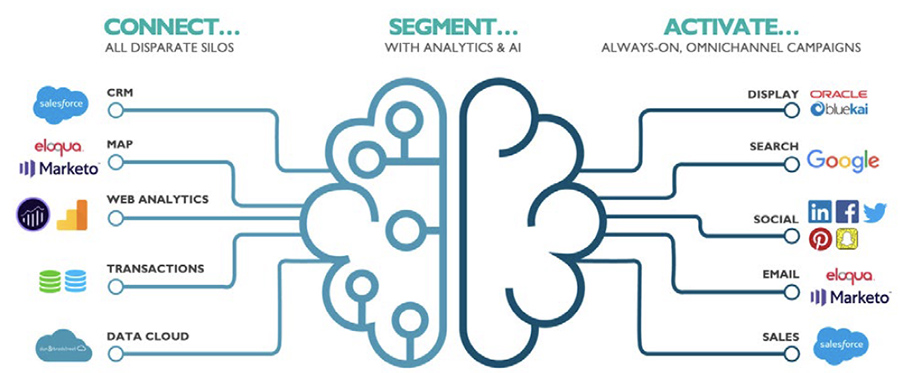
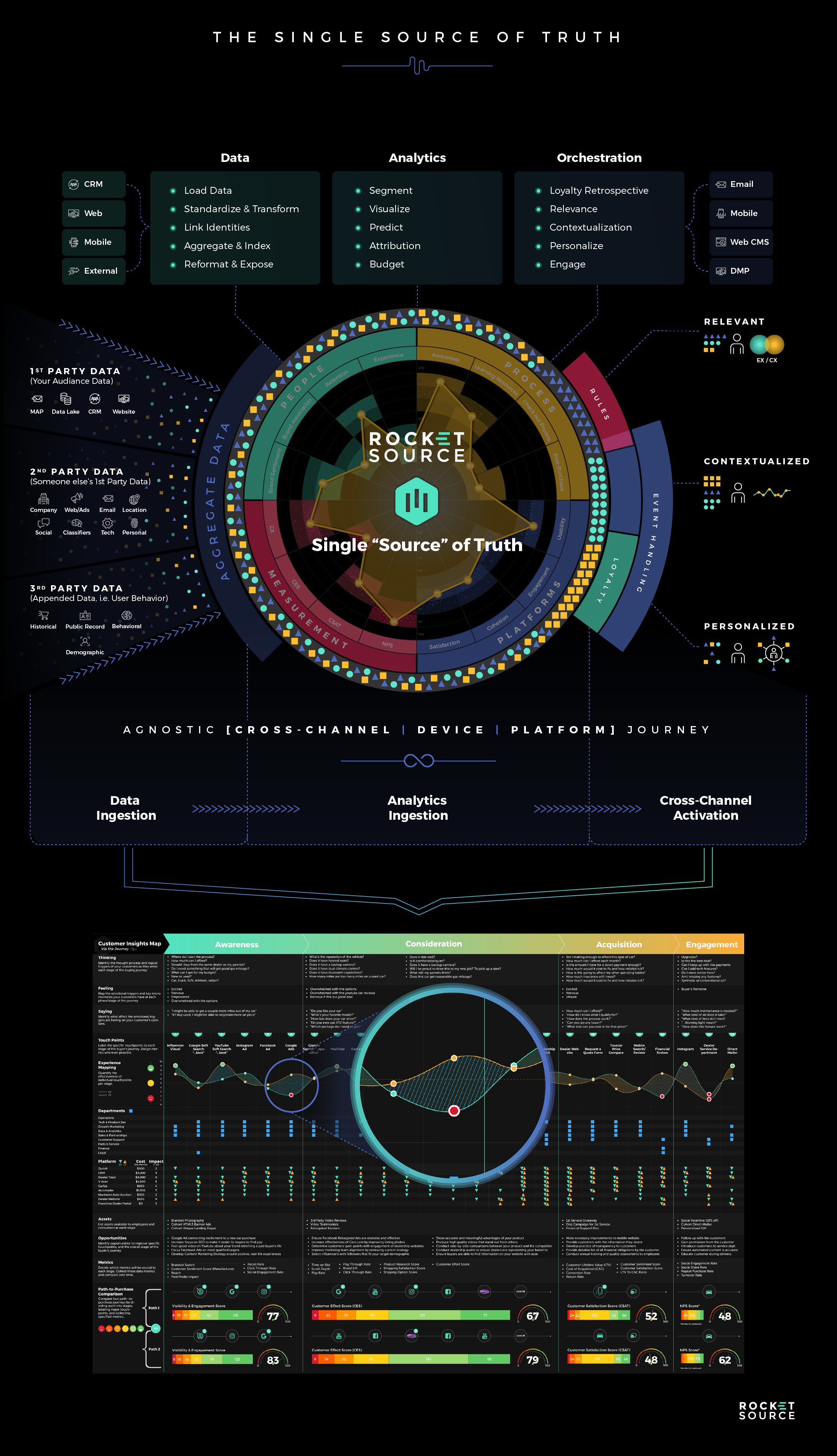
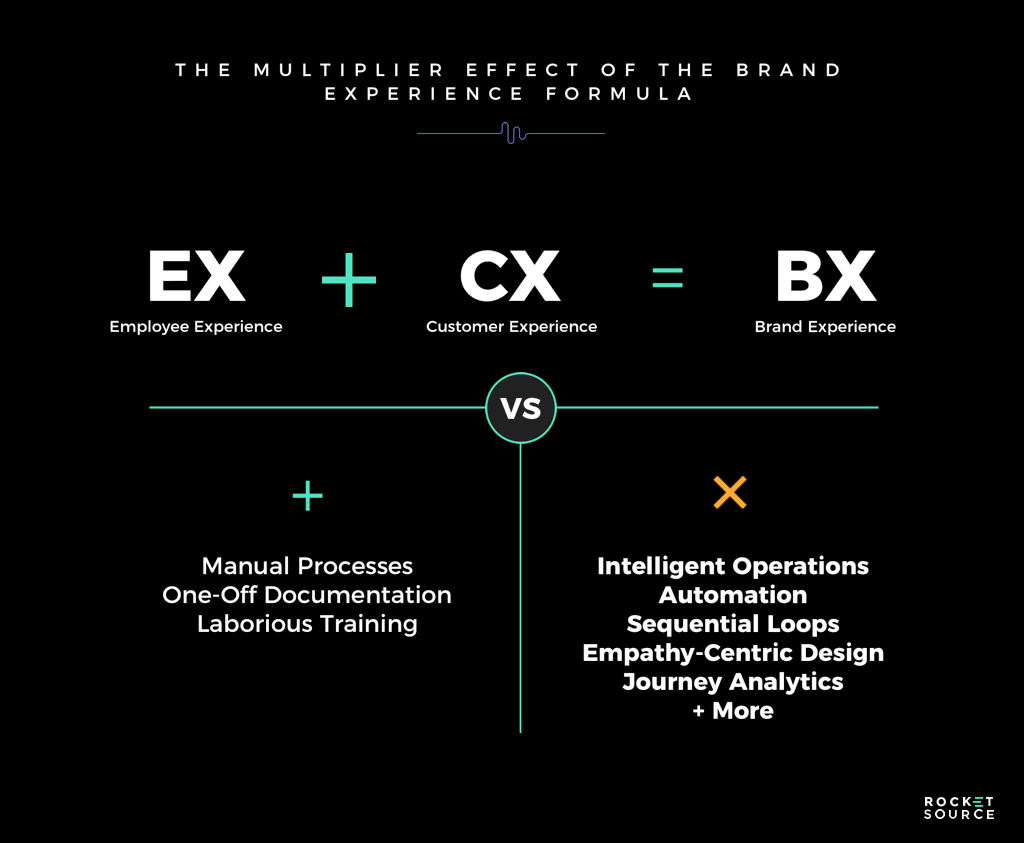

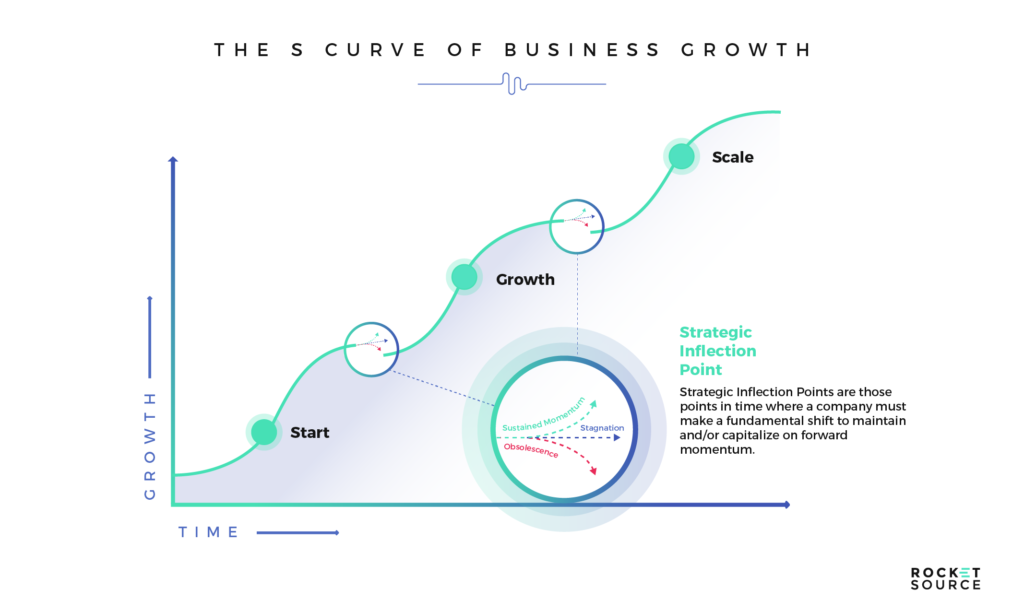
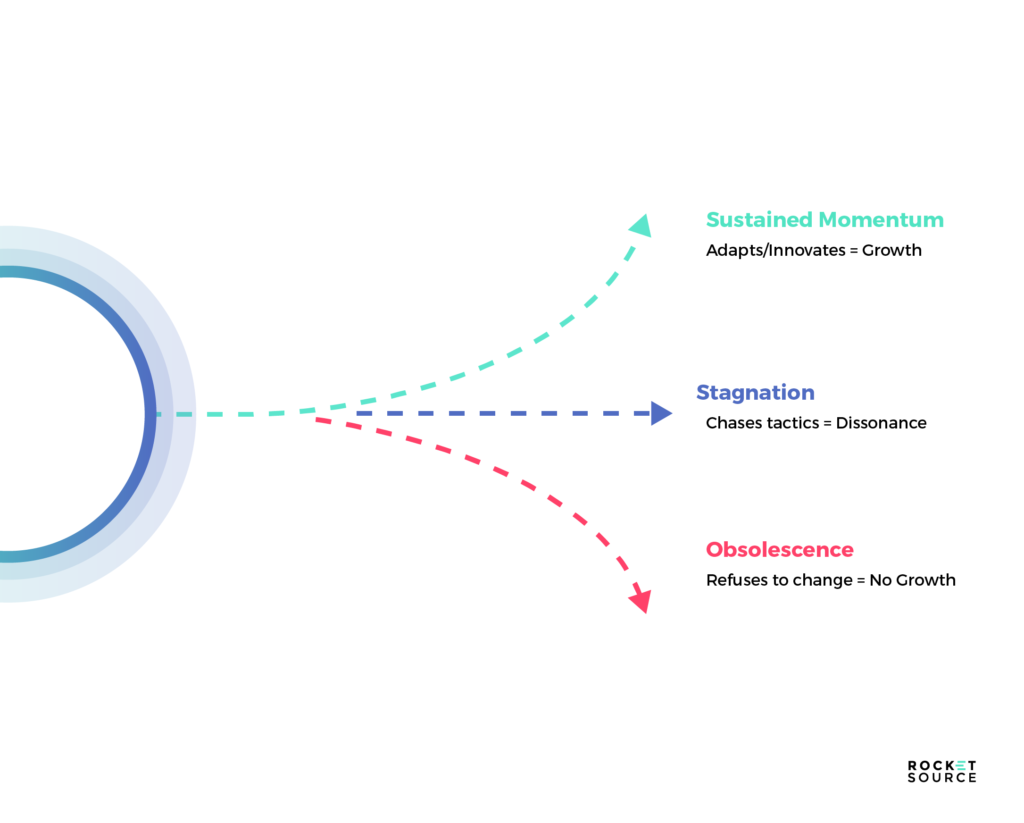
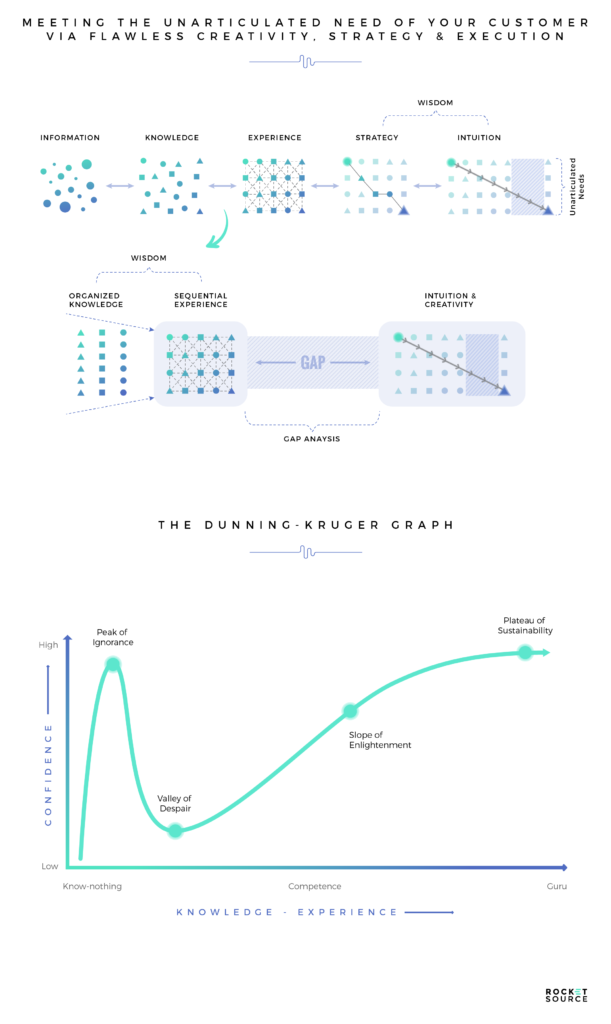

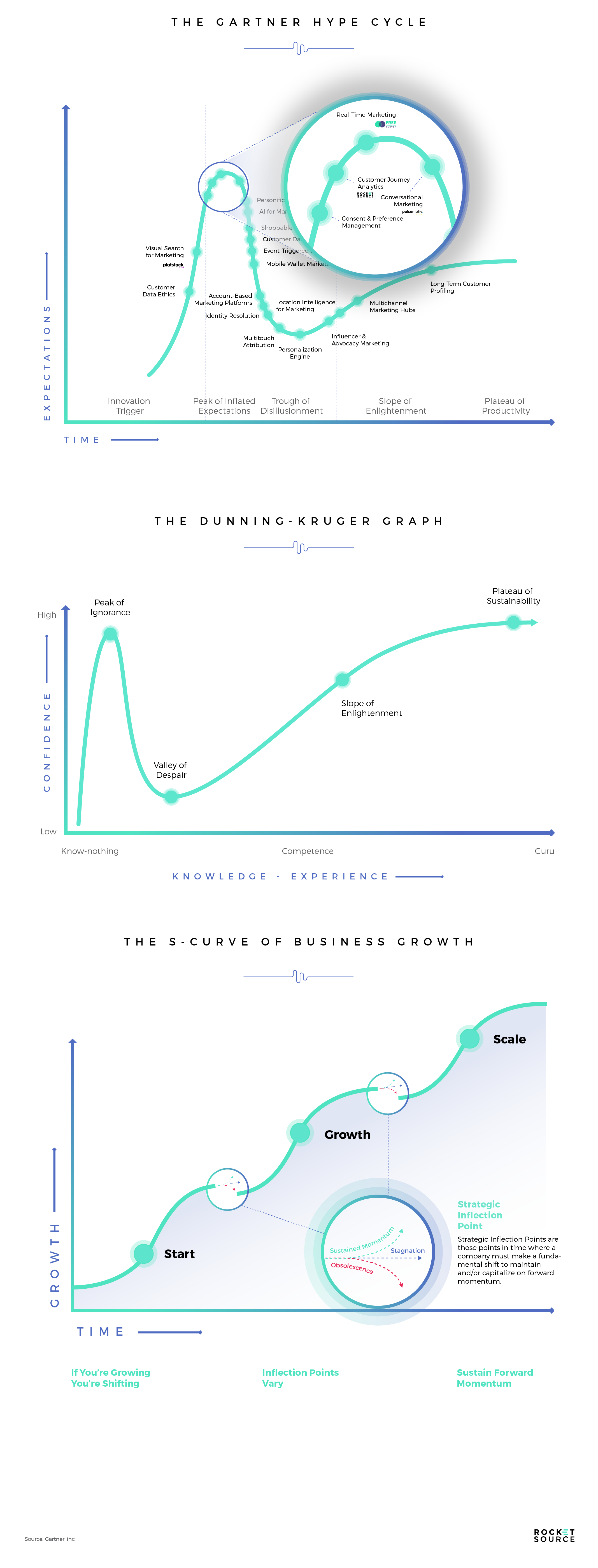
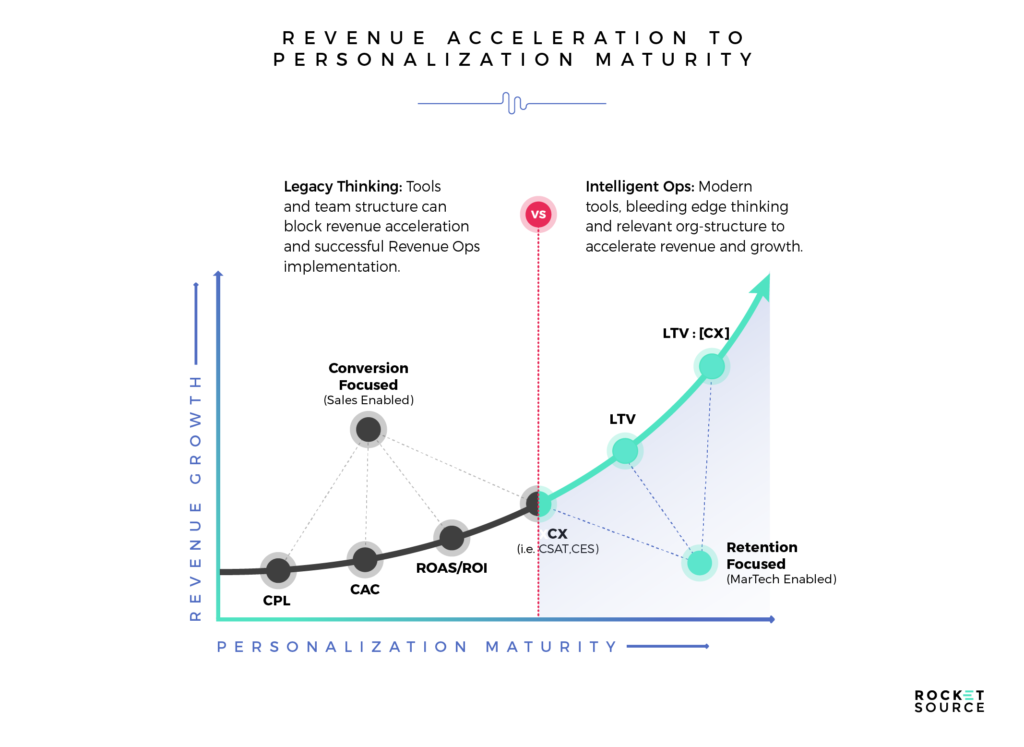
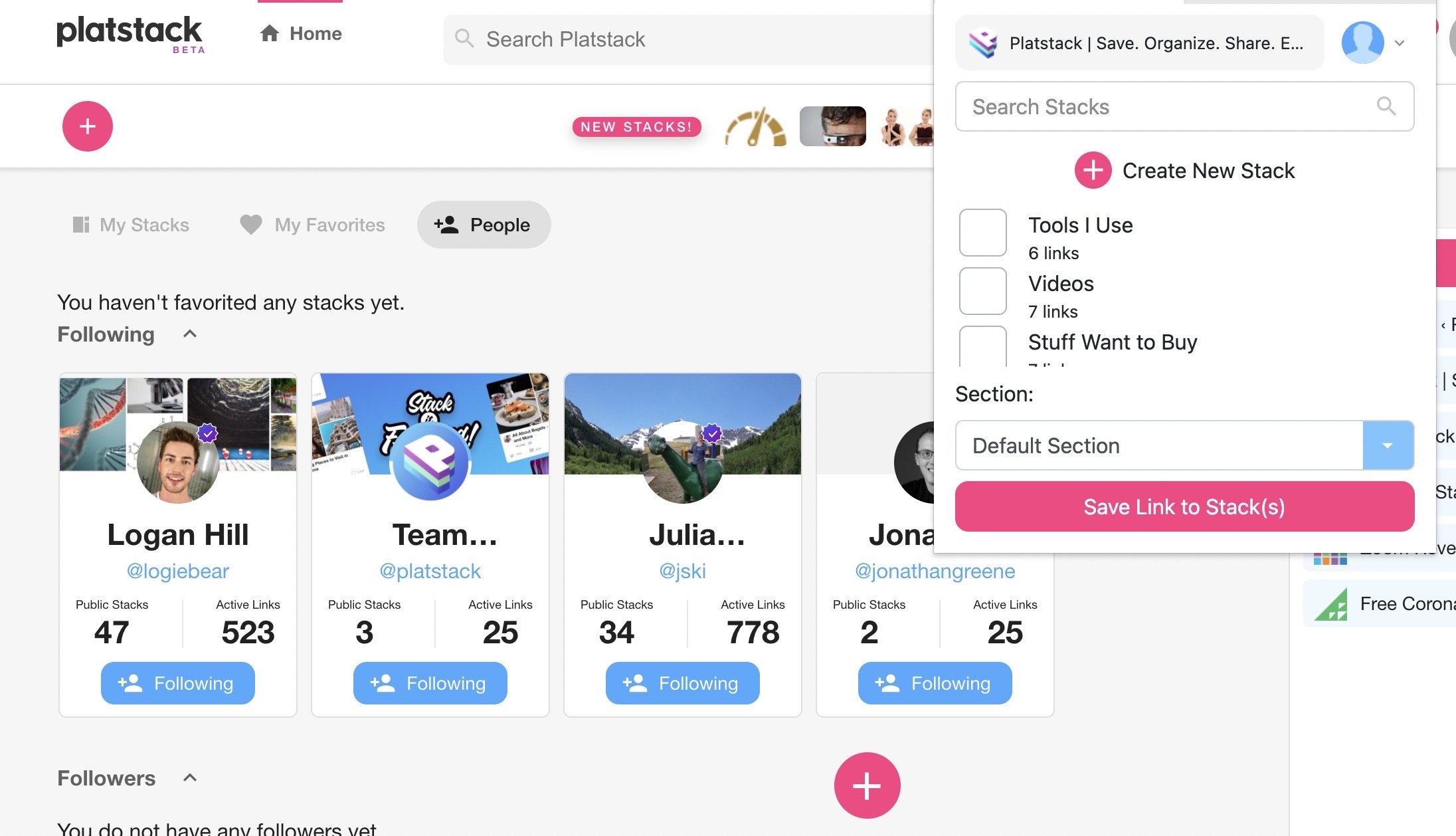
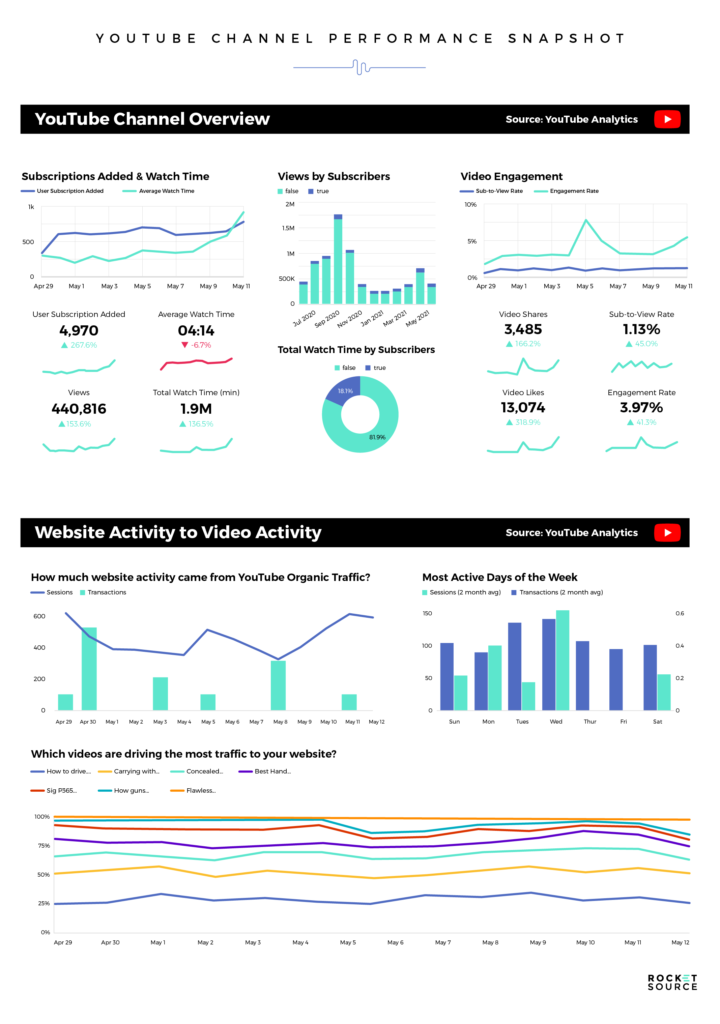


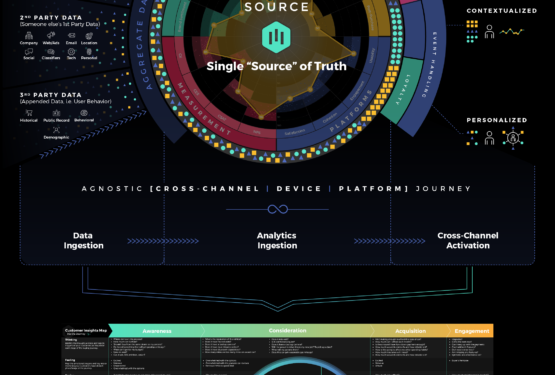
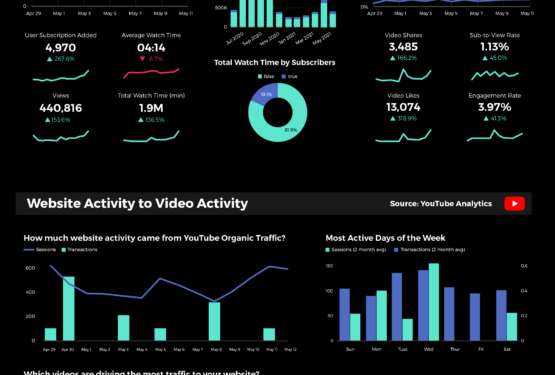
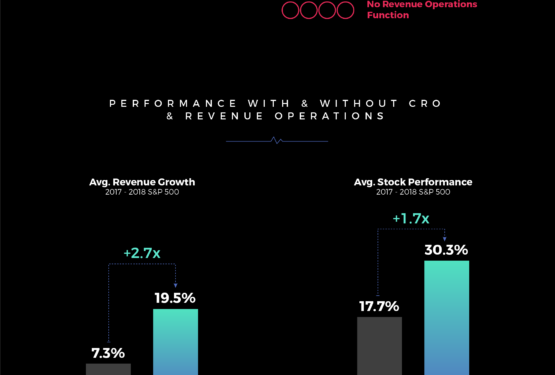
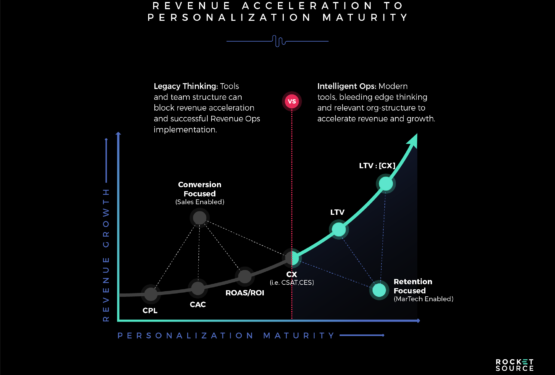
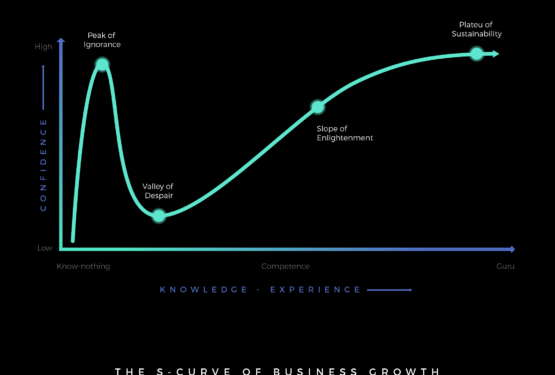
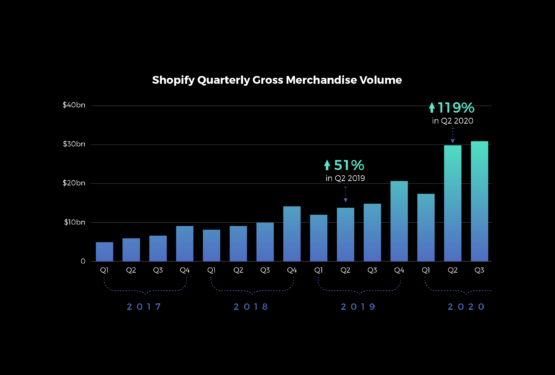
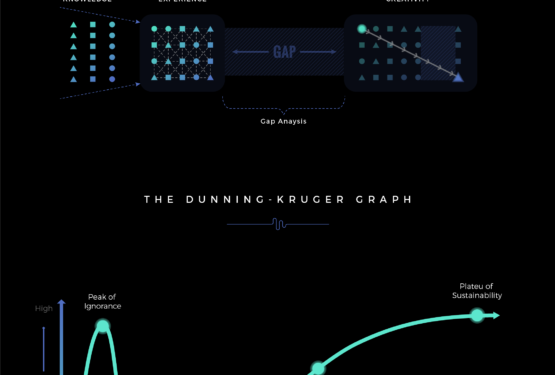
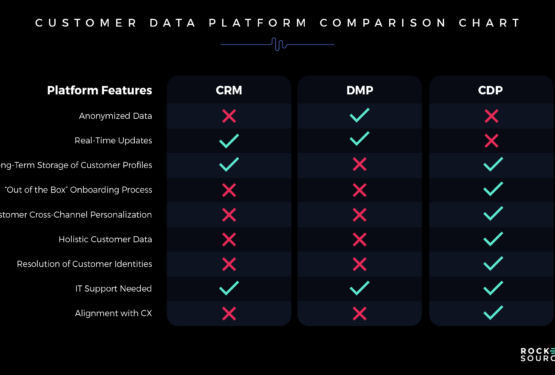
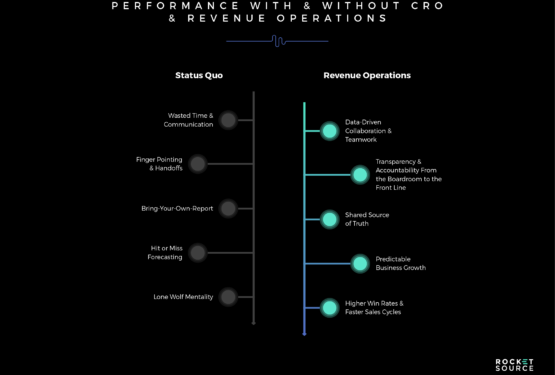
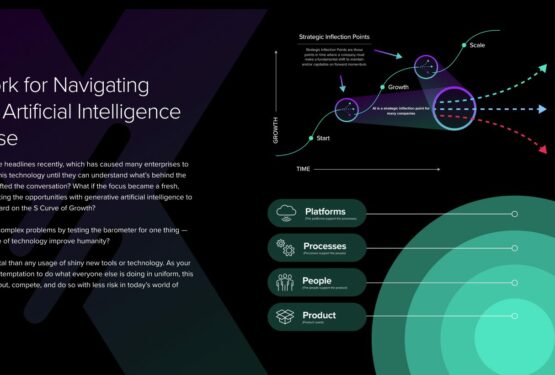
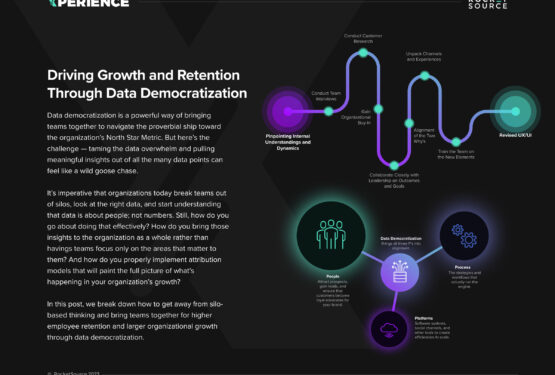
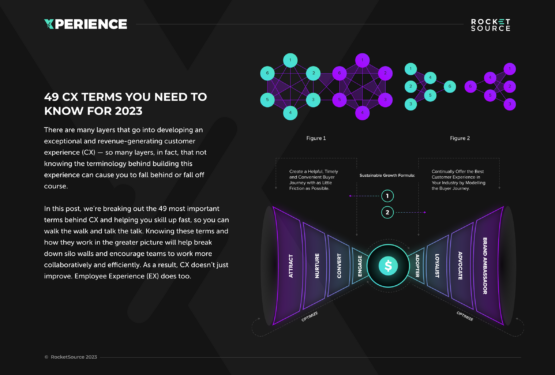
There is no silver bullet that can get brands to revenue acceleration. Instead, companies have to build a strong revenue operations infrastructure based on empathetic customer experience initiatives, intelligent data ops, and innovative content generation. Once you start with the end in mind, your organization can get to a sustainable — and much more feasible — revenue acceleration solution.
Founder/Executive Chairman | RocketSource